- BOAT OF THE YEAR
- Newsletters
- Sailboat Reviews
- Boating Safety
- Sailing Totem
- Charter Resources
- Destinations
- Galley Recipes
- Living Aboard
- Sails and Rigging
- Maintenance
- Best Marine Electronics & Technology


Do You Need a Watermaker for Your Sailboat?
- By Jen Brett
- Updated: October 2, 2019
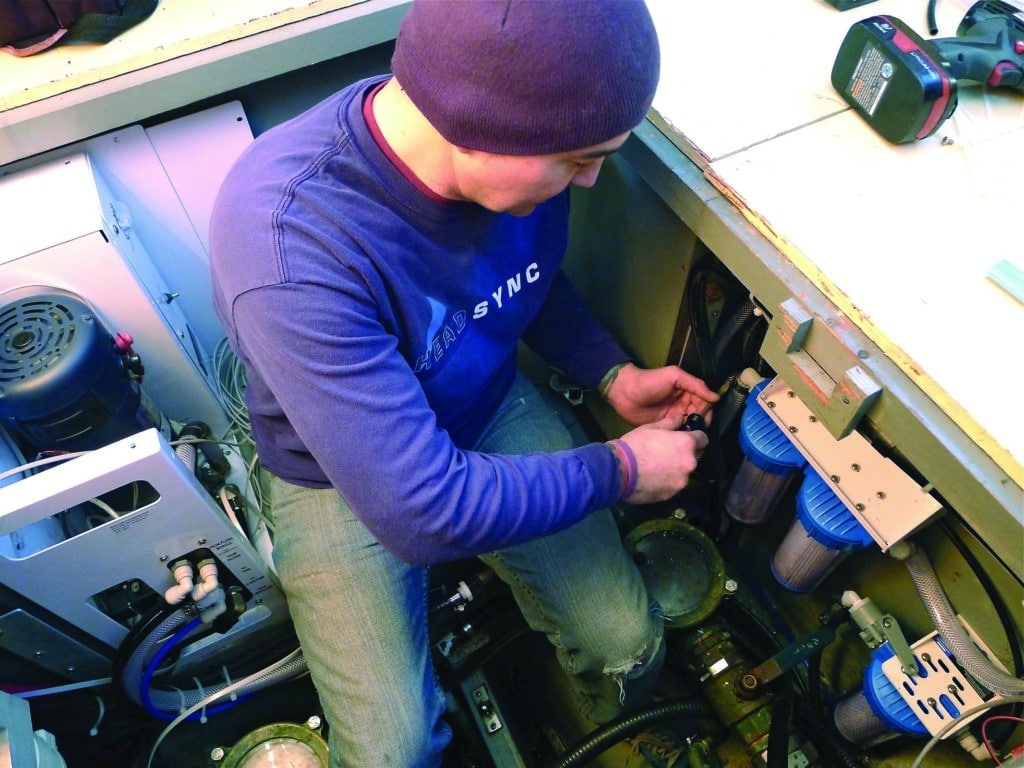
I remember, in the not too distant past, when having a watermaker aboard a cruising boat seemed to be the ultimate luxury. Plenty of sailors considered them too expensive and complicated. Fortunately times have changed. With improved technology and a range of price points on the market, now even average cruising boats of modest means carry a reverse-osmosis system. And really, is there anything that feels better after a day spent sailing and swimming than a hot shower? The freedom and security that come with full water tanks are also a nice bonus, particularly if you’re cruising in an area where fresh water is difficult to come by and pricey when you do.
Choosing a Watermaker
As with any major system, there are many factors to consider when you choose a watermaker. You’ll need to figure out your freshwater needs, the space you have available for the system and how you’re going to power it . Generally speaking, in a reverse-osmosis desalination system the raw water is run through a series of pre-filters, and then a high-pressure pump moves the water through one or more membrane housings. The wastewater, or brine, is released overboard and the product water goes into your water tanks.
Since all of the watermakers that are currently available for cruising sailboats use this process for desalination, the major differences between the systems are how you power the high-pressure pump and the user interface. Powering options include 120/220-volt AC, 12- or 24-volt DC and engine/belt driven. All have their pros and cons.
“The first question I ask a potential customer is ‘Will your boat have a ship’s generator?’” said Rich Boren of Cruise RO Water. “If they plan to have a generator, then the decision to go with a 120-volt high-output watermaker seems natural. While running the generator for battery charging and other loads two to three times per week, they can keep their water tanks full without having to make generator runs just to make water.”
A 12-volt system, such as the Spectra Catalina 300 Mk II or the Horizon Reverse Osmosis Seafari Quest, makes a lot of sense for smaller cruising boats since they don’t need a generator to run and have fairly miserly power consumption. On a breezy, sunny day, a solar panel and/or a wind generator will likely keep up with the demand. “The only difference between 12-volt DC low-output and 120-volt AC high-output watermakers is how the high-pressure pump brings seawater up to the 800 psi needed to drive fresh water through the reverse-osmosis membrane,” Boren said. “The membrane and support equipment, like pre-filtering and plumbing, are the same.”
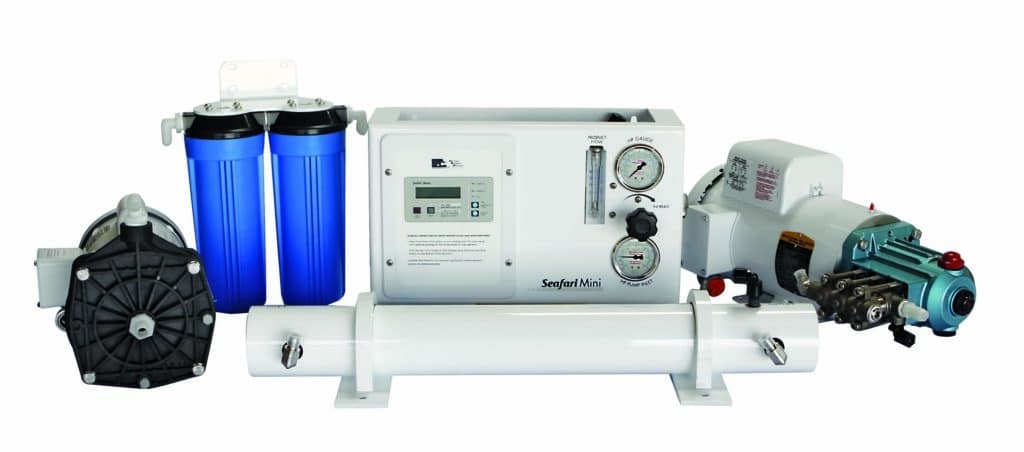
These systems typically produce anywhere from about 6 to 16 gallons per hour, and some units can do so for about a 1-amp-per-gallon power draw.
“Many smaller sailboats, under 45 feet or so, often utilize solar panels,” said Berkeley Andrews of Parker Hannifin, which produces Sea Recovery, Horizon Reverse Osmosis and Village Marine watermaker systems. “Their entire electrical backbone consists of 12-volt or 24-volt. So they must have a watermaker that can operate on low voltage. These customers have limited amp hours on their batteries, so all of their equipment must be suited to handling this.”
In choosing a watermaker, Bill Edinger, owner of Spectra Watermakers, said to be realistic about water needs. “When helping customers decide which system is right for them, first we like to determine their approximate water usage with questions like ‘How many people are aboard normally? Are you going to be living on the boat full time? Do you have a washing machine? Any children? Are you going to be cruising full time or leaving the boat for extended periods?”
A common error people make is choosing a watermaker that is too small for their needs. “The most common mistake I see cruisers making in their watermaker purchase decision is underestimating how much water it will take them to cruise comfortably,” Boren says. “I’m not talking about the minimal amount of water it takes for the crew to stay alive, because there is a big difference between staying alive and comfort. Selecting a watermaker that will only meet their minimal drinking-water needs but not keep up with the comfort needs of the crew can lead to crew tensions and feeling like camping rather than cruising.”
Remember that “watermakers are rated in gallons of production in a 24-hour period,” Edinger said. “So a 300-gallon-per-day watermaker system sounds like a lot of water. The important thing is that it produces about 12 gallons per hour. Normally a system like this will be run three to four hours per day if power is not a critical issue, in this case producing 36 to 48 gallons of water. It’s better for a system to run for a few hours every few days than an hour every day.”
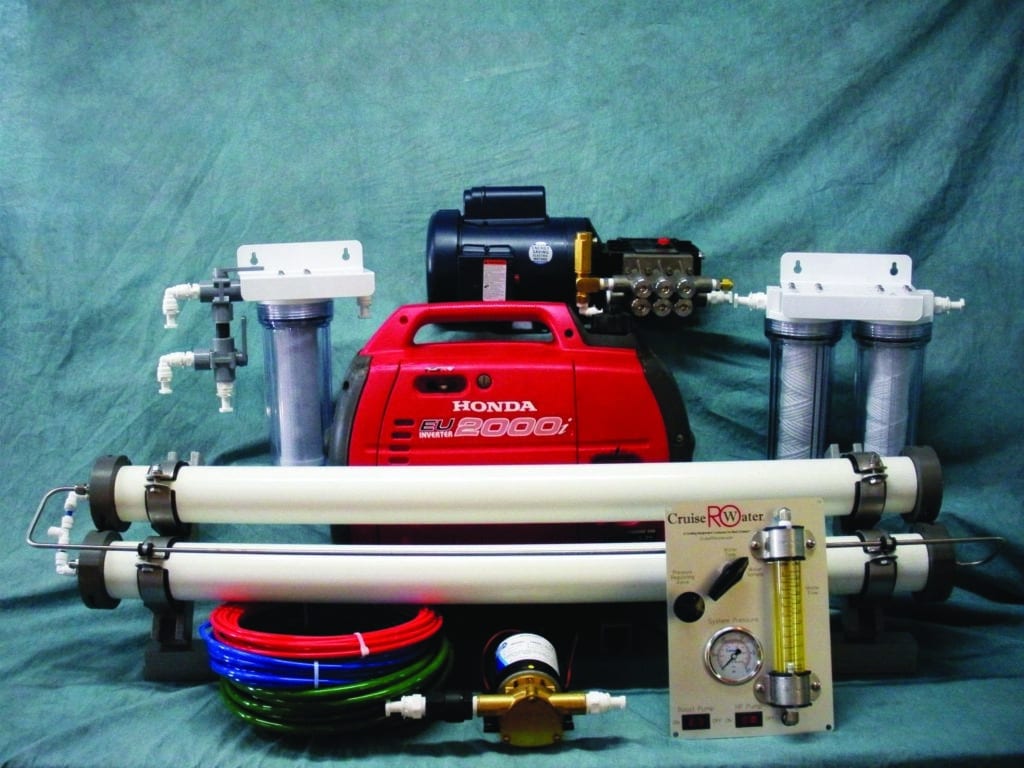
Watermakers for Small Boats
If space is at a premium, consider purchasing a modular system instead of an enclosed one. In a modular system, the components, such as the membranes and filters, can be mounted separately. Another power source for the high-pressure pump is the boat’s diesel engine. In these engine-driven setups , the pump and an additional pulley are mounted on a custom bracket next to the engine. The watermaker can then be run while motoring or using the engine to charge the batteries.
While engine-driven watermakers can produce a large amount of water, 20 or more gallons an hour on average, the downside is that the installation can be more complex than for other systems. “Unlike the 12-volt DC or 120-volt AC watermakers, where you simply bolt the high-pressure pump down and then run the wires and plumbing hoses, the hardest installation aspect of an engine-driven watermaker is finding space. Some boats simply have no room in the engine compartment to mount the 5-pound pump with a 7-inch pulley on the engine while still leaving access to other engine parts that need to remain serviceable,” Boren says.
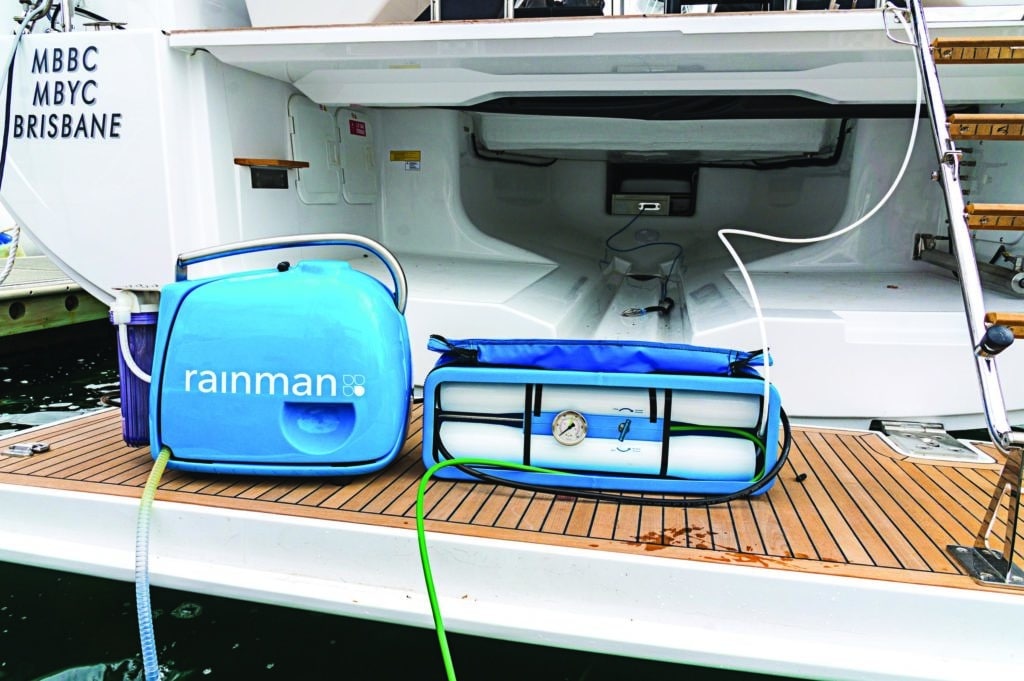
A relative newcomer to the marine market, the portable watermaker is a good solution for cruisers who want the convenience of a watermaker but don’t want to permanently install one. The Rainman is one such system that is available as a self-contained unit driven by a gasoline-powered Honda motor, or as a 115-volt AC-powered unit. “The bulk of our gasoline-powered system customers are sailing yachts between 30 and 50 feet,” said Ron Schroeder of Rainman Desalination. “Our customers seem to prefer to have a simple and somewhat manual system over one that relies on control panels, software and solenoid valves. We are also attractive to those customers who have had bad experiences with the installation process of an installed system.”
The Spectra Passport is another portable system. Edinger said it has already proved popular with offshore race crews and cruisers who need a watermaker for only a limited time.
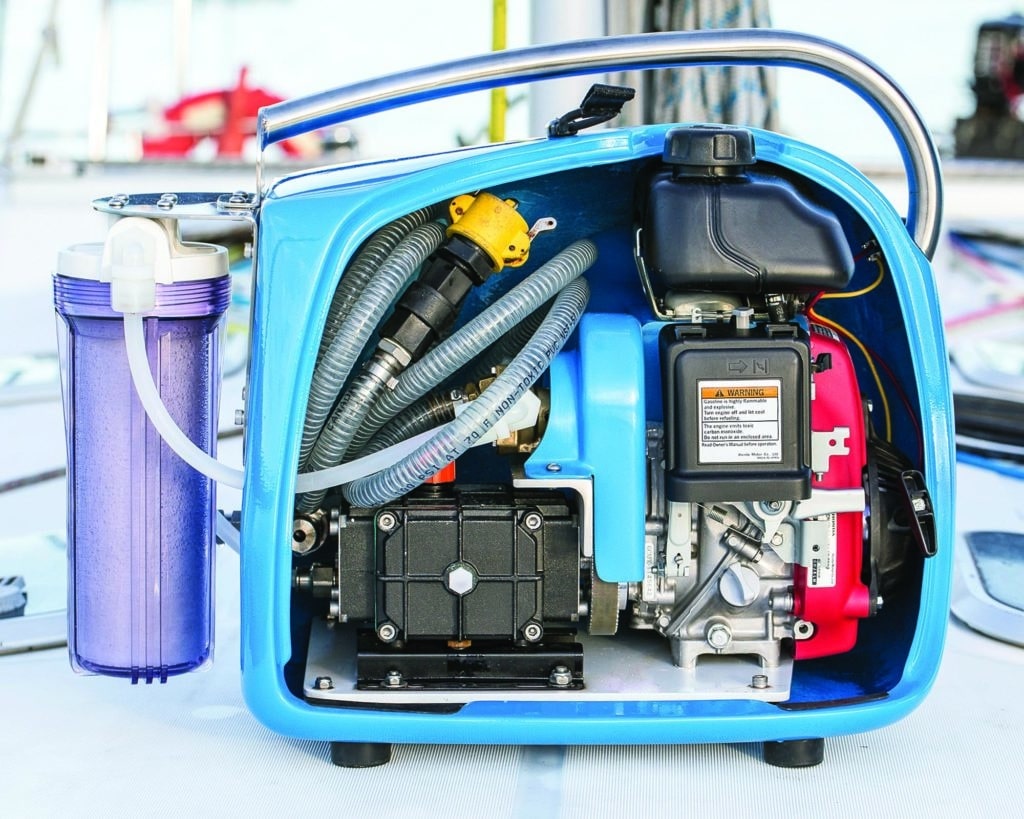
Maintenance for Watermakers
Watermakers have long had a reputation for being difficult to maintain, but the equipment has improved over the years and overall, routine maintenance isn’t more challenging than with other onboard systems. “The best rule of thumb is to operate the watermaker in water that looks good,” Andrews said. “There are a few factors in the feed-water condition that come into play. Operating a watermaker in dirty harbors will most certainly result in repeated pre-filter changes and a clogged sea strainer. If you have extra filters on board, you can get by, but it’s not recommended. The environment in the open ocean and remote anchorages is much better. Also consider how shallow the water is where you’re anchored. Sometimes there can be a lot of tidal movement, which can kick up fine particulate and sediment. This too can also contribute to more frequent filter changes and even damage other components. A nice option is an automatic freshwater flush, which will rinse the watermaker’s membrane element after use. It helps keep the membrane vessel housing free of any biological growth that could foul the membrane and reduce your ability to produce fresh water.”
Whatever system you choose, with proper use and maintenance you can expect years of service from your watermaker. And plenty of hot showers.
Jen Brett is a CW associate editor. This article first appeared in the February 2015 issue of Cruising World.
Aqua Marine: www.aquamarineinc.net
Blue Water Desalination: www.bluewaterdesalination.com
Cruise RO: www.cruiserowaterandpower.com
Dometic Marine Sea Xchange: www.dometic.com
ECHOTec: www.echotecwatermakers.com
FCI Watermakers: www.filtrationconcepts.com
Horizon Reverse Osmosis (HRO): www.hrosystems.com
Katadyn: www.katadyn.com
Rainman: www.rainmandesal.com
Sea Recovery: www.searecovery.com
Schenker Watermakers: www.schenkerwatermakers.com
SK Watermakers: www.skwatermakers.net
Spectra Watermakers: www.spectrawatermakers.com
Village Marine Tec: www.villagemarine.com
Watermakers Inc.: www.watermakers.com
- More: DIY Sailboat Projects , How To , systems
- More How To
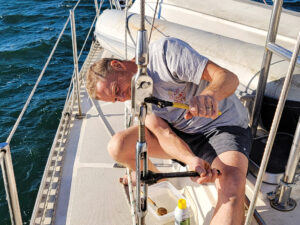
How to Rig Everything in Your Favor
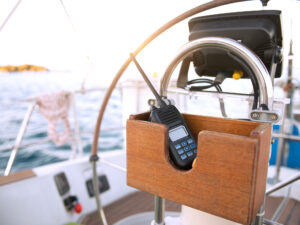
Is There a Doctor Aboard?

3 Clutch Sails For Peak Performance

It’s Time to Rethink Your Ditch Kit
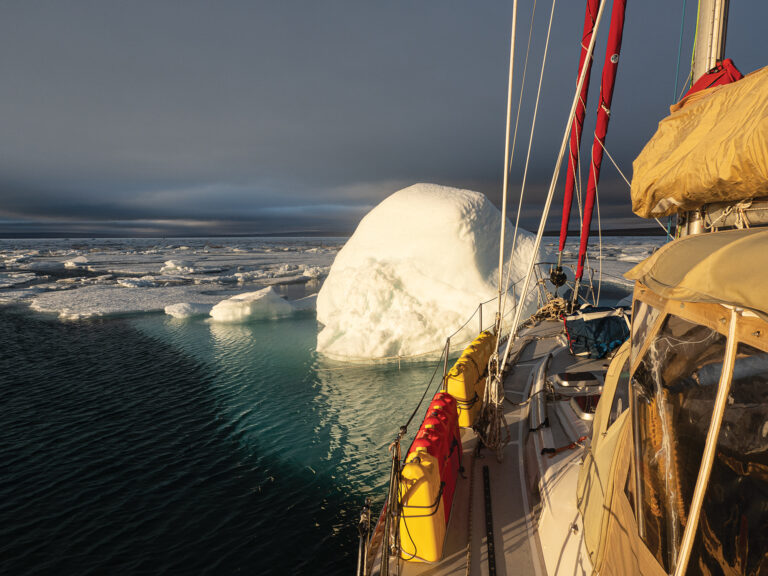
Cruising the Northwest Passage

Balance 442 “Lasai” Set to Debut
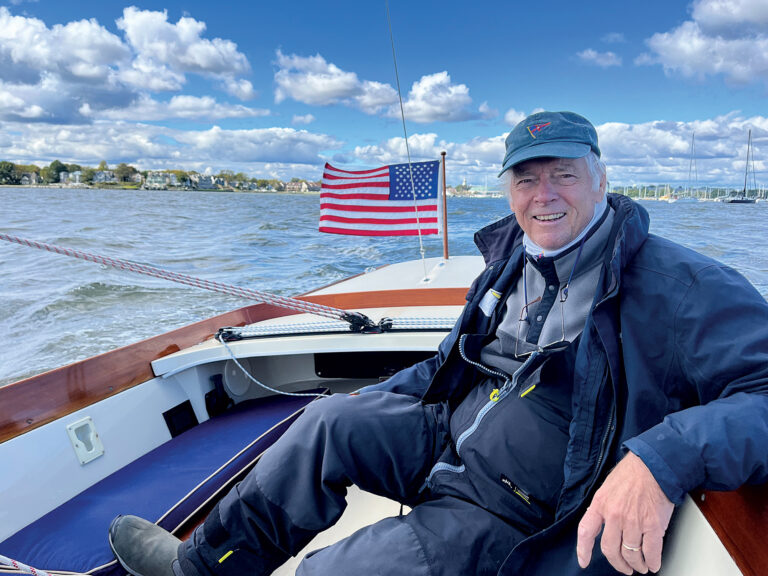
A Legendary Sail

10 Best Sailing Movies of All Time
- Digital Edition
- Customer Service
- Privacy Policy
- Email Newsletters
- Cruising World
- Sailing World
- Salt Water Sportsman
- Sport Fishing
- Wakeboarding

Home » Blog » Gear » Watermakers: a guide to marine desalinators and making water on a boat
Watermakers: a guide to marine desalinators and making water on a boat
By Author Fiona McGlynn
Posted on Last updated: March 23, 2022
There’s something magical about a watermaker—at least that’s how I felt after we installed one on our boat. That may sound overblown, but think about it: watermakers transform salt water into fresh water, providing a near-endless supply of potable water for drinking, bathing, and cleaning! THAT my friends is an amazing piece of technology!
(If you don’t share my enthusiasm, try going without a shower for a few days and you’ll begin to see my point).
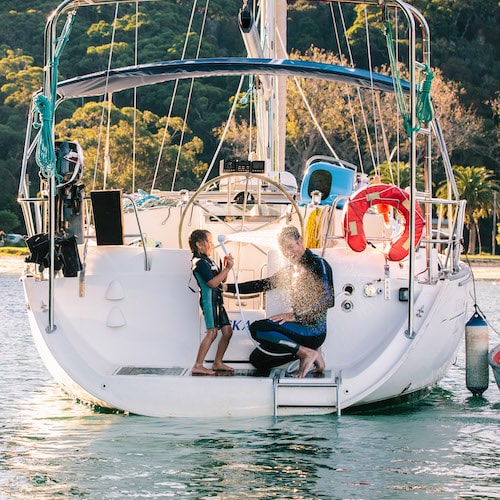
Having experienced living on a boat and cruising, both with and without a marine desalinator, I can attest that it’s a game-changing piece of gear. However, you definitely don’t need one to go cruising. There are plenty of low-tech ways to collect and make water on a boat.
Marine desalinators do offer some major benefits: there’s more water for showers, it’s easier to travel farther afield, you can spend more time in a remote location. However, these benefits have to be weighed against the drawbacks: namely a hefty price tag and ongoing maintenance.
Deciding whether a watermaker is right for you will come down to the type of cruising you’re doing, how much water you need, and your budget. Read on to learn about the pros and cons, costs, and key features of marine watermakers.
Table of contents
- 1 How does a watermaker work?
- 2.1 Benefits
- 2.2 Drawbacks
- 3.1 Powered or handpump
- 3.2 Electric or engine drive
- 3.3 Energy recovery watermaker
- 3.4 Modular, self-contained, and portable watermakers
- 3.5 Automatic flushing systems
- 3.6 Automatic Pressure Regulation and adjustable pump speed
- 3.7 Remote control panels
- 4 Top watermaker brands
How does a watermaker work?
A watermaker on a yacht converts seawater into fresh water through a process known as reverse osmosis (RO). A high-pressure pump pushes seawater through a semi-permeable membrane that filters out salt, organics, and bacteria. The fresh water is pumped into your water tanks while the remaining brine bi-product is discharged over the side of the boat, back into the ocean.
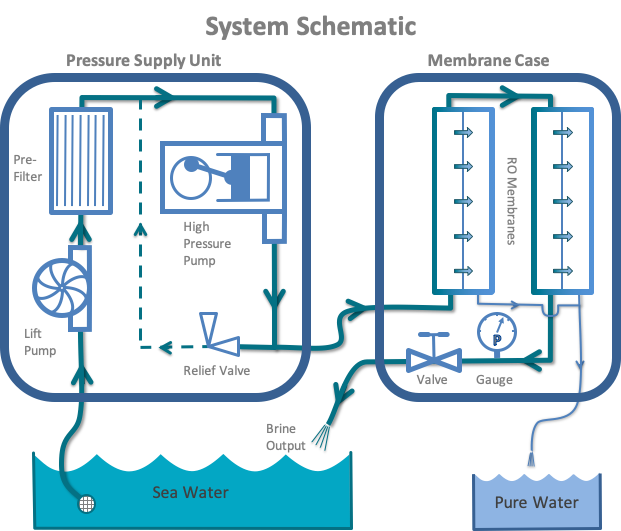
Marine watermakers: the benefits and drawbacks
Less water rationing.
When we started our 13,000 mile trip across the Pacific, we didn’t have a watermaker. We were on a tight budget and decided to prioritize other pieces of equipment like a life raft and wind vane.
As a result, we became experts in conserving water on a boat . We would carefully ration out water for washing dishes, taking showers, and even brushing our teeth!
After getting a watermaker we became far less meiserly because we knew we could always make more water if we needed to. It was a relief to not be constantly thinking about how much water we were using over the course of a day.
That being said, we couldn’t relax completely. We had to keep our tanks topped up, so as not to run the pump dry. We also always carried potable water in reserve, in case our watermaker broke in the middle of a long passage.
More luxuries
Can’t live without a proper shower? A boat water maker can make water-intensive luxuries like freshwater deck washdown, freshwater flushing heads, laundry, daily showers, and even baths, a possibility.
As great as this sounds in theory, we were surprised to find that we didn’t indulge in more showers after we got the watermaker.
We continued to use a hand pump pesticide sprayer to shower on deck despite having a watermaker and shower below. While some of this came down to habit, we also disliked running our engine (and consuming diesel) just to run the watermaker.
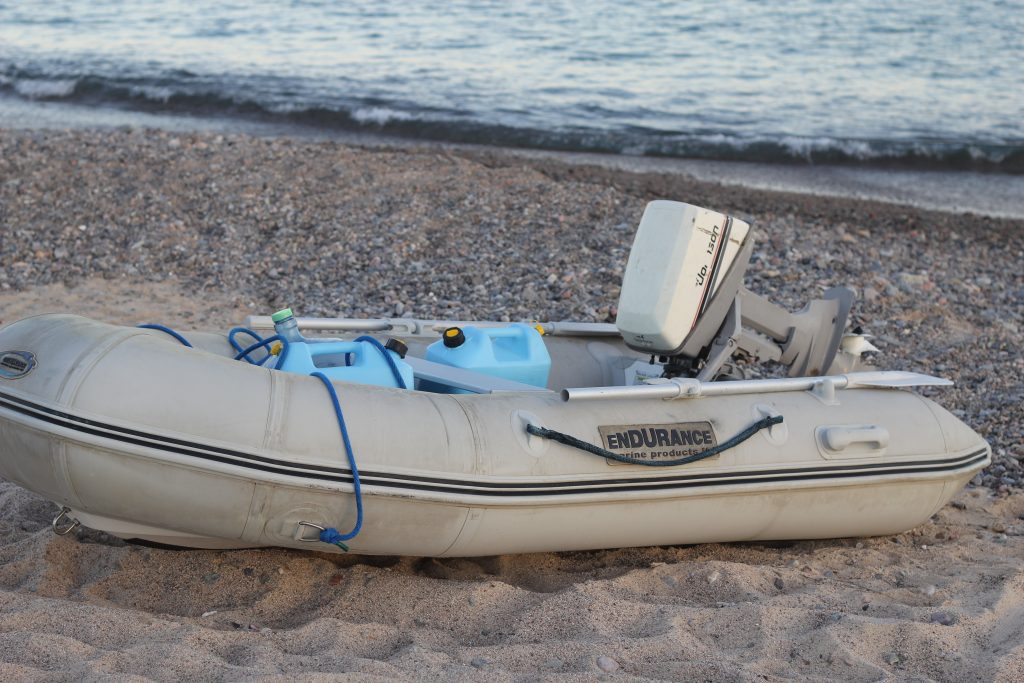
No hauling water
For us, this was by far the greatest benefit of having a watermaker!
While cruising in the US and Canada, we could refill our water tanks at a dock or marina. This was a minor hassle because it involved pulling up the anchor and docking the boat.
In Mexico, it was more challenging to get water. We would fill 5-gallon jugs at the local water purification plant in town and wheel them back to our boat on a collapsible dolly.
It often took a couple of trips with the dolly and dinghy to fill our water tanks. Oh, and we broke our dolly, twice!
We realized that if we wanted to spend more time exploring, and less time hauling water, we would have to invest in a watermaker. When we reached La Paz, Mexico we bought a refurbished watermaker, and we were so glad we did!
Our sailboat water maker gave us the gift of time, especially in places like Mexico and the South Pacific, where there were limited opportunities to fill water tanks up at the docks. It also saved us paying docking and water fees.
We estimate that our boat water maker saved us anywhere from four to six hours every week, time that we could spend exploring the wonderful places we were visiting.
A clean, safe water source
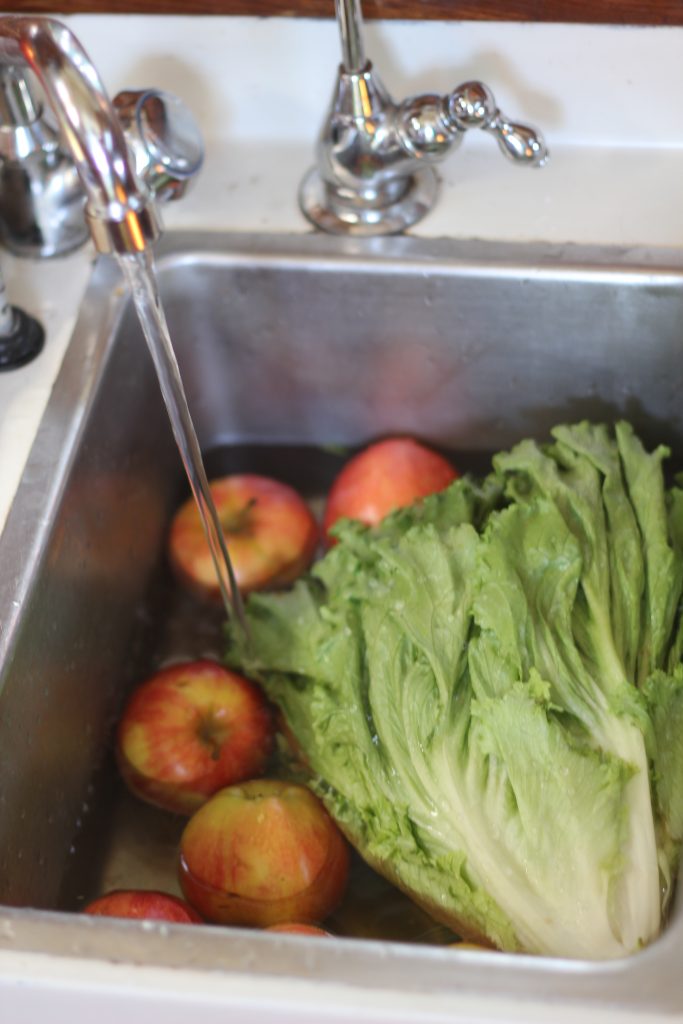
In places where the drinking water may be suspect, a boat water maker can be a reliable source of safe drinking water (assuming it’s in good working condition!).
More time in remote locations
A watermaker is a great tool if you’re drawn to remote locations where you might be the only boat in the anchorage.
It wasn’t until we reached Los Frailes, a secluded village on the Baja, that we really began to think about buying a watermaker.
There we were in an idyllic anchorage, surrounded by spectacular hiking and fishing. There was only one problem—every two days we had to walk 10 miles into town with our water jugs and hope that some kind samaritan would give us a lift back to our boat.
Before having a watermaker, we’d often leave a place we loved just because we needed to fill up our tanks. With a watermaker, we were more self-sufficient and could stay an extra few days, or as long as we wanted!
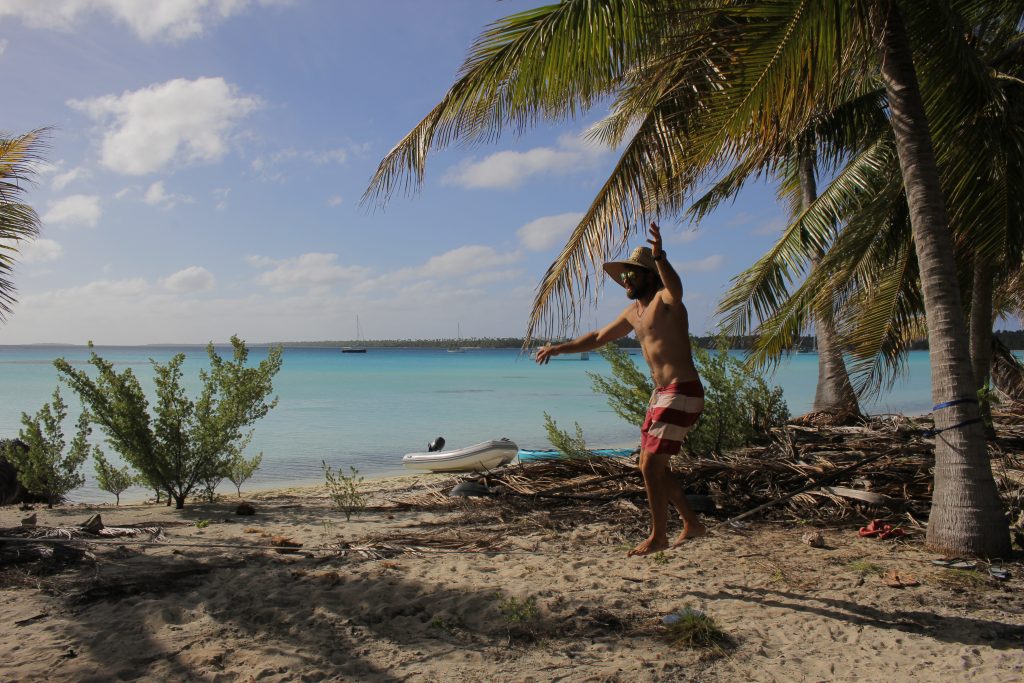
The number one drawback is the cost. We were able to find a refurbished water desalinator for $3,000, which was a great deal but also a considerable slice out of our cruising kitty.
How much does a watermaker cost?
Powered desalination systems for your average recreational cruising boat range from around 3,500 USD to 11,000 USD, with the more expensive options offering higher production (gallons of fresh water per hour).
Ongoing maintenance
Watermakers are yet another piece of boat equipment that needs to be maintained.
The majority of watermaker problems are caused by not using it enough or not using it properly.
If a watermaker is not used for a few weeks, the planktonic organisms in the seawater will die, rot, and clog the membrane and filters. This can eventually damage the reverse osmosis membrane in the watermaker.
For this reason, boat water makers should be used frequently and regularly flushed with fresh water.
Watermaker flushing
Check your manufacturer’s instructions on how to flush.
Rainman recommends flushing the seawater out of the system with fresh water if you are not using the system for more than a day or two. After another week, you need to freshwater flush the system again or pickle it for long-term storage.
Of course, it’s easy to forget, so we made it a rule to freshwater flush our watermaker after every use.
This is one good reason to choose a watermaker with an output that will meet your water consumption needs but not exceed them. If you’re using it every second day, you won’t have to try and remember whether you’ve flushed it or not.
Flushing a watermaker is relatively simple but it does involve a bit of work. We used a system with buckets of fresh water to flush our system and it generally took about 5 minutes.
You can also buy systems that automatically flush your watermaker at pre-determined times—even when you’re away from the boat (more on autoflush systems below).
Whatever you do, don’t use chlorinated water to flush as it will destroy reverse osmosis membranes. It’s possible to buy a carbon filter to remove chlorine from water sources at the dock.
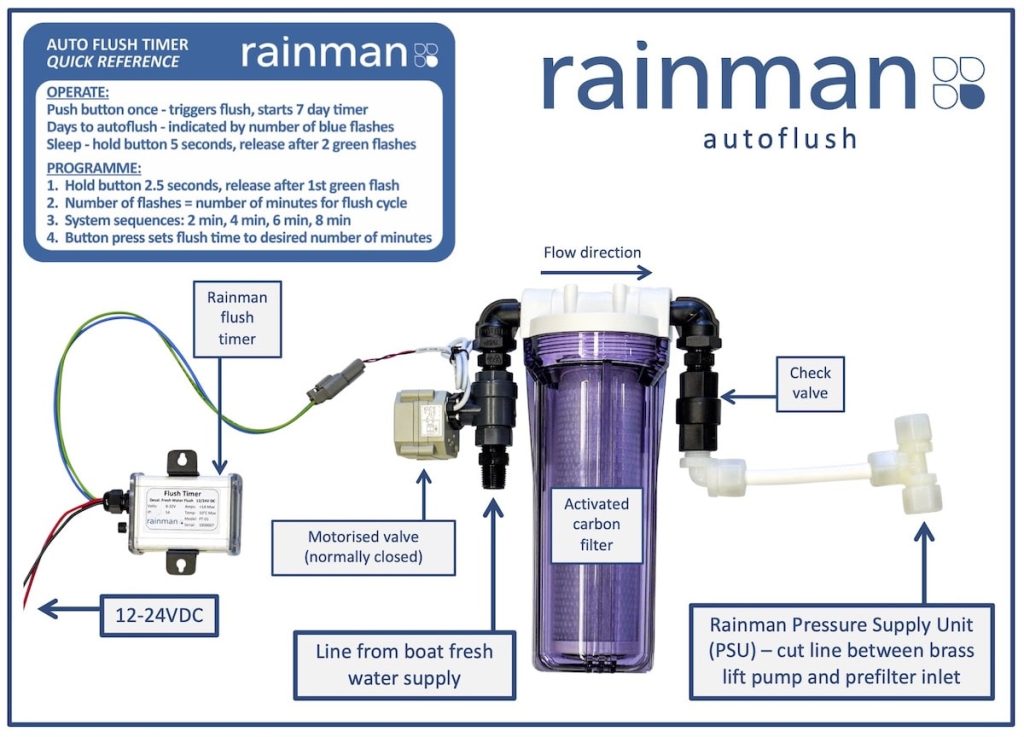
Pickling a watermaker
If you don’t plan on using your watermaker for a while it needs to be “pickled” with a special biocide to prevent growth and buildup which could render your reverse osmosis membrane totally useless.
A watermaker should also be pickled every so often to chemically cleanse the membrane.
In addition to flushing and pickling, you will also need to clean out and replace the raw water pre-filters.
Operating costs
When properly cared for, a membrane should last five to ten years. If you don’t properly flush or pickle your watermaker, it can be a lot sooner and membranes aren’t cheap, generally costing in the range of 200-700 USD.
You’ll also need to purchase pre-filters and pickling solution, which are generally quite affordable. It’s also a good idea to carry spare parts
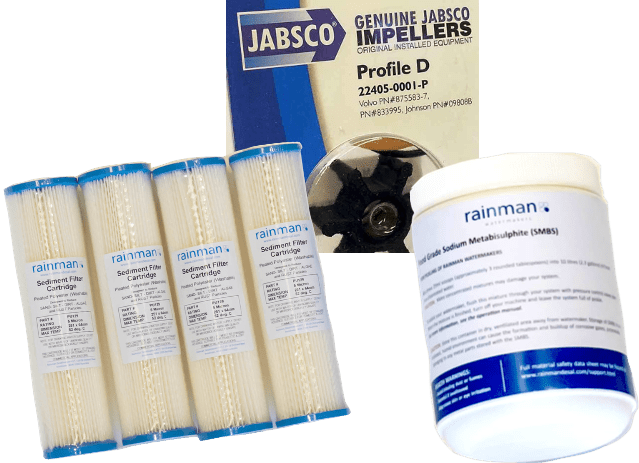
Power consumption
Watermakers can be real power hogs. When Practical Sailor tested a dozen DC watermakers they found they could draw anywhere from 12 to 48 watts per gallon, a huge range in efficiency!
According to Practical Sailor, “for maximum efficiency none of the systems drawing 15 amps or more should be operated without running the engine at the same time.”
We had to run our engine for hours to fill our tanks, which was annoying (and loud) when we were hanging out at anchor and also used up another finite resource—diesel fuel.
In our view, this was the single largest drawback to having a watermaker aboard.
Keep in mind that your power supply will determine what type of watermaker you buy. You may need to upgrade your electrical panels, get a generator or high-powered alternator, add solar panels, or increase battery capacity to supply the demand.
You can’t make water everywhere
While watermakers offer great flexibility and freedom, you can’t just make water in any old spot. If you make water in a polluted marina or anchorage, you’ll risk clogging up your filter. Most cruisers will head out to open water to ensure the saltwater they’re using is as clean as possible.
Key features to look for
Powered or handpump, handpump watermakers.
Handpump watermakers tend to be small and portable, the perfect thing to keep in your ditch bag in the event of an emergency. They’re less expensive than powered watermakers and produce far less water, usually around one gallon per hour.
Though I do know cruisers who have used a handpump watermaker for everyday use, they typically tend to be kept aboard for survival situations.
Powered watermakers
Powered watermakers run off your electrical supply or engine and can produce tens of gallons of water per hour. They tend to be a lot more expensive, but they’re productive enough to replenish your tanks.
Electric or engine drive
Powered watermakers can be electrically driven, by AC or DC, or run off the boat engine.
AC watermakers
AC models can produce in the range of 20-60 gph and are ideal for cruisers with an AC generator or alternator on board. They can also be used on boats with ample solar or wind sources and an inverter.
DC watermakers
DC watermaker systems typically produce in the range of 10-30 gph and are ideal for boats with solar power or 12V battery power.
Engine-driven watermakers
On an engine-driven watermaker, the high-pressure pump is belt-driven. These can produce a considerable amount of water, even on small engines. For instance, engine-driven units produce between 20-60gph, twice what a DC unit can produce.
Energy recovery watermaker
DC watermakers have become more efficient in recent years thanks to energy recovery systems (ERS). When the water leaves the watermaker it is still under pressure. ERS uses a set of valves to make use of this excess pressure to help drive the pump, which can reduce energy consumption by as much as 80 percent.
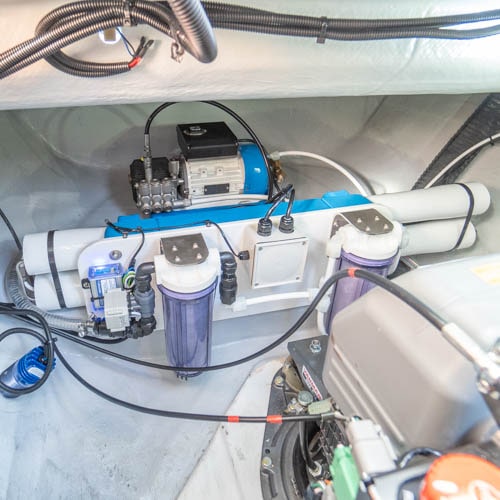
Modular, self-contained, and portable watermakers
Watermakers can be bought as modular, self-contained, and portable units. Choosing the right one may depend on your boat size and layout and whether you’re comfortable installing the watermaker yourself.
Modular units
Modular units come as several separate components that you can mount and connect yourself. This obviously offers a lot more flexibility and is particularly useful on smaller vessels where you may not have a lot of space. The downside is that these systems will take longer to install.
Self-contained units
Self-contained units arrive pre-assembled. While easier to install, they’re often bulkier and best suited to a bigger cruising sailboat with a large engine room.
Portable watermakers
Portable watermaker systems, like the Rainman watermakers, are entirely self-contained. Their compact design makes them easy to move and stow and you can completely avoid a permanent installation.
Simply put the intake and brine discharge hoses overboard, the freshwater hose in your water tank and you’ll be making water in no time.
If you race, have multiple boats, or plan on selling your boat, a portable watermaker is a great option because it can be easily moved from boat to boat.
If we were to buy another watermaker, we would probably opt for a portable one.
Automatic flushing systems
Automatic flushing systems use your boat’s freshwater supply to flush the watermaker for several minutes every few days. These systems require additional components (e.g., a timer, carbon filters, and a motorized valve) and installation but they take a lot of the maintenance out of having a watermaker onboard.
Automatic Pressure Regulation and adjustable pump speed
Your watermaker’s efficiency will be affected by the temperature and salinity of the water you’re cruising in. Cold and highly saline waters (e.g., in the high latitudes) will be more work for your watermaker, so it will take longer to purify.
Some units feature Automatic Pressure Regulation (APR) and adjustable pump speed which can help compensate for fluctuations in water temperature and salinity.
Remote control panels
Some watermakers have the option of a control panel which allows for easier access and remote control. Control panels tend to have a fairly simple interface with just a few gauges but may include a salinity sensor—so you can keep tabs on water quality—and auto-flush integration—so you can flush your watermaker with the flip of a switch.
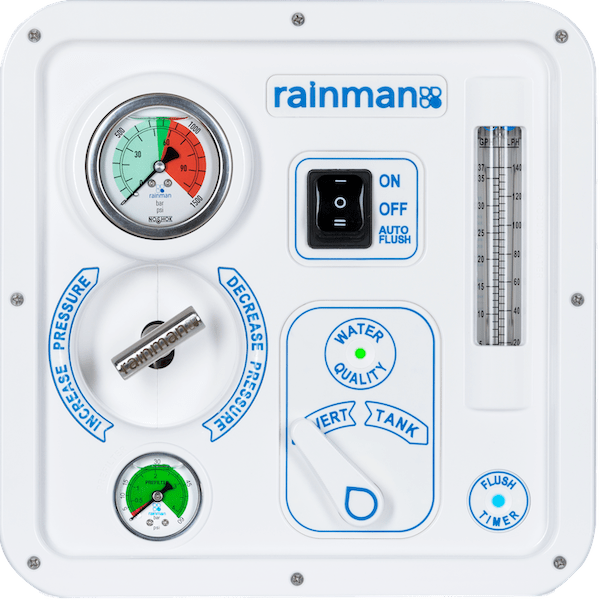
Top watermaker brands
If you’re considering buying a watermaker for a boat, here are some of the top brands to consider.
- Cruise RO Watermaker
- Echotec watermakers
- Horizon Reverse Osmosis (HRO)
- Sea Recovery watermakers
- Schenker watermakers
- Spectra watermakers
Fiona McGlynn is an award-winning boating writer who created Waterborne as a place to learn about living aboard and traveling the world by sailboat. She has written for boating magazines including BoatUS, SAIL, Cruising World, and Good Old Boat. She’s also a contributing editor at Good Old Boat and BoatUS Magazine. In 2017, Fiona and her husband completed a 3-year, 13,000-mile voyage from Vancouver to Mexico to Australia on their 35-foot sailboat.
Terms and Conditions - Privacy Policy

Before you go, check this out!
We have lots more on the site to show you. You've only seen one page. Check out this post which is one of the most popular of all time.
Desalination Systems For Boats: 7 KEY Points To Consider
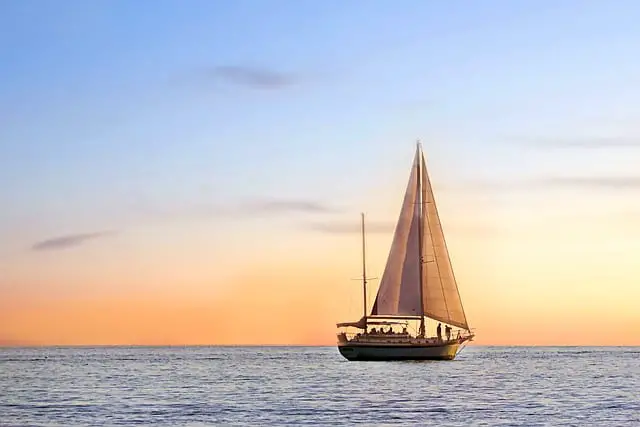
This a quote that always got me thinking, partially about the immense challenge involved with sourcing water at sea, but also the technological advances we have had in desalination and more importantly, compact desalination over the last 500 years.
“Water water everywhere and not a drop to drink “ The Rime of the Ancient Mariner – Samuel Taylor Coleridge
Being able to stay offshore for months at a time is something I was always fascinated by, the ability for ships to be largely self-sufficient and to produce fresh water. It did make me wonder though, how do they do it, what is the best option for different boats? Is there a one size fits all approach? How do you make sure the water is ok to drink? All of these questions got me thinking, what do you need to consider when installing or purchasing a desalination system for a boat? To better understand what is involved, I got researching and came up with this guide!
Compact reverse osmosis desalination systems powered manually or with varied electrical sources are suitable for most recreational boat users. For larger vessels with onboard motors, distillation becomes more viable, particularly as engine size increases and the excess heat produced can be utilized effectively.
1. The type of desalination system!
Realistically and practically speaking there are only two types of desalination systems suitable for boats, the most common being reverse osmosis and the alternative being distillation. Both options have their own advantages and disadvantages with certain boat types suited to one over the other.
Reverse osmosis (RO)
Reverse osmosis is a popular desalination technology that uses a semi-permeable membrane to remove salt and other contaminants from seawater. RO systems work by applying pressure to seawater, forcing it through a membrane that allows only freshwater molecules to pass through, leaving the salt and other impurities behind.
Advantages: RO systems are highly efficient, producing freshwater with a high salt rejection rate. They are also compact, lightweight, and relatively easy to install, making them ideal for boats with limited space. Additionally, RO systems require less energy than other desalination methods, making them more environmentally friendly and cost-effective in the long run.
Disadvantages: RO systems require regular maintenance, including membrane cleaning and replacement, to prevent fouling and other issues. They also require high-pressure pumps to operate, which can be expensive and may put a strain on the boat’s power supply. Furthermore, RO systems are sensitive to variations in water quality and temperature, which can affect their performance.
Example: Spectra Watermakers is a leading manufacturer of RO desalination systems for boats, offering a range of systems suitable for different boat sizes and water usage levels.
Best suited for .
Reverse-osmosis systems are generally the most common system utilized in marine environments due to their scalability, more compact nature and lower energy requirements. Sailing boats and vessels powered by outboard motors almost exclusively utilize reverse osmosis systems as they do not produce the excess heat required to operate distillation systems at an efficient level.
Distillation desalination systems
Distillation desalination systems use heat to evaporate seawater, leaving behind salt and other contaminants, and then condensing the steam into fresh water.
Advantages: Distillation systems produce high-quality freshwater that is free from most impurities, including bacteria, viruses, and dissolved solids. They are also relatively simple to operate and maintain, with no membranes or filters to replace. Additionally, distillation systems can be powered by a variety of heat sources, including electricity, gas, or diesel, making them suitable for different types of boats.
Disadvantages: Distillation systems are generally less efficient than other desalination methods, requiring more energy to produce the same amount of freshwater. They are also bulkier and heavier than RO systems, which can be a challenge on smaller boats with limited space. Furthermore, distillation systems are more expensive to purchase and install than other desalination methods, and may not be practical for boats with limited budgets.
Example: GEA is a manufacturer of innovative distillation desalination systems for boats where the heat produced by the engine is used in the distillation process , improving the overall efficiency of freshwater production.
Best suited for:
Distillation systems are best suited for large vessels with comprehensive onboard diesel motors. These larger vessels produce excess heat in the engine room which can be utilized in the distillation process, lowering the specific energy required to run the distillation system and thereby lowering the cost of operation.
2. The size of the desalination system.
When selecting a desalination system for a boat, size is a crucial factor to consider both the physical size of the unit and the production requirements. Factors to consider include the boat’s size, water usage, and budget.
Boat Size: This may seem obvious, but the size of the desalination system should be appropriate for the size of the boat. A large boat will require a larger desalination system to produce enough fresh water for the crew’s needs. A small boat, on the other hand, may only require a compact and lightweight system.
Water Usage: The size of the desalination system also depends on the boat’s water usage. A boat with a large crew or that spends long periods at sea will require a larger system to produce enough fresh water. A boat with a smaller crew or that spends less time at sea may only require a smaller system.
Space Constraints: The size of the desalination system should also consider the available space on the boat. Larger systems may be difficult to install on smaller boats, while smaller systems may be more practical for boats with limited space.
Budget: The size of the desalination system will also affect the cost. Larger systems will generally be more expensive than smaller systems however this is not always the case as some high-performance options can be extremely compact.
3. Testing apparatus & Quality Control.
The quality of water produced by the desalination system on a boat must be monitored to ensure that it falls within the required salinity levels prior to any potential consumption or use. Being in a space-constrained environment, practicality is key and depending on the size of the system both automatic and manual processes should be considered.
The best option for low volumes: Test Strips
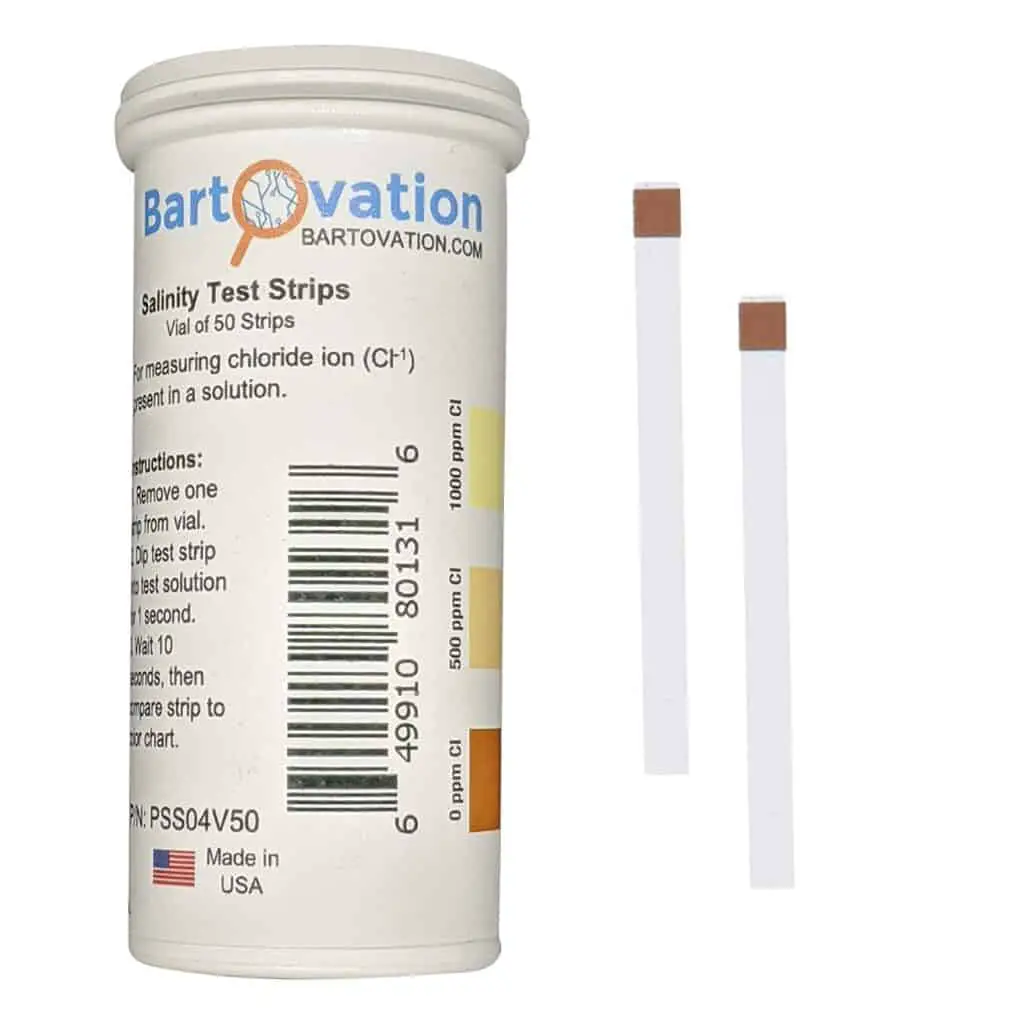
Test Strips: Salinity test strips are another practical option for testing salinity levels on a boat. They are small, lightweight, and require minimal space to store. Test strips are easy to use and can produce a result in just a few minutes. They are also relatively inexpensive and can be used to measure salinity levels in both fresh and saltwater. However, test strips may not be as accurate as other testing methods and may not be suitable for scientific or research purposes.
The test strips displayed to the left are available on Amazon for $23 USD , less than 50c per test!
The best option for continuous use: Conductivity Meters.
Conductivity meters are another practical option for testing salinity levels on a boat. They are portable, easy to use, and can measure salinity levels in both fresh and saltwater. Conductivity meters are more accurate than refractometers and test strips and can be automated for continuous monitoring. However, conductivity meters can be more expensive than other testing methods and may require more maintenance.
The third option: Refractometers.
Refractometers: Refractometers are one of the most practical salinity testing methods for use on a boat. They are small, lightweight, and easy to use, requiring only a small sample of water to produce a reading. Refractometers are also relatively inexpensive and can be used to measure salinity levels in both fresh and saltwater. They are ideal for quick and accurate testing and can be easily stowed away when not in use.
For a more in-depth article specifically focussed on salinity levels testing, have a look at How To Check Water Salinity Levels: 4 Potential Methods .
4. The power requirements.

Desalination systems on boats can be powered by different energy sources, including utilizing the excess heat from the ship’s motors, solar power, wind power, and an alternator. Each energy source has unique advantages and disadvantages that make them more suitable for specific desalination systems.
Distillation systems require a significant amount of heat, and therefore utilizing the excess heat from the ship’s motors is the most practical source of energy . The heat produced by the engine can be used to evaporate and condense seawater to produce fresh water.
Reverse osmosis systems , on the other hand, require a significant amount of electrical energy, making solar power, wind power, and an alternator or generator more suitable sources of energy . Solar power, in particular, is a renewable and sustainable energy source that can be harnessed by solar panels mounted on the boat’s deck.
Wind power is another renewable and sustainable energy source that can power desalination systems on boats. The energy from the wind can be harnessed using a wind turbine and used to power the desalination system. However, the amount of energy produced by wind turbines depends on wind speed and can be expensive to install.
Alternators or generators can also be used to power desalination systems on boats, they function by converting mechanical energy into electrical energy and can be used to charge the batteries and power the desalination system. The advantage of using an alternator is its reliability, as it doesn’t depend on the weather conditions. The amount of energy produced by the alternator, however, depends on the engine’s speed and the size of the alternator.
Often, a combination of the above-mentioned energy sources is used , with an alternator or generator providing the base load power (Along with heat energy released from the ship’s motors for distillation). The remaining power demand is then sourced from small wind turbines and solar panels which fluctuate throughout the day depending on the environment. A mixed array of energy sources provides the balance between cost-effectiveness and reliability that is required to run desalination systems on board boats and ships.
5. The location of the system on the boat.
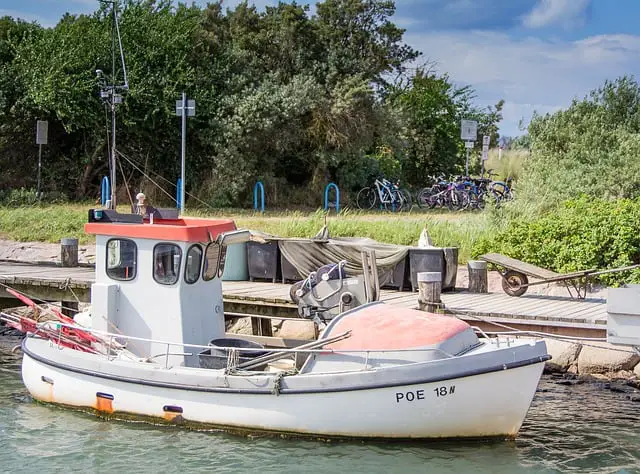
The location of a desalination system on a boat is an important factor to consider, as it can affect the efficiency and safety of the system. Here are some considerations to keep in mind when determining the optimal location for a desalination system on a boat:
- Accessibility: The desalination system should be installed in a location that is easily accessible for maintenance and repair. If the system is installed in a hard-to-reach location, it may be difficult to fix in case of a breakdown.
- Weight distribution: The weight of the desalination system can affect the boat’s balance and stability. The system should be installed in a location that balances the weight of the boat evenly. For example, if the system is heavy, installing it in the centre of the boat may be best.
- Vibration: Desalination systems can produce a significant amount of vibration, which can be uncomfortable for passengers and damage the boat’s structure. To minimize vibration, the system should be installed in a location that is isolated from other equipment and machinery.
- Water source: The location of the desalination system on the boat should be near the water source, such as the sea or a freshwater tank. This will minimize the length of the pipes and hoses required to transport water to the system, which can reduce the risk of leaks and water loss.
- Electrical connections: The desalination system requires electrical power to function, so it should be installed in a location that is close to the boat’s electrical system. This will reduce the length of the electrical cables needed, which can reduce the risk of electrical failure and improve the system’s efficiency.
- Ventilation: The desalination system generates heat and produces water vapour, so it should be installed in a well-ventilated location to prevent overheating and moisture buildup. Adequate ventilation can also prevent the accumulation of harmful fumes and gases.
- Noise: Desalination systems can produce a significant amount of noise, which can be disturbing to passengers and wildlife. To minimize noise, the system should be installed in a location that is isolated from cabins and areas where people congregate.
6. Storage requirements.
Water storage is an important consideration for any boat owner using a desalination system. Four key points to consider when it comes to water storage requirements for a desalination system on a boat are the water demand, available space, water quality and required maintenance:
- Water demand: The amount of water needed by the boat and its passengers will determine how much water storage is required. Boat owners should consider the number of people on board, the length of the trip, and the water needs for cooking, cleaning, and personal hygiene. This information will help determine the size of the water storage tank needed.
- Available space: The amount of space available on the boat will determine the size and shape of the water storage tank. Boat owners should consider the size and shape of the tank and where it can be located on the boat. This will depend on the boat’s design and layout, as well as the other equipment and storage needs on board.
- Water quality: The quality of the water produced by the desalination system will affect the storage requirements. Some systems produce water with high salt content, which can impact the taste of the water and corrode tanks and pipes over time. Boat owners should consider using tanks made from materials that are resistant to corrosion, such as stainless steel or plastic.
- Maintenance: Proper maintenance of the water storage tank is essential for ensuring the quality of the water and preventing damage to the tank and pipes. Boat owners should consider the maintenance requirements of the tank and the desalination system when selecting a storage tank. Some tanks may require frequent cleaning or flushing to prevent the buildup of bacteria or algae, while others may require regular inspection for cracks or leaks and therefore should be located in an easily accessible location.
7. The price of the system.
The financial cost of a desalination system is a critical consideration for boat owners who want to ensure a reliable source of fresh water on board. There are several costs associated with desalination systems, including the upfront cost of the system, installation costs, and ongoing maintenance costs.
The upfront cost of a desalination system can vary widely depending on the size and complexity of the system. Simple systems such as handheld or manual reverse osmosis units can be purchased for a few hundred dollars, while larger and more complex systems can cost tens of thousands of dollars. Additionally, the type of system will determine the ongoing costs of replacement filters or membranes, which can add up over time.
Installation costs for desalination systems will also vary depending on the type and size of the system, as well as the boat’s design and layout. Simple systems may require minimal installation work and can be DIY installed, while larger and more complex systems may require professional installation and plumbing work.
Ongoing maintenance costs for desalination systems include the cost of replacement filters or membranes, as well as any required maintenance or repairs. The cost of replacement filters or membranes can vary depending on the type and size of the system, as well as the frequency of use. Maintenance and repair costs may also vary depending on the complexity of the system and any required professional services.
For the average dinghy with an outboard motor, a handheld or manual reverse osmosis unit is likely the most affordable desalination system. These units can be purchased for a few hundred dollars and require no installation costs, making them an ideal option for smaller boats with limited space and budget.
For sailboats , a compact and portable reverse osmosis system that can be easily stored and transported is an excellent option. These systems are typically larger and more expensive than handheld units, but they can provide a reliable source of fresh water for longer trips.
For an extremely compact desalination system suitable as a backup water supply for recreational usage, take a look at Quenchsea , without a doubt the most lightweight manual desalination unit on the market.
For larger boats with onboard motors, a more complex and higher-capacity desalination system may be required. These systems can cost tens of thousands of dollars to purchase and install, and ongoing maintenance costs can be significant. However, they provide a reliable source of fresh water for longer trips and can be an excellent investment for boat owners who spend extended periods at sea.
https://www.spectrawatermakers.com/us/us https://www.gea.com/en/products/liquid-processing/water-treatment-systems/sea-water-distiller.jsp https://waterbornemag.com/watermaker/ https://www.saltwaterpoolandspa.com/salt-water-test-kit.html https://www.xylemanalytics.com/en/parameters/conductivity-and-salinity https://letsdowater.com/how-to-check-water-salinity-levels-4-potential-methods/ https://www.quenchsea.world/
John Wilson
Recent Posts
The Drought In Mexico: Affected Areas and Why It's an Issue
The drought in Mexico is an environmental crisis affecting over 85% of the country's land with more than 60% of the population being impacted. With over 40% of Mexico's GDP being generated in these...
Forever Chemicals In Your Water: What You NEED To Know
Forever chemicals, aka PFAS are a group of chemicals and plastics that don’t naturally break down in water and are linked to many health issues. PFAS are Utilized for their heat, water and oil...

Best Water Filter for Sailboats: Marine Systems

Last Updated by
Daniel Wade
June 15, 2022
Modern developments have made marine water filters cheaper and more efficient than ever.
In this article, we'll cover five of the best water filtration systems for boats. We'll also explain the difference between the most common types of marine water filters and analyze the pros and cons of each to help you make the right choice.
The best reverse osmosis water filter systems for saltwater are the Seawater Pro Watermaker, the SeaXchange filter system, and the Pelikan 2-Stage RO water purification system. The best freshwater filters are the Aquasana 3-Stage Filter, the West Marine HighFlo filter, and the AquaBrick system for small boats.
Information in this article comes from marine filtration system manufacturers, owners of these filters, and the advice of marine filtration system installers.
Table of contents
Saltwater vs. Freshwater Filtration Systems
The type of filter you need depends a lot on the type of water you need to filter. For freshwater filtering (such as from a lake or onboard freshwater tank), a standalone inline filter will suffice. Special filters should be used if you intend to drink lake water, and some people recommend reverse osmosis for all water sources.
Reverse osmosis filter systems are required for filtering salt water into drinkable water. The process itself is called desalination, and reverse osmosis systems can do it effectively. Another way to convert saltwater into drinkable freshwater is through distillation, but this process only works efficiently at scale, and it's impractical for personal sailboats.
What is Reverse Osmosis?
Reverse osmosis is the most effective small marine water filtration system available today. Reverse osmosis (RO) systems are compact and energy-efficient, and they have become quite affordable.
Reverse osmosis is essentially a pressurized filtration system with an extremely fine filter. The process forces dirty water to pass through a membrane which traps all particles (including salt) that aren't pure water. These systems are just as effective with saltwater as they are with fresh water, though they'll need to be cleaned more often when used in the ocean.
Should I Buy a Reverse Osmosis Filter for my Freshwater Boat?
You don't need a reverse osmosis system to make freshwater drinkable. Charcoal filters will usually do the trick, and many people are satisfied with them. Freshwater filters don't always require electricity, whereas reverse osmosis systems always require some source of power to produce the necessary pressure.
That said, reverse osmosis systems can produce large volumes of highly purified water, and they do a better job when combined with charcoal filters than charcoal systems alone. Additionally, reverse osmosis filters are the only kind of marine filters that can desalinate water on a small scale.
Best Reverse Osmosis Boat Water Filters
Reverse osmosis filters are the best water purifiers available for boats. These systems purify freshwater and desalinate saltwater, making them ideal for all environments. Here are three of the highest-rated RO filter systems on the market.
1. Seawater Pro Reverse Osmosis Desalinator and Watermaker
The best modular water filtration unit available for boats is the Seawater Pro three-membrane system . This all-in-one marine water purification machine is designed for medium-sized sailboats and powerboats.
This Seawater Pro system is a professional-level filtration plant that produces up to 50 gallons of clean drinkable water per hour directly from the ocean. It's designed to be installed in-line with existing plumbing, and it requires electricity to run.
Seawater Pro watermaker and desalination systems are available in 110v AC or 12v DC configurations, which means any boat with sufficient power can utilize one of these systems. Seawater Pro systems come in different sizes and configurations, and many can run off a standard 1600-watt electric generator.
If you're looking for a long-term watermarking solution for your boat, you can't go wrong with Seawater Pro. The system is compact and reliable, and owners are highly satisfied with the quality of water they're getting.
Key Features
- 50 gallons per hour
- 80 gallon-per-hour systems available
- 110v AC or 12v DC models available
- Stainless steel pressure regulators
- Food-grade pressure vessel
- Many parts are Made in the USA with a lifetime warranty
2. SeaXchange Watermaker XTC Series
SeaXchange produces one of the best self-contained marine water filtration systems on the market today. The SeaXchange III XTC series is their flagship watermaker and filter for boats, and it's available in multiple sizes.
For smaller boats, the SeaXchange XTC600 is ideal. It has a single membrane that can purify up to 25 gallons of water per hour. Larger boats can utilize the XTC200, which has an hourly purification capacity of 92 gallons.
The SeaXchange XTC is a reverse osmosis watermaker that functions much like the Seawater Pro unit. This system purifies water and desalinates saltwater using pressure and an ultrafine membrane.
The SeaXchange XTC series is modular, which means it includes all of the specialized components you need to convert seawater into drinkable fresh water; though professional installation is recommended, the modular design of this unit means you can get it up and running quickly without ordering any additional proprietary parts.
- Units available that produce between 25 and 92 gallons of fresh water per hour
- It's the only marine reverse osmosis system with mechanical redundancy
- 70 electronic control display
- Smartphone-compatible controls
- One-touch operation and automated controls
3. Pentair Pelican Six-Stage Filtration System
The Pentair Pelican is the most compact reverse-osmosis water filtration system on our list. And while it might not be the best option for desalination, it can easily purify freshwater from your tanks for drinking.
The Pelican six-stage water filter system is designed for as-needed water consumption, and it hooks up directly to a faucet. This unit uses a six-stage process to remove dissolved substances, sediment, foul tastes, and toxic chemicals. It also removes harmful contaminants such as parasites.
The process starts with reverse osmosis, which does the majority of the actual purifying. Next, water passes through a pre-filter, then to the specialized filter itself. After, water makes its way through an additional membrane to remove any remaining contaminants. The final steps in the process are polishing and mineral re-introduction for improved taste and health benefits.
The unit itself is designed for home use, but it can work just as well in the galley of a sailboat provided the pressure and power requirements are met. The Pelican Six-Stage reverse osmosis system is the most affordable of its kind on our list.
- 17.9 Gallons per day
- 40 to 80 PSI operating pressure
- Designed for use with a single faucet
- Reverse osmosis and filter combination
- Made in the USA
- 6 to 18-month filter life
Best Standard Filtration Systems for Boats
Now, let's move on to standard filtration systems. Standard filters don't desalinate, but they're much simpler and more affordable than reverse-osmosis systems.
Most marine water filters utilize activated charcoal as the primary purification medium. Activated charcoal removes chemical contaminants, foul smells, bad tastes, and most pathogens. This method of filtration is usually backed up by additional filters which remove larger particles such as tank sediment, plant matter, and dirt.
Many of these marine filtration systems are passive and use existing water pressure to operate. That means that they don't require any additional power, assuming the water is either pre-pressurized or drawn up from the tank with a hand-pumped spigot.
1. Aquasana Three-Stage Water Filter
The Aquasana Three-Stage water filtration system purifies freshwater using a unique combination of large particle and charcoal filters. The company claims that this compact filter system "reduces 15X more contaminants than the leading pitcher filter..." Also, the Aquasana system is passive and requires no additional power.
Aquasana's three-stage Claryum system relies on three separate inline filter canisters, which are easy to replace. Simply twist off the canisters, remove the cylindrical filters, and replace them. The filters have a combined service life of 600 gallons, though the company recommends replacing them every six months.
The first stage in the process is a large particle pre-filter. This filter removes dirt, rust, and other sediments that would cause your water to look murky. The second and third filters contain various kinds of charcoal, which are responsible for most of the true purification. A combination of activated charcoal, catalytic carbon, and ion-exchange material remove 99% of lead, 96% of PFOS/PFOA, pathogens, and 75 more harmful substances.
This filter has a relatively low 5 gallon per minute flow rate, though it's sufficient for most galley faucets. The kit comes complete with a faucet as well, which is available in three colors.
- Passive three-stage freshwater filter
- Meets NSF/ANSI standards 42, 53, and 401
- Six-month/600-gallon filter life
- 40-80 PSI operating range
2. West Marine HighFlo KDF Water Filter
West Marine offers an excellent water filter that's designed specifically for boats. The West Marine HighFlo filtration system is a compact single-canister freshwater filter designed to be an inline addition to your existing plumbing.
Over time, freshwater tanks on boats accumulate grime and sediment. Worse yet, boat tanks can harbor pathogens and leach toxic chemicals into your drinking water. Not to mention the fact that, more often than not, marina water isn't the cleanest or best-tasting either.
The West Marine HighFlo KDF filter mitigates these issues without any additional electricity. This-filter has a capacity of five gallons 5 gallons per minute, which is about twice the flow rate of many similar products. The filter contains activated charcoal, which traps bacteria, dirt, and toxins such as lead and chromium.
The filter itself is easy to install and maintain, as filter replacements should only occur seasonally. The filter itself also removes chlorine, which could be leftover from tank cleaning. This filter is highly affordable, and replacement filters are readily available through West Marine,
- 2.5 to 5 GPM flow rate
- The charcoal filter removes particles 5 microns and larger
- One-season filter lifespan
- Non-electric
- Inline installation
3. Aquabrick Portable Water Filtration System
The Aquabrick water filtration system is an excellent option for small boats based on freshwater. This system is designed for survival use, but it can also serve as a water storage and purification system for your boat. It’s compact and pressurized, allowing you to enjoy strong water flow. With a bit of engineering, you can connect it directly to a faucet in your boat.
The Aquabrick consists of a tank, a hand pump, a filter, and a spigot attached to a line. By pressurizing the tank with the hand pump, you force water through the DuraFlow filter and into the spigot on the end of the line. The tank itself stores three gallons of water, and the filter is good for up to 700 gallons overall.
According to the manufacturer, the Aquabrick DuraFlow filter “removes 99.99999% of all bacteria…” along with 99.99% of viruses. Additionally, the filter removes chemicals such as chlorine and heavy metals such as lead and chromium. That means that virtually any lake or river water will be safe to drink and cook with after passing through the filter.
- Portable charcoal filter system
- 3 gallon tank
- Hand-pressurized
- 700-gallon filter life
- Purifies any freshwater source of chemicals and pathogens
Related Articles
I've personally had thousands of questions about sailing and sailboats over the years. As I learn and experience sailing, and the community, I share the answers that work and make sense to me, here on Life of Sailing.
by this author
Sailboat Parts
Sailboat Upgrades
Most Recent

What Does "Sailing By The Lee" Mean?
October 3, 2023

The Best Sailing Schools And Programs: Reviews & Ratings
September 26, 2023
Important Legal Info
Lifeofsailing.com is a participant in the Amazon Services LLC Associates Program, an affiliate advertising program designed to provide a means for sites to earn advertising fees by advertising and linking to Amazon. This site also participates in other affiliate programs and is compensated for referring traffic and business to these companies.
Similar Posts

How To Choose The Right Sailing Instructor
August 16, 2023

Cost To Sail Around The World
May 16, 2023

Small Sailboat Sizes: A Complete Guide
October 30, 2022
Popular Posts

Best Liveaboard Catamaran Sailboats
December 28, 2023

Can a Novice Sail Around the World?
Elizabeth O'Malley

4 Best Electric Outboard Motors

How Long Did It Take The Vikings To Sail To England?

10 Best Sailboat Brands (And Why)
December 20, 2023

7 Best Places To Liveaboard A Sailboat
Get the best sailing content.
Top Rated Posts
Lifeofsailing.com is a participant in the Amazon Services LLC Associates Program, an affiliate advertising program designed to provide a means for sites to earn advertising fees by advertising and linking to Amazon. This site also participates in other affiliate programs and is compensated for referring traffic and business to these companies. (866) 342-SAIL
© 2024 Life of Sailing Email: [email protected] Address: 11816 Inwood Rd #3024 Dallas, TX 75244 Disclaimer Privacy Policy
3 Best Watermakers for Sailboats (Reviews & Buying Guide)
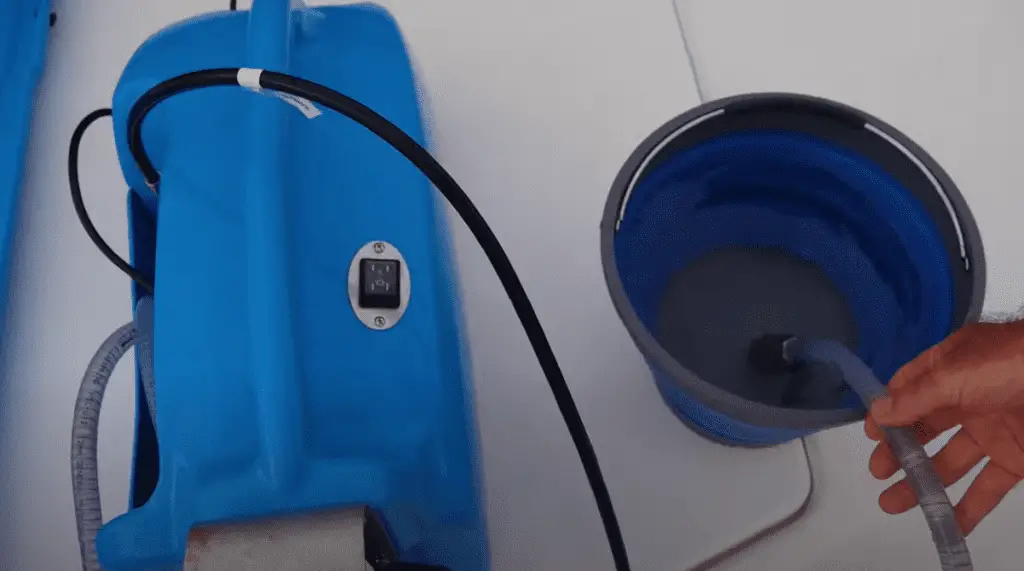
With a boat surrounded by water, there’s surely no such thing as dehydration out on the sea. Right? Well, not exactly. There’s way too much salt in seawater, and your kidneys would have to work overtime to filter it out. And to do that, they would need more water, which explains why copious amounts of seawater is toxic to humans.
So before you take a sip of that salty brine, why not pass it through a watermaker? The best watermakers for sailboats can take seawater and turn it into potable drinking water, giving you an infinite water supply to keep you hydrated and healthy on extended excursions.
What is a Watermaker?
Otherwise called a ‘desalinator’, a watermaker takes salty seawater and passes it through a process called reverse osmosis. This happens by pushing the water through a semi permeable membrane that allows the water molecules to pass through, but restricts salt, bacteria, and other organic material.
The clean, drinkable water is then passed into a water tank where you can then collect water for use. The remaining brine that was left during filtration is then tossed overboard and discarded. What’s nice is that these machines don’t use any chemicals, so there’s no risk of water contamination or pollution.
Some machines also use a pre or post treatment of the water using things like filters, sand, activated carbon, remineralization, or microfiltration to guarantee safe drinking water.
The Benefits of Watermakers

Modern-day technology has made it possible for manufacturers to develop more compact, efficient watermakers than ever before. This has also significantly driven down prices, making them far more accessible to sailors of all backgrounds.
Today, watermakers are recognized as a sailboat essential, especially for people who frequent the waves for long periods of time. Some of the benefits of these machines include:
Efficient Speed and Fuel Consumption
Yes, you read that right. Consider this - just 1 gallon of water weighs 8.3 pounds. If you’ve got 10 gallons on board, that’s equivalent to 83 pounds. A hundred gallons, and you’ve got an extra 830 pounds on board.
Watermakers allow boat owners to shave down their total weight. This lets you sail more efficiently, allowing faster speeds and lower fuel consumption which is important when you’re planning to sail long distances .
More Floor Area
Without a watermaker, you’d have to find room on board for the several tens or hundreds of gallons you need to bring with you. That also entails finding a place on your boat to store these water vats, which would obviously require significant room.
The watermakers of today are compact and lightweight. They can be either modular or self-contained, giving you different options to match your boat’s floor plan and use as little space as possible.
Safe Sailing
To ensure safe sailing, some studies have found that dehydration might actually be the reason for poor sailing performance. With dehydrated captains feeling lightheaded, achy, tired, and confused, it becomes increasingly likely to run into an accident that could endanger the lives of the people on board.
A watermaker guarantees that there will be fresh potable water at the ready any time you might need it. This doesn’t only curb the chances of dehydration, but also provides a solution for a variety of health conditions including diarrhea and various types of infections.
Extended Sailing Duration
You’ll only be able to sail for as long as your supplies on-board last. As your drinking water runs low, you’ll find yourself having to find the nearest dock to replenish supplies every so often. That’s if there are docks and shores you can access throughout your route. But what if there aren’t any?
Having the necessary equipment on board to extend your supply also means that you won’t have to rely on on-shore facilities to see you through your trip. This gives you more independence and flexibility as well as reducing the need to calculate complicated logistics.
Easier Boat Maintenance
Whether you’re underway or parked at the dock, your watermaker can help streamline boat maintenance by bringing freshwater straight to your vessel. With no need to collect buckets of water to lug back on board for a washdown, you can cut back the time and effort it usually takes to keep your boat clean.
Lots of boat owners even use their watermaker to give their boats a quick clean while they’re out at sea. This helps get rid of accumulated filth and dirt, reducing the need for a tedious deep clean once you get back to the dock.
The 3 Best Watermakers for Sailboats
Back in the day, watermakers were a luxury for the rich and the capable. But today, they’re incredibly affordable and easily accessible. Needless to say, manufacturers have also taken liberties with designing their own machines.
For you, that means an endless list of watermaker bets that could easily screw up your choice. So to help narrow down your options and lead you to the right one, here are our top 3 vetted picks:
1. Katadyn Power Survivor 40E Watermaker Desalinator

Small yet powerful, the Katadyn Power Survivor 40E is a reliable workhorse designed for boats with a small crew population of 2 to 3. This modular unit provides 1.5 gallons of water per hour, and draws only 4 amps from a 12-volt system, making it one of the most energy efficient desalinators out there.
This ‘Energy Recovery’ system works to desalinate seawater at just a fraction of the energy used by other watermakers in the same segment. Thus the device gets its name: Power Survivor.
Silent and lightweight, the machine lets you separate its primary system components so you can install the device seamlessly even in tight or awkward, irregular spaces. Most of its parts also come with a 3-year warranty, giving you that extra peace of mind versus damages and malfunctions.
2. AMPAC USA SeaPro Saltwater Desalination RO Watermaker

Able to produce 100 gallons per day, this watermaker was designed for use on small power boats or sailboats. Its super quiet automatic operation features intuitive controls that let you start and stop the desalination process with the push of a button.
Equipped with a noise pulsation dampener, the sounds produced during operation are negligible at best. This lets you run the machine in the evening to store up clean water for the next day without having to disturb your crew’s peace and quiet.
For boats with limited space, the SeaPro comes in a modular design that’s perfect for tight floor areas. It also comes in a partially mounted compact frame option that lets you fit the desalinator in place with little time and effort.
3. Rainman 12 Volt DC Watermaker
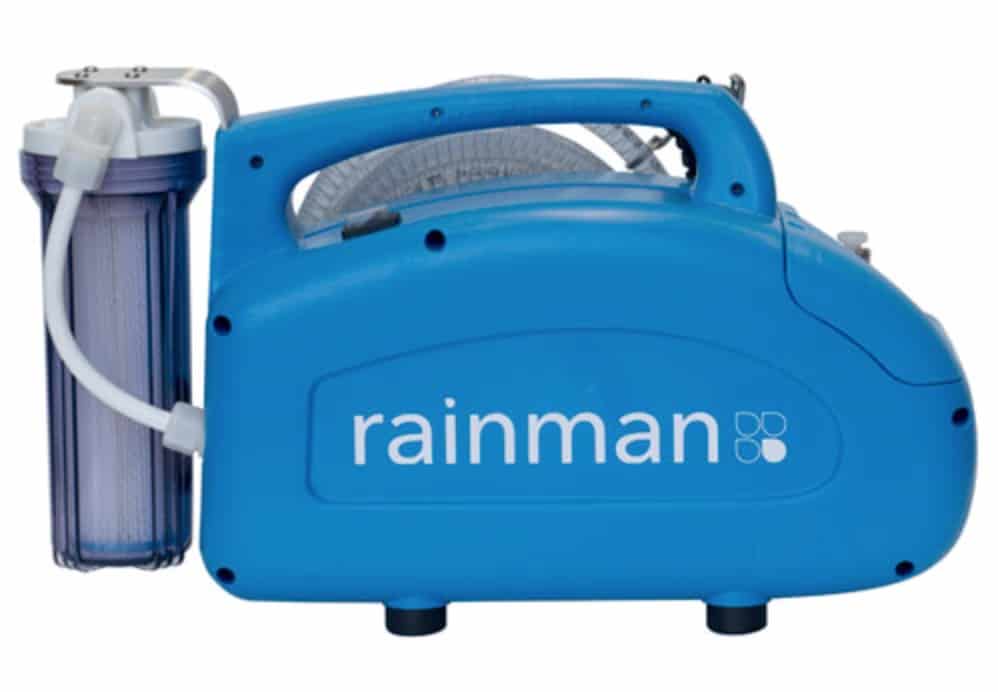
According to Rainman, their 12 Volt DC Watermaker consumes the least energy, able to filter 9 gallons of water per hour. The design touts a two-part system -- one pressure supply unit and another reverse osmosis unit. The former lifts the seawater from the source, while the other performs the desalination process.
What’s unique about Rainman’s watermaker is that the design gives you the option to install the unit directly to your boat, or to keep it handy as a portable watermaker system. This offers immense flexibility, allowing you to set up or take down your system as your situation calls for.
Aside from all of that, the Rainman Desalinator also features a streamlined control panel that makes everything easy to understand and operate at a glance. It also comes equipped with its own LED salinity sensor that tells you when water is good enough to store in your tank.
Choosing the Right Desalinator Watermaker
Not quite sure which one is right for you? Here are a few factors worth taking into consideration when buying a watermaker.
Size and Installation
There are two major options: modular and self-contained. The modular system lets you take the unit apart to install each part at a different part of your boat. This one’s ideal for boats with limited space. The self-contained system has the entire unit built together, which means it has to be installed as one piece.
Gallons Per Hour
How big is your crew? More people means you might need a watermaker with a higher GPH. Smaller machines capable of 1.5 to 2 GPH might be good for crews of 2-3 persons. But larger boats may need several hundreds of GPH to meet all of the crew’s needs.
* See: What size Yacht will Require a Crew?
Non-Proprietary Parts
You’re going to make part replacements one way or another. See to it that you’re buying a machine that uses non-proprietary parts so you can purchase the necessary replacements anywhere online.
Warranty and Services
In case anything happens to your watermaker, who will be there to help you fix it? Check the warranty coverage and see how long the manufacturer is willing to cover it for damages and malfunction. It’s also important to make sure there’s a nearby service center to cater to your needs in case of damage.
Water You Waiting For?
The best watermakers for sailboats offer to give you a virtually endless supply of clean drinking water when you need it. But there are a ton of choices on the market, so it pays to know what you’re getting before you shell out that cash. Consider our bets for the best desalinators for your sailboat, and keep your crew happy, healthy, and hydrated all along the way.
Related Posts
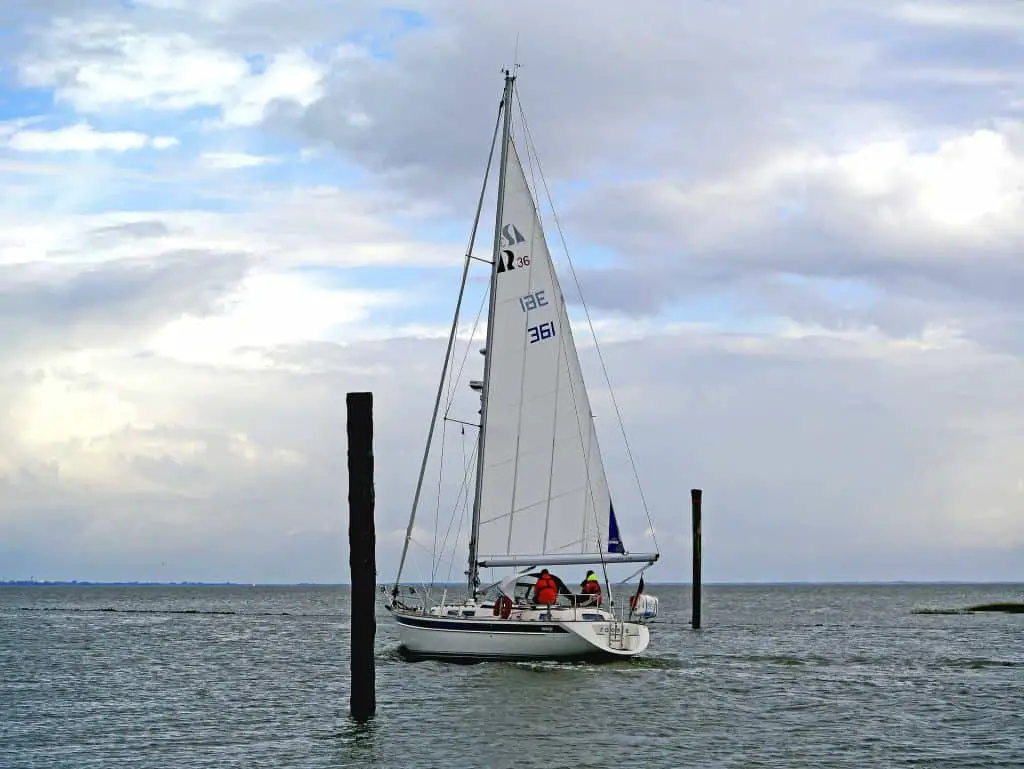
Best Life Jackets for Sailing [Top 7 Reviewed] in 2023

Why Do Yachts Have Two Steering Wheels? (The Reasons)
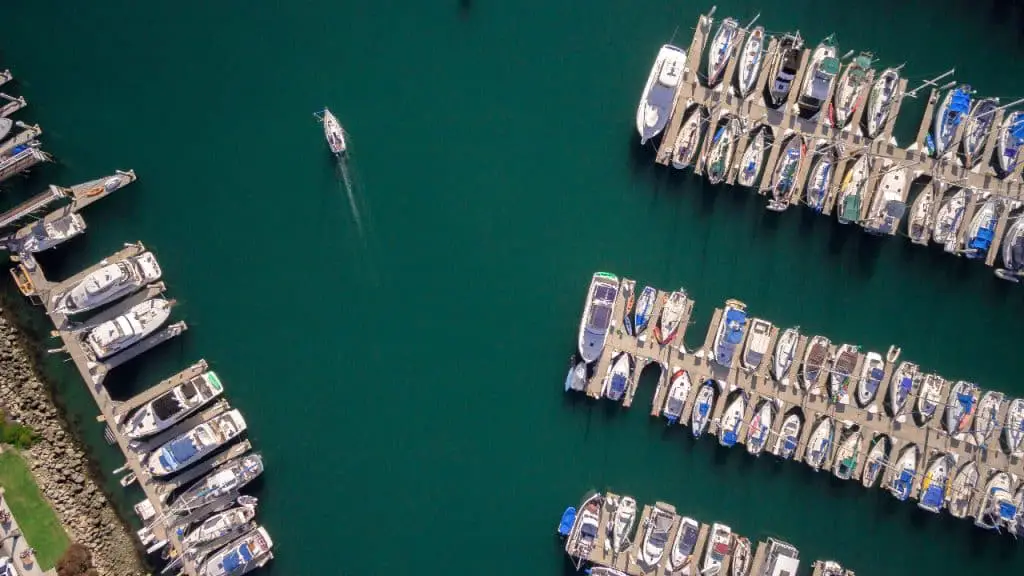
How to Become a Yacht Broker: Requirements Explained

How Much Does a Deckhand Make on a Yacht? (Salaries)

- MarketPlace
- Digital Archives
- Order A Copy

Building your own watermaker
Modern technology has brought us many new devices that make the cruising life much safer and easier. Since we are not interested in camping out while cruising, obtaining safe and clean fresh water has always been a major priority, especially overseas. The three most common ways of obtaining fresh water on a cruising boat are: 1) an effective rain collection system, 2) from shore via a hose, or 3) a watermaker. Given reasonable storage capacity and a good filtration system, a high-capacity watermaker is the most efficient — especially if you are a boonies cruiser.
A reverse-osmosis watermaker takes clean seawater and, by pushing it through a specialized membrane (special filter) at relatively high pressure, makes fresh water. This means that no longer do we have to carry hundreds of pounds of extra fresh water just to ensure we don’t run out. Also, we no longer must get up in the middle of the night to catch rainwater, or search out places ashore where we can jerry-jug water from sometimes expensive or suspect sources.
Watermakers suitable for use on a cruising boat can be obtained from a number of sources depending on your budget and tolerance for electronics gadgetry. But they all do the same thing: make fresh water from seawater. We think that if you are going to have a watermaker aboard, it should have bulletproof — and mainly mechanical — equipment with minimal electrical and electronic parts; use commonly available (not proprietary) components; make the most water practical in the shortest time (40 gallons per hour is our choice); and be repairable with onboard spares, tools and skills.
As an example, we use about 50 gallons of fresh water a week for daily cooking, drinking, showering and cleaning. A 40-gph watermaker with two 40-inch membranes can make that in one and a half hours with setup and flushing time included. Smaller units can take significantly more time to do the same work, thereby seriously affecting a cruiser’s free time.
An engine-driven pump Because the power needed to run this volume through the membranes is more than 2 hp and a 12V motor won’t handle that, we have chosen to belt our watermaker pump to our main engine on our last two boats. This is similar to an alternator arrangement. You can drive a watermaker pump with a generator, but using only a generator puts another expensive, sometimes cantankerous and complicated piece of mechanical/electrical equipment between you and fresh water. If the generator fails, as they sometimes do, you are back to spending hours per week manually collecting fresh water from rain or shore.
We most often run the watermaker when underway and moving the boat. Infrequently, we run it at anchor and sometimes just flush it with fresh water to satisfy the once-a-week run requirement that prevents biologic buildup on the membranes.
We average less than 10 hours per year in the tropics using the engine just to operate the watermaker.
If you decide to make your own watermaker, there are several sources of information on the Internet, including my guide. Fifteen years ago, it took me quite a bit of time to engineer the specifications, develop a parts list, and then find and purchase the equipment. By that time, I had seen two successful DIY units, so I knew it could be done. I used a mix of some used and some new parts, mainly because I was on a tight budget. Since then, I have refined the unit somewhat, installed two units on our boats and helped several other cruisers do their own using my information.
Extensive engineering details are on our website under “CSY Workshop,” and we have a PowerPoint slideshow in our “Presentations” section. There is also a Seven Seas University webinar I did for SSCA a couple of years ago, with the slideshow narrated.
Better than the WHO standard My first unit on Soggy Paws , our CSY, was still in service after eight years when we sold the boat in 2016. It had the original pumps, membranes and fittings, and was belted to our 60-hp Perkins. It was still producing fresh water that tested to about 250 ppm (parts per million solids content). The World Health Organization standard is 500 ppm.
Because I was careful never to run my watermaker in dirty or silty locations, in addition to having two pre-filters, I never had to clean the membranes in eight years.
The second installation on our catamaran is now belted to a 27-hp Yanmar 3GM30. It has a different mounting configuration, and after four years of use still produces water at less than 200 ppm. There are many ways to mount a pump to an engine; you just need to be able to tightly tension the belt drive around the crankshaft pulley. You want to use an appropriately sized pulley to run the watermaker at near full rpm from an engine running around 50 percent of its maximum rpm.
Once you have all the parts, any competent cruiser should be able to install a watermaker in a week. It took me two weeks — but then I never claimed to be competent, just thorough.
As with ground tackle, we think bigger is better, within reason. So if you don’t have a watermaker yet, consider easing your cruising workload and making the crew happy by obtaining a watermaker. Then you can wash dishes in fresh water, take freshwater showers every day, and not worry about using too much water — just like normal people.
Dave McCampbell is a retired U.S. Naval diving and salvage officer with over 40 years’ cruising and eight sailboats’ worth of maintenance experience. He and wife Sherry, currently cruising in Southeast Asia, spent eight years crossing the Pacific via Easter Island, Hawaii and Micronesia. Prior to that, they circumnavigated the Caribbean over four years. Their most recent excursion was a 7,000-nm journey from the Philippines to the lower Solomons via eastern Indonesia and Papua New Guinea. Four years ago they sold Soggy Paws , their CSY 44 monohull of 19 years, and moved to the “enlightened side,” purchasing a new Soggy Paws , a St. Francis 44 catamaran. Their extensive website is at SVSoggypaws.com .
By Ocean Navigator

- Rainman Watermakers
Because making water, should not be so complicated
Rainman watermaker systems can be purchased in a portable or installed system. Convert between configurations as to best suit your needs.
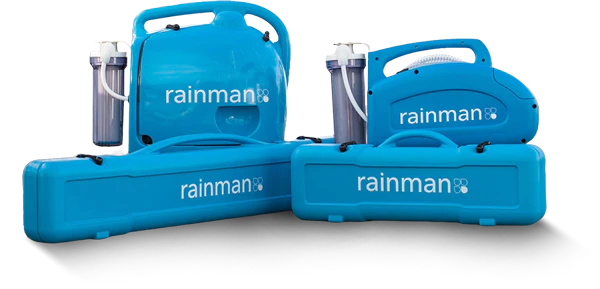
Worldwide shipping available –
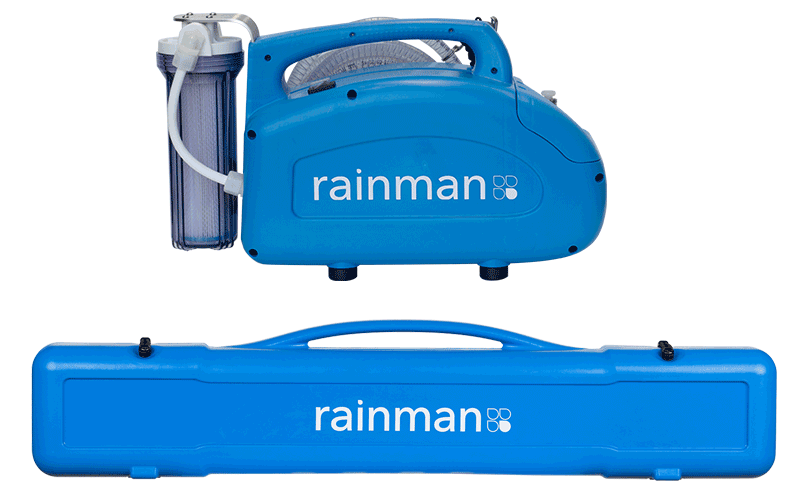
Portable Watermakers
Portable Rainman Watermaker systems are ideal for applications with AC or DC power onboard.
No Installation required, ready to go in 10 minutes!
Download Manuals
Operation Manual – Electric (AC or 12VDC) System v2.81
Quick Reference Card – AC Electric
Quick Reference Card – 12VDC Electric v2.1
Rainman Mk1 Electric PSU Case Removal v1.2
Dow Filmtec SW30 RO Membrane Manual
Sodium Metabisulphite Material Safety Data Sheet
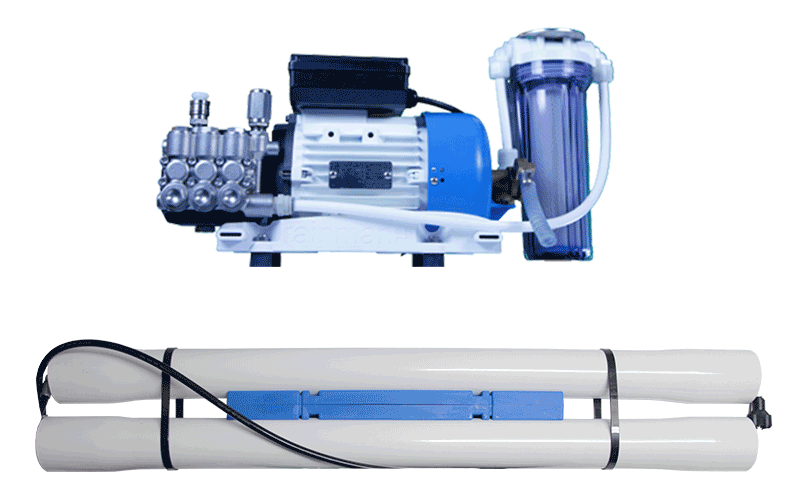
Installation Watermakers
Rainman Watermaker’s are ideal for installation, single motor configuration, hardware included.
Take the stress and expense out of installation.
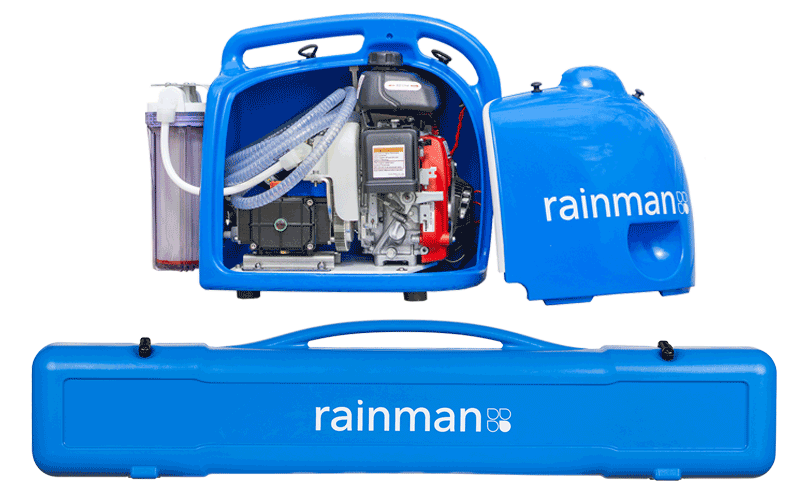
Gasoline Watermakers
Gasoline Watermakers are ideal for true redundancy. Ideal for applications with no power.
Flexibility for taking it ashore.
Operation Manual – Petrol (Gasoline) System v1.7
Quick Reference Card – Petrol (Gasoline) v2.1
Honda GXH50 Motor Manual
Use the System Guide to help choose your Rainman Watermaker
ACCESSORIES
Spare parts & consumables.
- Pickle Solution
- (RO) Membranes
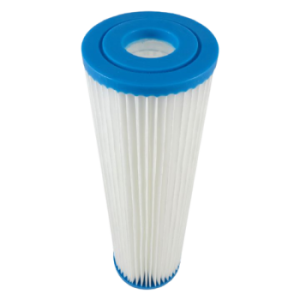
Your new Rainman watermaker comes with 5 prefilters (one fitted and four spares). Depending on the source water, each filter should last between 5 and 50+ hours. They are non-proprietary and readily available around the world.
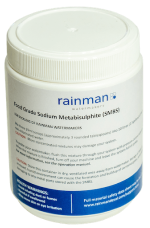
Your new Rainman watermaker comes with a 1 kg (2.2 lb) tub of food grade sodium metabisulfate. You only use 3 tablespoons when you store the system for extended periods, so this tub should last quite a long time. We normally do not recommend extra pickle solution mix at the time of purchase.
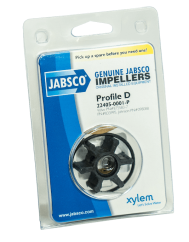
The impeller requires changing every year or two. We use standard sized impellers that can be sourced from Jabsco, Johnson, Oberdorfer, etc. They are inexpensive and small, so it may be worth keeping a spare on hand.
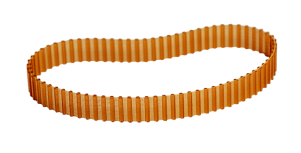
If you have this system, there is a drive belt that should last for many years. Although it is generally unnecessary, some customers prefer to keep a spare. The electric watermakers do not use a drive belt.
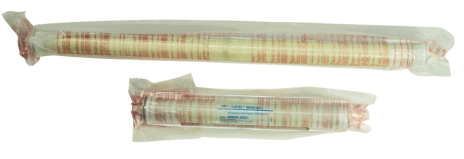
When properly taken care of, your RO membranes should last between 5 and 10 years. We do not recommend customers carry spares. Rainman utilises DuPont Filmtec membranes, which we believe are the best in the world. They are non-proprietary sized and readily available. The TDS (total dissolved solids) readings of your product water will increase over the years, so most people look to change membranes when it climbs near 800 ppm (parts per million) of TDS.
Total System Overview
RAINMAN WATERMAKER
Desalination systems.
There’s Water Everywhere Demand for fresh water has increased dramatically in recent decades.
Many of us now expect daily fresh water showers with pressurized plumbing and unlimited drinking water. Having an operational desalination system available provides independence and flexibility.
Rainman watermakers provide clean, reliable and convenient fresh water regardless of your location. Onshore, Rainman Watermakers provides rescue teams, property owners, survivalist and off-the-grid facilities with a clean and reliable source of fresh drinking water for personal or operational use.
Until now, the only option has been a complex built-in desalination system. The high expense, complexity and maintenance of such systems have been daunting, often requiring downtime and technician call outs for maintenance or repairs.
Introducing the worlds first easy to use, low maintenance and inexpensive watermakers that doesn’t need to be installed and is built to operate as a fully functional primary system. Providing an uninterrupted water supply, and peace of mind that won’t break your bank.
With our range of portable and installation Rainman Watermakers and Desalination systems, these simple to operate watermakers are capable of producing up to 37 Gallons/hour, and if the requirement to permanently or partially install your Rainman Watermaker into your vessel, the system can be integrated at will, without a complex installation.
Portable or Installed configurations
Rainman Watermakers are available in Portable and Installed configurations. Each can be converted to the other for maximum flexibility! Portable and installed systems allow for you to choose the best fit for your application as your preference changes.
PORTABLE WATERMAKER
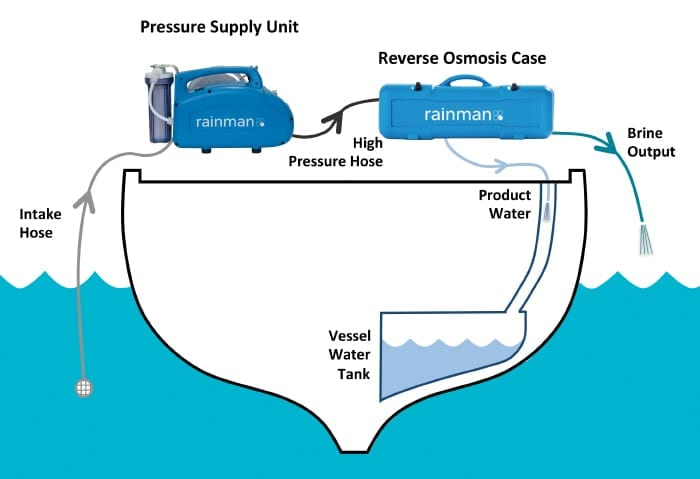
The Rainman Watermaker portable configuration comes ready to go right out of the box. With set up of your portable desalination taking as little as 10 minutes, you can benefit right away from a fully functional, and extremely robust portable desalination system without the cost and downtime of complex installations.
INSTALLATION WATERMAKER
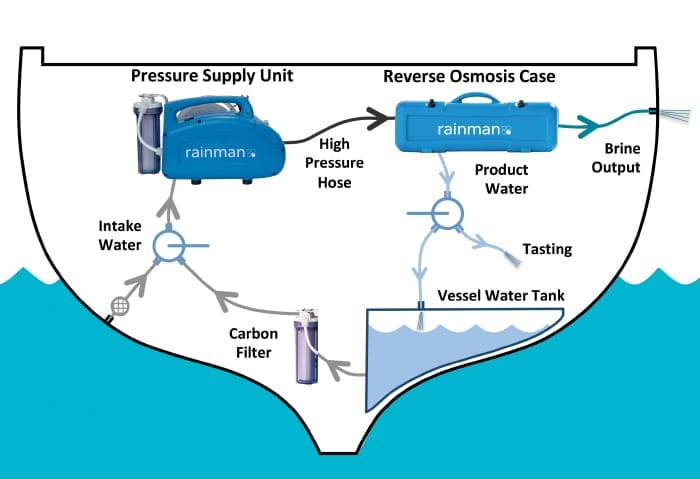
Rainman watermakers can be installed within there sturdy cases, or as a traditional installed module. This gives you the flexibility should you choose to install your watermaker immediately, or if even you decide to in years from now. A range of accessories are available to help you install your Rainman watermaker in our parts store.
Electric or Gasoline Watermaker
Rainman Watermakers are solid, robust portable desalination systems designed for the extremes of a maritime environment and built with ingenuity, with the most popular of our systems needing only a small portable generator to operate, and our gasoline systems being completely independent and backed by the global and prestigious Rainman Honda warranty. Check out the videos below to watch out most popular portable desalination systems in action and why you too will fall in love the Rainman Watermakers.
ELECTRIC WATERMAKER
Rainman watermakers are quick and easy to setup, yet very simple and reliable to operate. Our 115V rainman desalination systems are the most popular system on the market.

GASOLINE WATERMAKER
True portability, our gasoline systems require no external power, and are the icon of true efficiency. 1 gallon of gasoline equals 140 gallons of water. No Power, No Problem.
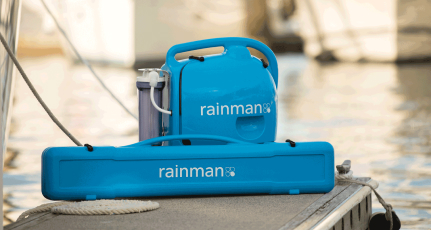
Helpful Links

Empowering Your Marine Adventures
Contact number
We are monthly supporters. click below to donate..

- HVAC & Refrigeration Services
- Marine Solar
- Marine Electrical Systems
- Solar Frame Fabrication
- Standing Rigging & Forms
- Running Rigging & Forms
- Lifeline Rigging & Forms
- Anchor Chain & Rode Form
- DIY Marina Wet Slips
- Haul-Out Facilities
- Sailboat Arches
- Stern Arch & Davit Install
- Blue Wave USA
- Cyclops Load Sensors
- Robline Ropes
- Marlow Ropes
- Mantus Marine
- Tides Marine – SailTrack
- Anchor Chain and Rode
- Waterline Design
- Furlex Furling Systems
- Selden GX & CX Furlers
- Selden SMF System
- Bamar Products
- Hood Furling Systems

- Victron & Solar Panel Store
- Kilovault Batteries
- Custom Fabricated Frames & Arches
- Mabru Air Conditioners
- Velair Air Conditioners
- Spectra Watermakers
- RuuviTag Pro
- Integrel Solutions
- Manuals/Catalogues
- Account details
ARCH INSTALLATION TIPS
- Measure where you think The arch feet are going to land on the back of the boat, pick either the front or back leg landing positions and measure the span. Check for backing plate/nut access at these positions.
- Assemble the arch laying on dock and slide the sides into the bridge evenly until the leg span you measured is Approx 5-6” wider than your goal span. Tape the joints at the bridge using masking tape to stop it sliding further in when you are test fitting.
- Measure the “drop” from where you think the forward legs will land and the aft legs will land and trim the forward legs. Accordingly. I usually leave them a couple inches longer than I think they need to be, and do the final trim once I’m at the mocking up stage.
- Assemble the arch feet and install them, using string to secure them to the arch legs using a rolling hitch.
- Use a block and tackle or a truckers hitch to squeeze the legs together to match the span you are aiming for. No more than 6”.
- Hoist arch into position using topping lift or main halyard (and two people) and test fit. At this point you can measure exactly how much you need to trim off the forward legs to make the arch fit level.
- If the arch needs to sit lower, once you have it level, you can trim both legs the same amount. Keep in mind that as the arch gets shorter the span will narrow slightly due to the geometry of the arch.
- Once you like the position, mark the feet in their positions using sharpie and lower the arch back to the dock. Release the block and tackle and drill/bolt the bridge. Drill and epoxy/bolt the feet into position.
- Hoist the arch again and check all landing positions on feet one final time. Mark bolt holes on gelcoat and move arch out of the way for drilling. Try to pick the forward or aft feet and do them in pairs, pick whichever set you think will allow you to bolt it down securely then pivot the arch back or forward to do the other pair after (check orientation of arch feet for pivot ability).
- Through bolt all feet and tighten. If fitting to an uneven surface, back fill the area behind the plate with thickened epoxy.
- Tighten all bolts on foot bases.

Salt Creek Marina and Yard Rules & Regulations (DIY & Storage)
“Common Sense, Compliance with Laws, Consideration Toward Others” (January 1, 2023)
This agreement shall be effective on the date hereunder by and between the undersigned Owner or Agent of the vessel(s) hereinafter (“Vessel Owner”) described below and Salt Creek Marina, Inc. and The Yacht Rigger LLC located at 107 15th Ave SE, St. Petersburg, FL 33701.
8/21/2023 UPDATE – If a hurricane system becomes a named storm and your boat is in one of our wet slips you MUST move it back to its original berth. The boat is not allowed to stay. The owner is responsible for planning with their preferred captain, or The Yacht Rigger has two captains on staff.
1. Fees: The Yacht Rigger and Salt Creek Marina reserves the right to change its rates upon one (1) months’ notice.
- Monohull DIY Dry Storage will be $900 monthly or $225 weekly, with a minimum of 1 week required. After the first 4 weeks, the rate will increase by $50 per week, for the remainder of the boat’s duration.
- Monohull Wet Slip will be $1,100 monthly or $275 weekly, with a minimum fee of $100.
- Catamaran Wet Slip will be $2200 monthly or $550 weekly.
- Haul / Block / Relaunch – One Time Charge $12 per foot
- Emergency Haulout – $25 per foot
- Short Haul – – – Special Haul to be scheduled by The Yacht Rigger or approved contractor only + $175 contractor fee (includes normal haul out rate)
2. Insurance: Vessel owners must provide insurance with Salt Creek listed as additional insurer on their vessel before arrival. Vessels must always be insured.
3. Hurricane & Summer Storm Season: June 1 – November 30 Haul out boats for storage or DIY work on the hard during this time are required to remove all canvas (including but not limited to Bimini, sail covers, dodgers, e.g.) as well as all sails on the boom or furlers. Remove all moveable equipment: canvas, sails, dinghies from davits, cushions, water toys, grills, biminis, roller furling sails, etc. Canvas and sails must be stored below and not on deck. Lash down everything you cannot remove tillers, wheels, booms.
4. Live Aboard – Wet Slip Only (Yacht Rigger Only Rule): Starting January 1st, 2024, customers may NOT stay on their vessel during electrical refit work or other major modifications or upgrades down below. Due to the nature of these projects requiring major upheaval down below within your living space and the need for our teams to work efficiently. Rigging and “above deck” type work will permit liveaboards. As much as we would love to accommodate liveaboards during this time, it is simply too inefficient for us and expensive for you, the customer. For vessels with excessive items on board preventing efficient work, we will provide on-site storage pods at market rates.
5. Third Party Warranties: This includes any warranty claim that is to be made against the original manufacturer or seller of the vessel or product. Should a warranty claim arise, The Yacht Rigger will estimate the job accordingly. It will then be up to the customer to obtain approval from the applicable 3rd party (boat manufacturer, spar manufacturer, etc.). If approved & immediately upon completion of the warranty issues, the customer is solely responsible for the payment of the work completed. It is then the responsibility of the customer to be reimbursed by the applicable 3rd party.
6. Yard Hours: The boatyard hours are 8:00am to 6:00pm, Monday- Sunday. The boatyard gate locks at 6:00pm. You may come check on your vessel, re-secure rigging, canvas and pump out water during business hours. Please check in with the office if you are near closing hours.
7. Utilities: Boatyard provides power & water to vessel owners as a part of their agreement so long as the owner fully adheres to all Rules and Regulations. When you are finished with the water hoses, turn them off and place them back neatly in the area you found them. Please ask a Salt Creek Marina Boatyard Employee for access to either option.
8. Outside Contractors/ Subcontractors With Management approval (determined individually) contractors may work on a storage vessel for a fee of $40 a day in addition to monthly storage/dockage fee. The owner shall be responsible for informing the office of any subcontractor working on the vessel for any purpose whatsoever. The subcontractor shall submit insurance before any work can commence. Salt Creek Marina and/or The Yacht Rigger reserves the right at its sole discretion to stop unsafe work practices and if deemed necessary to order the offending worker(s) to leave the site at the Owner’s/Skipper’s sole risk and expense.
9. Supplies: All paint including but not limited to, bottom paint, primer or barrier paint, haul or topside paint, varnish or otherwise any paint being applied to your vessel must be purchased through the Boatyard or approved by Management. This policy is for safety and environmental protection purposes of all persons operating in the Boatyard. Paint will normally arrive within 24hrs of purchase.
10. Paint Spraying: There shall be no spraying in the Boatyard under any condition. Any person spraying any paint will be immediately expelled and fines levied.
11. Cleanliness: All vessel owners shall be responsible for keeping their area clean and professional. The Boatyard reserves the right to charge the vessel owner for any cleanup required to comply with RR. All debris associated with boat repair activities must be disposed of daily. A dumpster is located near the parking area.
12. Disposal: There is a designed disposal station of 55 gal drums for oil and one for oily rags and filters located near the office door. PLEASE DO NOT PUT GASOLINE IN THESE DRUMS.
13. Facilities: Bathrooms are provided as a courtesy to all Customers. We will make our best efforts to keep it clean but reserve the right to limit access any time. Please use the outside sink for heavy clean up and use the indoor head/sink for bathroom purposes only. The Yacht Rigger has its own set of facilities to be used by its staff and customers. Please do not use SCM facilities.
14. Parking: Park in the designated parking area. Vehicles should be parked clear of travel lift path, not in storage areas, on the seawall or blocking boats. Salt Creek Marina and/or The Yacht Rigger is not responsible for vehicles that are damaged by equipment or conditions in the yard
15. Regarding noise outside of the scope of work not being completed, i.e., radio/stereo volume, please be respectful of neighboring boat owners’ tenants.
16. Salt Creek Marina and/or The Yacht Rigger is not responsible for any theft or loss of items left on or around the vessel.
17. The yard takes no responsibility for accidents, injury, or death to any persons in or working within the yard at any time. All people wishing to enter the boatyard for any reason do so at their own risk.
18. Failure to comply with these rules and conditions can result in additional charges if Salt Creek Marina and/or The Yacht Rigger personnel are required to do site cleanup operations and/or will be asked to remove your boat from the marina.
19. Additional Rules:
- Owners are not permitted to test engines, run water for AC or other purposes while on the hard. All electricity and water shall be for the sole purpose of working on their vessel and disconnected when unoccupied.
- There are to be no mobile AC / Heater Units or Refrigeration Units to be run on the hard.
- No unfurling of sails will be permitted at any time, under any circumstance.
- There is to be no hot work, flame cutting, welding etc. to be done in the yard.
- Jack stands and blocking may only be used and moved by employees of Boatyard.
- Boatyard reserves the right to move vessels when needed without permission or notifying owners.
- Any trailer, dingy, mast, or other personal property not directly attached to the vessel must be pre-approved, additional charges will apply if approved.
- Packages – you are welcome to send packages to our address here, but please make sure they state your name and “CO The Yacht Rigger” and limit your packages to 5 a week.
Any modifications outside of these rules will be determined individually by Management. REMEMBER THESE RULES & REGULATIONS ARE FOR EVERYONE’S BENEFIT. PLEASE HELP KEEP THIS BOAT YARD A CLEAN & SAFE WORKPLACE. ** Salt Creek reserves the right to change these rules at any time.

Use coupon code to activate discount. Add to coupon code box on your cart page.
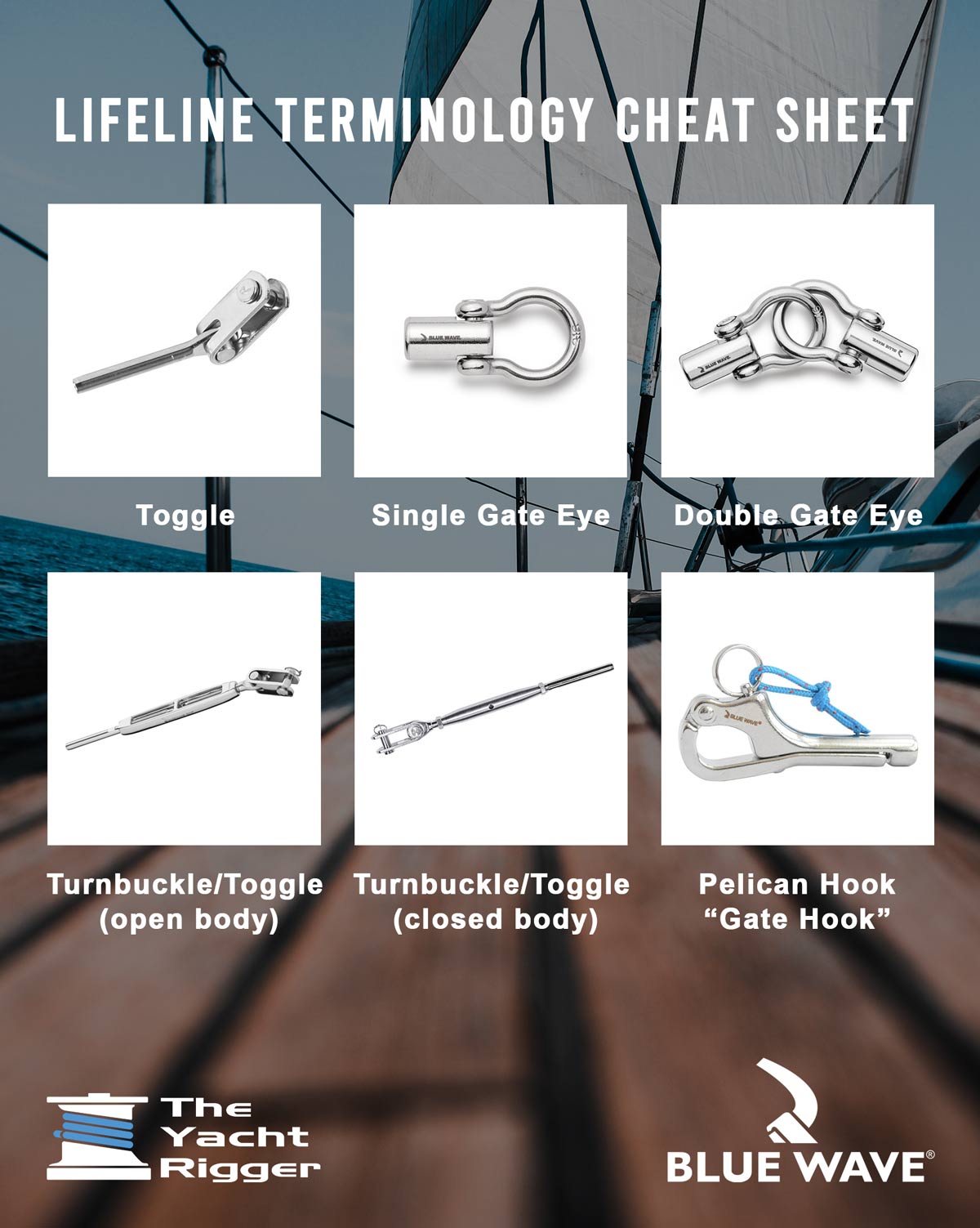

- BRACKISH WATER
- MUNICIPAL WATER
- ALL PRODUCTS
- ACCESSORIES
- THE FCI ADVANTAGE
- DISTRIBUTION
- TESTIMONIALS
- FIND A DEALER
- WARRANTY REGISTRATION
- DEALER PORTAL
THE FCI WATERMAKERS BLOG
The latest in watermaker and water purification technology and innovation..

Desalination: How It Works And Which System Is Right For You
Intro to how desalination works.
About 2.5 percent of the water on Earth is fresh. Of that, only about 1 percent is easily accessible. When you’re on a boat in the middle of the ocean, no fresh water is accessible at all. Fortunately, you’re surrounded by water and technology exists to make that water usable.

Desalination and Aristotle
The technology isn’t new. Aristotle described a desalination technique in the 4 th century BC in Meteorologica . There’s even a mention of desalination (although vague) in the Bible (Exodus 15:22-26). Large-scale desalination was developed in the 1930s and has been a critical source of fresh water in many parts of the world since then.
In this article, we’ll discuss the basic principles of desalination (how does a desalinator work) with regards to the two main types: reverse osmosis and thermal. We’ll talk about which type of desalination system is used for boats and some things to consider when choosing your system.
But first lets define and describe a few basic concepts.
Desalination Definition
Desalination is the process of removing salt and minerals from a target substance. This is how it is defined at dictionary.com.
So, simple put for the purposes of this article, its the process used to make fresh, drinkable water from sea water. This process essentially allows you to drink salt water.
How is Desalination different from Water Reclamation
Desalinated water is not the same as reclaimed water. Waste plants across the country reclaim waste water. This process removes waste products and cleans the water. The scope of this article does not cover reclaiming water. Continue reading to learn about desalination.
How to Desalinate water with Thermal Desalination
Thermal desalination was the first desalination method to be used on a large scale in the 1930s. There are 3 main types of thermal desalination— vapor compression (VC), multi-effect distillation (MED), and multi-stage flash distillation (MSF). The different types of thermal desalination vary in their efficiency, but they all follow the same basic principles. Essentially, thermal desalination systems mimic the natural water cycle.
The water is evaporated, accumulated, and condensed. The condensed water is then free of salt and impurities. Because thermal desalination requires heat, it can often be linked to power plants and refineries, which produce heat as a by-product of existing processes. On the other hand, this heat requirement makes thermal desalination less than ideal for marine use.
Reverse Osmosis
Instead of evaporation, reverse osmosis uses a filtering system to remove salt and impurities. Salt water is forced through a semi-permeable membrane. Salt and impurities are trapped in the membrane and the water that comes through is fresh. The process requires high amounts of pressure (600-1200 psi for saltwater), but requires less energy than thermal desalination.
Watermaker On Board
Most marine desalinator units that are currently available for smaller cruising vessels use reverse osmosis. There are small evaporation units out there. When choosing the right system for your boat, there are some important questions to ask.
The first is whether you should be looking at 120/220-volt AC systems or 12- or 24-volt DC systems. If your boat will have its own generator, you should be shopping for the former. Smaller boats that aren’t using a generator should probably opt for a 12- or 24-volt DC system. With good weather, a wind generator or solar panel should be able to keep up.
The next thing to consider is the size (output) of your system. The U.S. Coast Guard recommends having 30 gallons of fresh water available for each person on board per day. For example, if you have 4 on board your vessel, you’ll need about 120 gallons a day. You’ll then need to determine how many hours a day you’d like to run your water maker.
Most people run their water makers between 2 and 5 hours per day. So, for the example above, if you’re willing to run your watermaker for 2 hours a day, you’ll need a water maker that’s capable of producing 60 gallons of fresh water per hour.
Desalination has been around for thousands of years in one form or another. With advances in technology, it has become practical and trusted enough to be relied upon as the only source for fresh water. Reverse osmosis has made reliable desalination possible for owners of small and large ocean-going vessels.
It’s important to choose the correct system for your boat, but it’s a relatively simple process once you know the right questions to ask. For more information regarding your fresh water making needs, visit FCI Watermakers or view our full marine and commercial product line – we are the true innovator of marine reverse osmosis systems.
Share this:
- Click to share on Twitter (Opens in new window)
- Click to share on Facebook (Opens in new window)
GET SUPPORT
Replies will be sent to the email you provide.
DOWNLOAD SPEC SHEET
Your spec sheet will be sent to the email you provide.
GET A QUOTE
Contact fci watermakers.
call +1 (714) 432-9996
+1 (714)432-9996
+1 (844)309-7501

Reverse osmosis & water treatment systems
- Expertise >
- Engineered Solutions >
Desalination System for Boats

Access to continuous production of freshwater while on a boat by means of a desalination system like reverse osmosis is a prime solution to many of the inconveniences water tanks impose. This process is one of the most effective methods of supplying freshwater onboard. A desalinator will save the weight and space of water tanks while producing freshwater on a boat or yacht on demand. As the weight on the ship decreases, the ship will simultaneously save energy and fuel during the venture. Additionally, the space that is normally used by water tanks and can be occupied for other purposes like added cargo or maybe more room for comfort. Having an unlimited amount of water supply also removes the restraining boundary of travel that freshwater supply requires. With a desalination system, there is no range that can possibly bind a travel venture as the need to refill water tanks or worrying about a limited amount of water supply would not exist. The freshwater that is produced can also be used for maintaining the boat itself. The usage of freshwater on the exterior leaves a much more flawless finish and will result in an immaculate exterior.
Since the majority of people utilize their watermakers for at least 5 hours per day, you will need one that produces a sufficient amount of fresh water by the hour. The conventional thought is that if your watermaker is running for 2 hours a day, then it should be generating more than 50 gallons of fresh water per hour.
Summary The desalination process has been used in some form for thousands of years with the first seawater reverse osmosis plant being constructed and running in the 1970’s. As further advancements in desalination systems for boats continue to enhance production capabilities, it has become the primary water treatment solution in many developing countries near the ocean. Reverse osmosis has even made the use of a deslinator a realistic option for users of small to large ocean vessels. It is imperative that the right desalinator is chosen for your boat, which can be done through simple questioning. The process will be easier if you are aware of the right questions to ask. Our engineers at Pure Aqua will be more than happy to answer any questions regarding the right desalination system to use on boats.
[custom-specifications]
Seawater is the most abundant source of water available for purification. Within the boat industry, freshwater is a major necessity. It is required for almost everything in terms of preparation, washdowns, and general water usage while onboard. Although freshwater is carried aboard for general applications, it also takes up quite a bit of space and inevitably weight that can be easily replaced with a water filtration system to additionally prevent the necessity of refill water tanks. A desalinator for boat would make an efficient alternative to water tanks for freshwater supply aboard. [/custom-specifications]
[custom-features]
Seawater Reverse Osmosis System:
Seawater Reverse Osmosis system is a desalinator that can produce freshwater from the seawater source. Through the process of reverse osmosis, water is pressurized via semi permeable membrane filters that only allow water molecules to pass; leaving behind all contaminants including salts. This process generates a permeate stream of freshwater and a reject stream of concentrated salts and contaminants that are disposed of overboard. Since the feed source of the system is seawater, the system is able to function continuously and produce fresh drinking water throughout transit. RO systems are comprised of advanced technologies that enable seawater to be not only suitable, but one of the most purified forms of water quality.
Related Projects:
- Commercial Watermaker Systems 8 X 4,700 GPD - Mexico
- Commercial Seawater Reverse Osmosis Filters 2 x 2,100 GPD - Peru
- Commercial SWRO Kit 3,000 GPD - Saudi Arabia [/custom-features]
[custom-usage]
- Mobilized desalination system for boats
- Lighten weight on board
- Saves energy + fuel
- Saves money in foreign ports
- Extends travel range
- Saves space
- Continuous production of freshwater
- Improves maintenance by using freshwater for wash downs
- 99.4% Stabilized Salt Rejection
Visit our benefits of desalination page for more information. [/custom-usage]

Pure Aqua, Inc. designs and manufactures water treatment syste...

Reverse Osmosis Brackish Water Treatment for Cosmetics 115 GPM...

Commercial Reverse Osmosis Systems 100 x 3,000 GPD - Sri Lanka...

We have a seawater water treatment system for the country of S...

SWRO Equipment Location: Maldives Capacity: 24,000 GPD Applica...
Posted by Jonathan B. on Apr 10th 2020
This was a fun read.

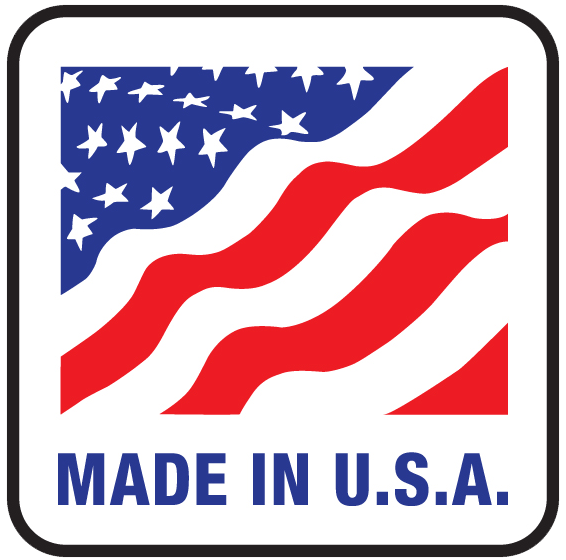
Our products are proudly manufactured here in Fort Lauderdale, Florida USA!
- Afghanistan (USD $)
- Åland Islands (USD $)
- Albania (USD $)
- Algeria (USD $)
- Andorra (USD $)
- Angola (USD $)
- Anguilla (USD $)
- Antigua & Barbuda (USD $)
- Argentina (USD $)
- Armenia (USD $)
- Aruba (USD $)
- Ascension Island (USD $)
- Australia (USD $)
- Austria (USD $)
- Azerbaijan (USD $)
- Bahamas (USD $)
- Bahrain (USD $)
- Bangladesh (USD $)
- Barbados (USD $)
- Belarus (USD $)
- Belgium (USD $)
- Belize (USD $)
- Benin (USD $)
- Bermuda (USD $)
- Bhutan (USD $)
- Bolivia (USD $)
- Bosnia & Herzegovina (USD $)
- Botswana (USD $)
- Brazil (USD $)
- British Indian Ocean Territory (USD $)
- British Virgin Islands (USD $)
- Brunei (USD $)
- Bulgaria (USD $)
- Burkina Faso (USD $)
- Burundi (USD $)
- Cambodia (USD $)
- Cameroon (USD $)
- Canada (USD $)
- Cape Verde (USD $)
- Caribbean Netherlands (USD $)
- Cayman Islands (USD $)
- Central African Republic (USD $)
- Chad (USD $)
- Chile (USD $)
- China (USD $)
- Christmas Island (USD $)
- Cocos (Keeling) Islands (USD $)
- Colombia (USD $)
- Comoros (USD $)
- Congo - Brazzaville (USD $)
- Congo - Kinshasa (USD $)
- Cook Islands (USD $)
- Costa Rica (USD $)
- Côte d’Ivoire (USD $)
- Croatia (USD $)
- Curaçao (USD $)
- Cyprus (USD $)
- Czechia (USD $)
- Denmark (USD $)
- Djibouti (USD $)
- Dominica (USD $)
- Dominican Republic (USD $)
- Ecuador (USD $)
- Egypt (USD $)
- El Salvador (USD $)
- Equatorial Guinea (USD $)
- Eritrea (USD $)
- Estonia (USD $)
- Eswatini (USD $)
- Ethiopia (USD $)
- Falkland Islands (USD $)
- Faroe Islands (USD $)
- Fiji (USD $)
- Finland (USD $)
- France (USD $)
- French Guiana (USD $)
- French Polynesia (USD $)
- French Southern Territories (USD $)
- Gabon (USD $)
- Gambia (USD $)
- Georgia (USD $)
- Germany (USD $)
- Ghana (USD $)
- Gibraltar (USD $)
- Greece (USD $)
- Greenland (USD $)
- Grenada (USD $)
- Guadeloupe (USD $)
- Guatemala (USD $)
- Guernsey (USD $)
- Guinea (USD $)
- Guinea-Bissau (USD $)
- Guyana (USD $)
- Haiti (USD $)
- Honduras (USD $)
- Hong Kong SAR (USD $)
- Hungary (USD $)
- Iceland (USD $)
- India (USD $)
- Indonesia (USD $)
- Iraq (USD $)
- Ireland (USD $)
- Isle of Man (USD $)
- Israel (USD $)
- Italy (USD $)
- Jamaica (USD $)
- Japan (USD $)
- Jersey (USD $)
- Jordan (USD $)
- Kazakhstan (USD $)
- Kenya (USD $)
- Kiribati (USD $)
- Kosovo (USD $)
- Kuwait (USD $)
- Kyrgyzstan (USD $)
- Laos (USD $)
- Latvia (USD $)
- Lebanon (USD $)
- Lesotho (USD $)
- Liberia (USD $)
- Libya (USD $)
- Liechtenstein (USD $)
- Lithuania (USD $)
- Luxembourg (USD $)
- Macao SAR (USD $)
- Madagascar (USD $)
- Malawi (USD $)
- Malaysia (USD $)
- Maldives (USD $)
- Mali (USD $)
- Malta (USD $)
- Martinique (USD $)
- Mauritania (USD $)
- Mauritius (USD $)
- Mayotte (USD $)
- Mexico (USD $)
- Moldova (USD $)
- Monaco (USD $)
- Mongolia (USD $)
- Montenegro (USD $)
- Montserrat (USD $)
- Morocco (USD $)
- Mozambique (USD $)
- Myanmar (Burma) (USD $)
- Namibia (USD $)
- Nauru (USD $)
- Nepal (USD $)
- Netherlands (USD $)
- New Caledonia (USD $)
- New Zealand (USD $)
- Nicaragua (USD $)
- Niger (USD $)
- Nigeria (USD $)
- Niue (USD $)
- Norfolk Island (USD $)
- North Macedonia (USD $)
- Norway (USD $)
- Oman (USD $)
- Pakistan (USD $)
- Palestinian Territories (USD $)
- Panama (USD $)
- Papua New Guinea (USD $)
- Paraguay (USD $)
- Peru (USD $)
- Philippines (USD $)
- Pitcairn Islands (USD $)
- Poland (USD $)
- Portugal (USD $)
- Qatar (USD $)
- Réunion (USD $)
- Romania (USD $)
- Russia (USD $)
- Rwanda (USD $)
- Samoa (USD $)
- San Marino (USD $)
- São Tomé & Príncipe (USD $)
- Saudi Arabia (USD $)
- Senegal (USD $)
- Serbia (USD $)
- Seychelles (USD $)
- Sierra Leone (USD $)
- Singapore (USD $)
- Sint Maarten (USD $)
- Slovakia (USD $)
- Slovenia (USD $)
- Solomon Islands (USD $)
- Somalia (USD $)
- South Africa (USD $)
- South Georgia & South Sandwich Islands (USD $)
- South Korea (USD $)
- South Sudan (USD $)
- Spain (USD $)
- Sri Lanka (USD $)
- St. Barthélemy (USD $)
- St. Helena (USD $)
- St. Kitts & Nevis (USD $)
- St. Lucia (USD $)
- St. Martin (USD $)
- St. Pierre & Miquelon (USD $)
- St. Vincent & Grenadines (USD $)
- Sudan (USD $)
- Suriname (USD $)
- Svalbard & Jan Mayen (USD $)
- Sweden (USD $)
- Switzerland (USD $)
- Taiwan (USD $)
- Tajikistan (USD $)
- Tanzania (USD $)
- Thailand (USD $)
- Timor-Leste (USD $)
- Togo (USD $)
- Tokelau (USD $)
- Tonga (USD $)
- Trinidad & Tobago (USD $)
- Tristan da Cunha (USD $)
- Tunisia (USD $)
- Türkiye (USD $)
- Turkmenistan (USD $)
- Turks & Caicos Islands (USD $)
- Tuvalu (USD $)
- U.S. Outlying Islands (USD $)
- Uganda (USD $)
- Ukraine (USD $)
- United Arab Emirates (USD $)
- United Kingdom (USD $)
- United States (USD $)
- Uruguay (USD $)
- Uzbekistan (USD $)
- Vanuatu (USD $)
- Vatican City (USD $)
- Venezuela (USD $)
- Vietnam (USD $)
- Wallis & Futuna (USD $)
- Western Sahara (USD $)
- Yemen (USD $)
- Zambia (USD $)
- Zimbabwe (USD $)
- Portable Watermaker Lithium Powered
- Portable Watermaker AC Powered
Portable Watermakers
+1-954-800-8800
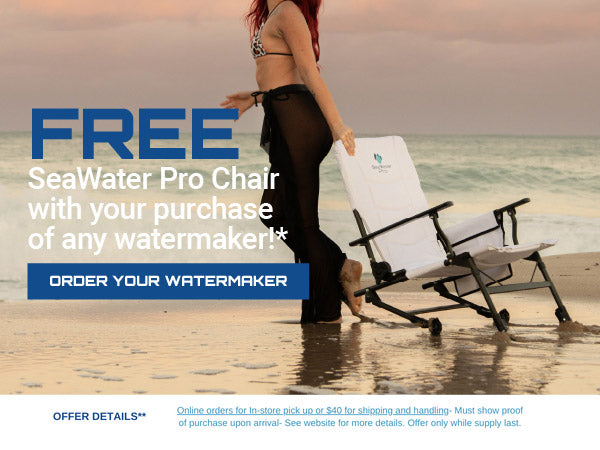
Offer Details*: Online orders available for in-store pick up or $40 shipping fee. Must show proof of purchase upon arrival. Offer only while supply lasts.
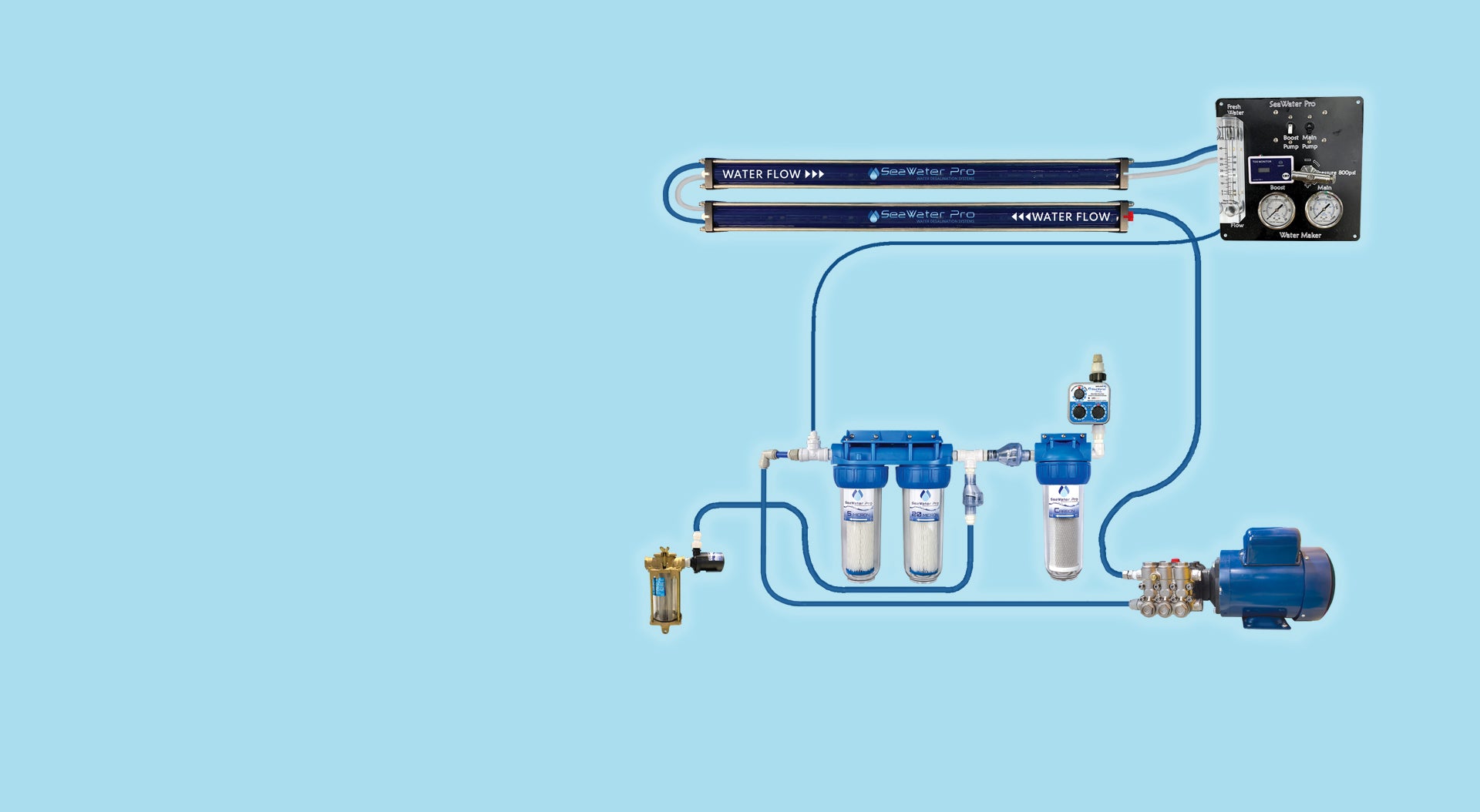
Don't Plan Your Trip Around Water.
Enjoy the purest water without limitations - easy and reliable.
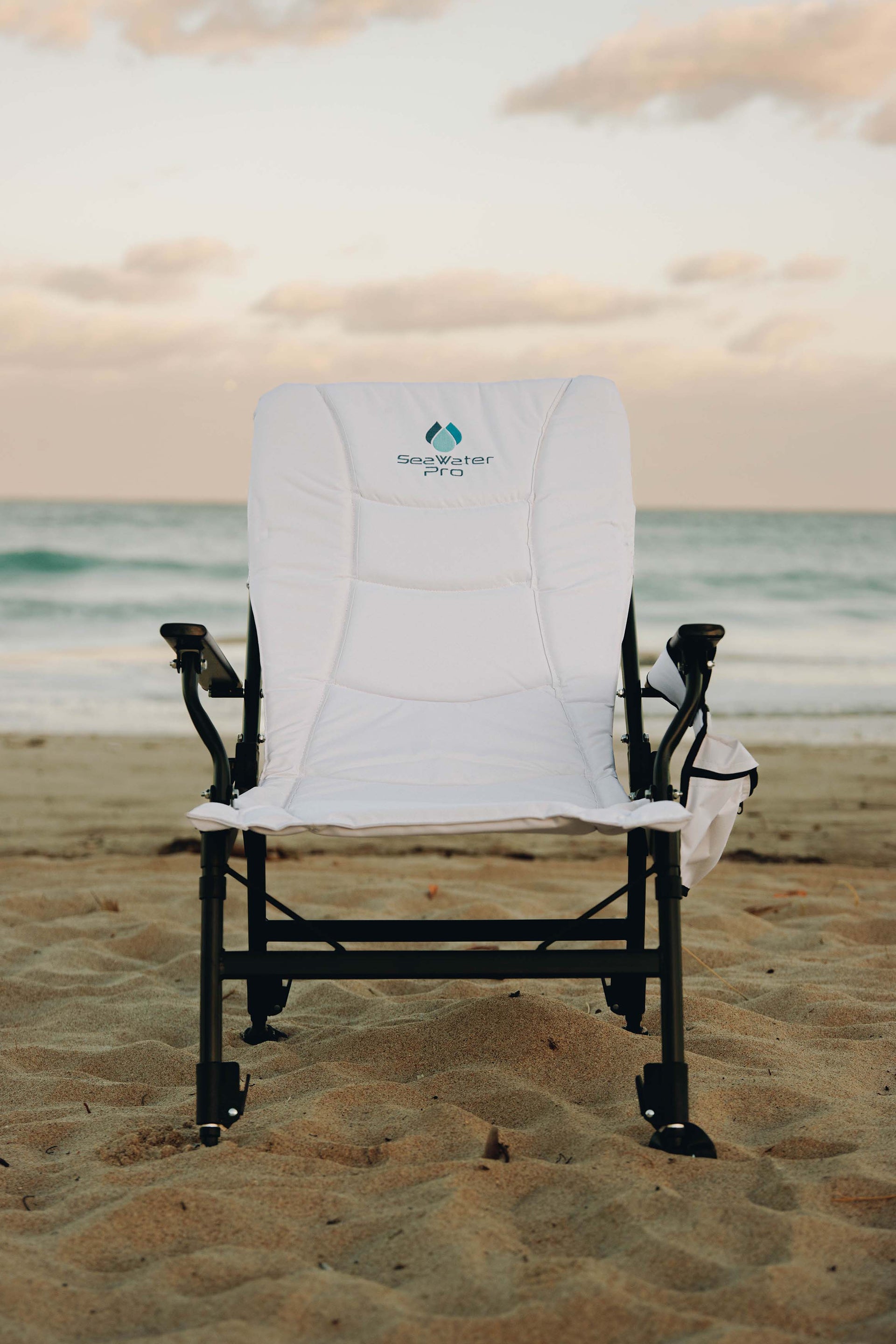
Exclusive SWP Boat Chair
Adventure with comfort and style. Find out how to get yours here!
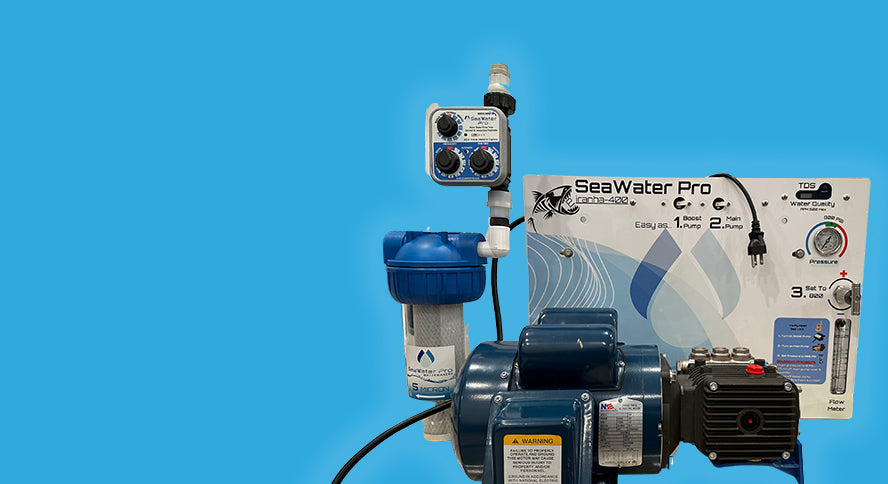
Plug & Play
Pure water. Pure style. Easy compact options.
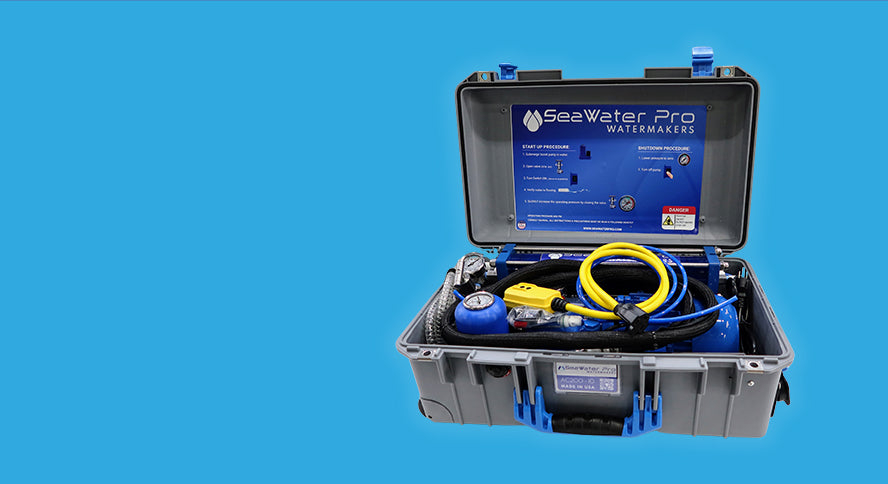
RV or BOAT?
Our mini watermaker has you covered!
Fast Express Shipping.
Industry Best Warranty!
Have a question?
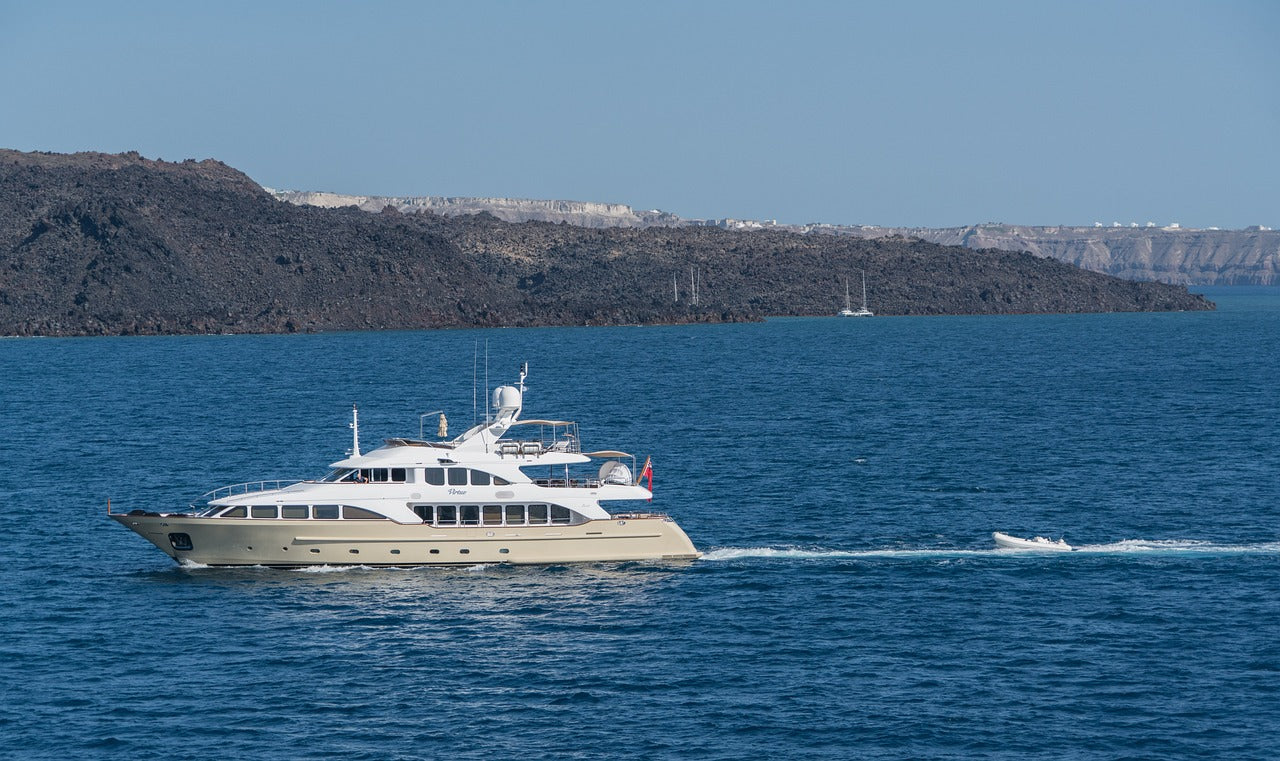
Modular Systems
Available in 17 to 40 GPH - Best for medium to large size vessels.
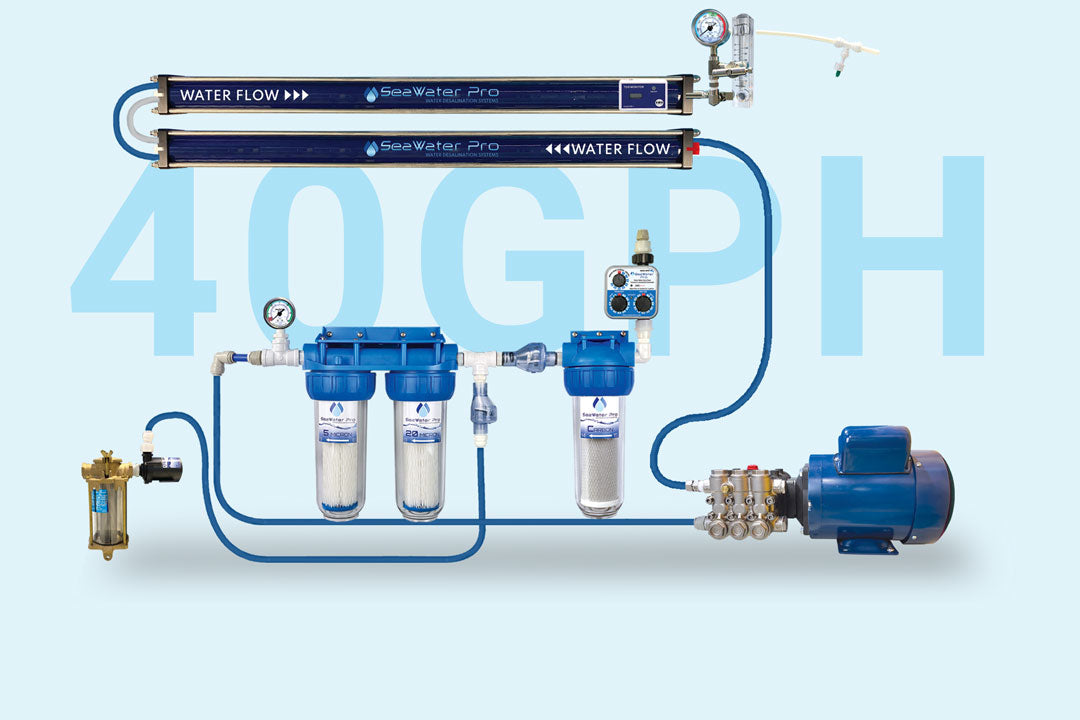
Watermaker: AC 110-220 Volt 970 Watts, 40 GPH Dual Membrane
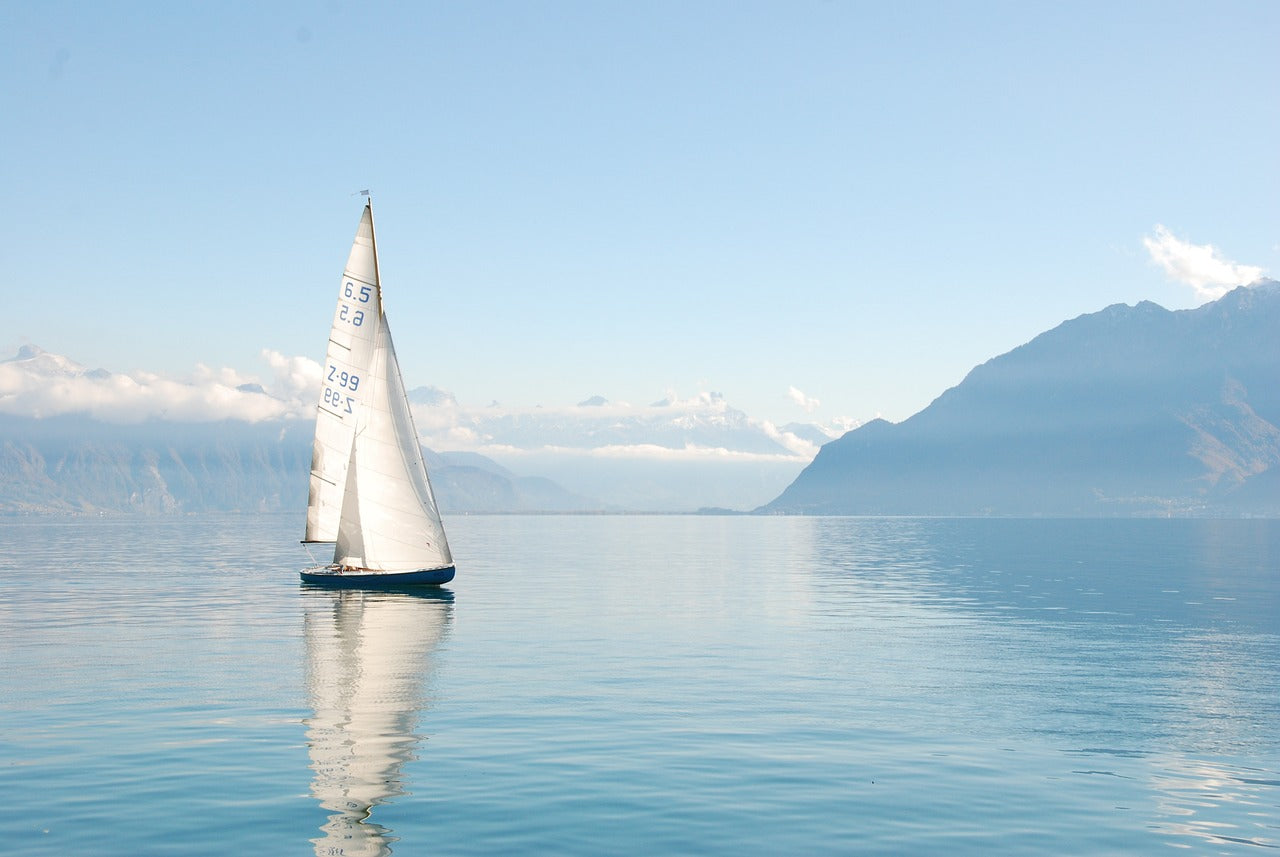
14 GPH - Best for small to medium size vessels.
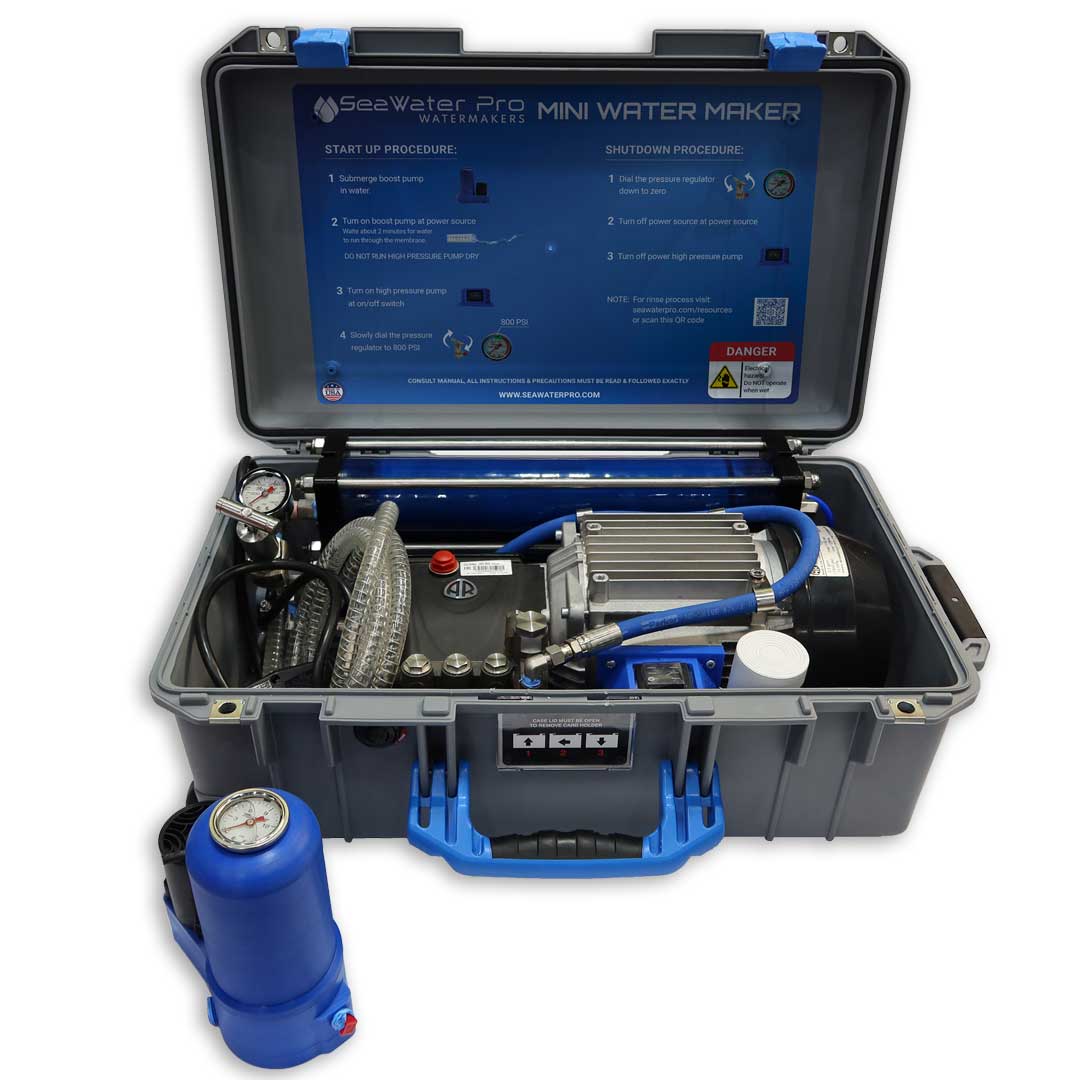
Mini Portable Watermaker AC Powered
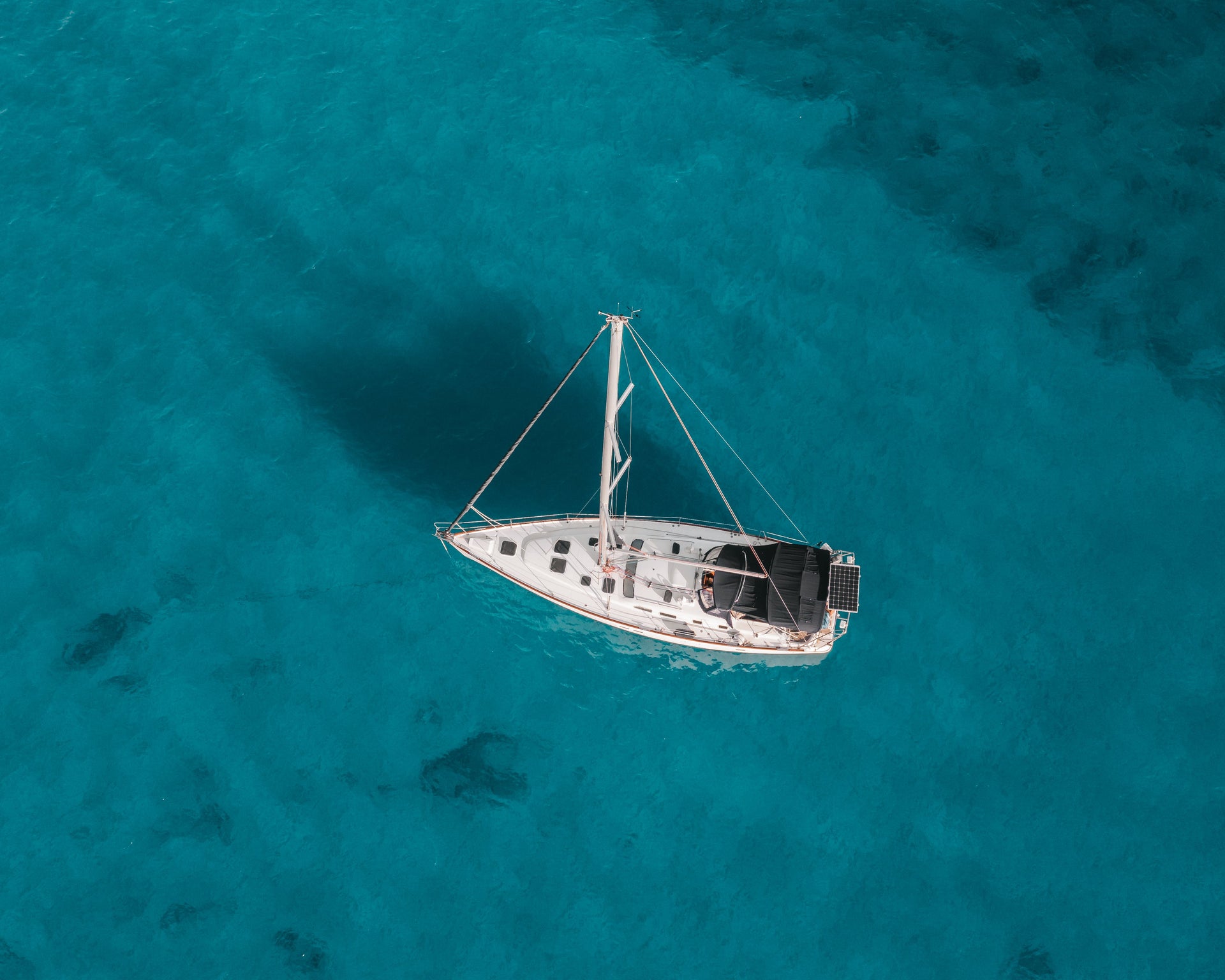
Compact Watermaker
30 GPH - Best for medium to large vessels with limited space.

Plug and Play Piranha 970W/30GPH (22"x16")
Top 4 most popular systems this month.
Looking for the latest and greatest in watermaker systems? Look no further than our Top 4 Bestsellers of the month! Our expertly curated selection features the easiest and most reliable systems to date!
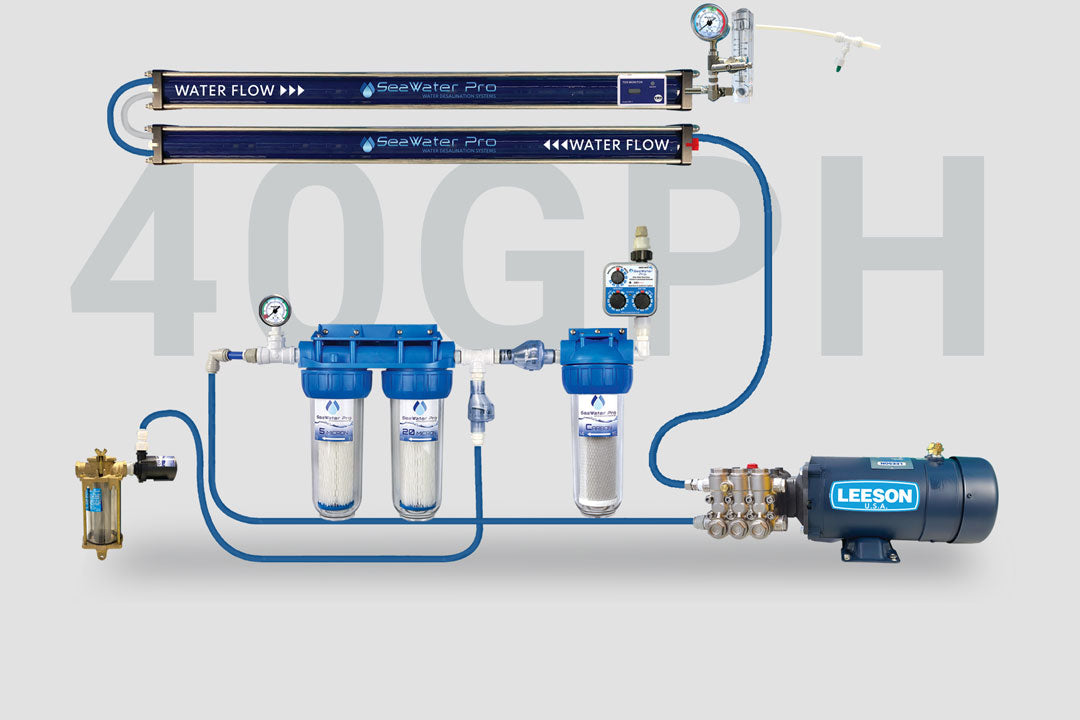
Watermaker: DC 24 Volt 900 Watts, 40 GPH Dual Membrane
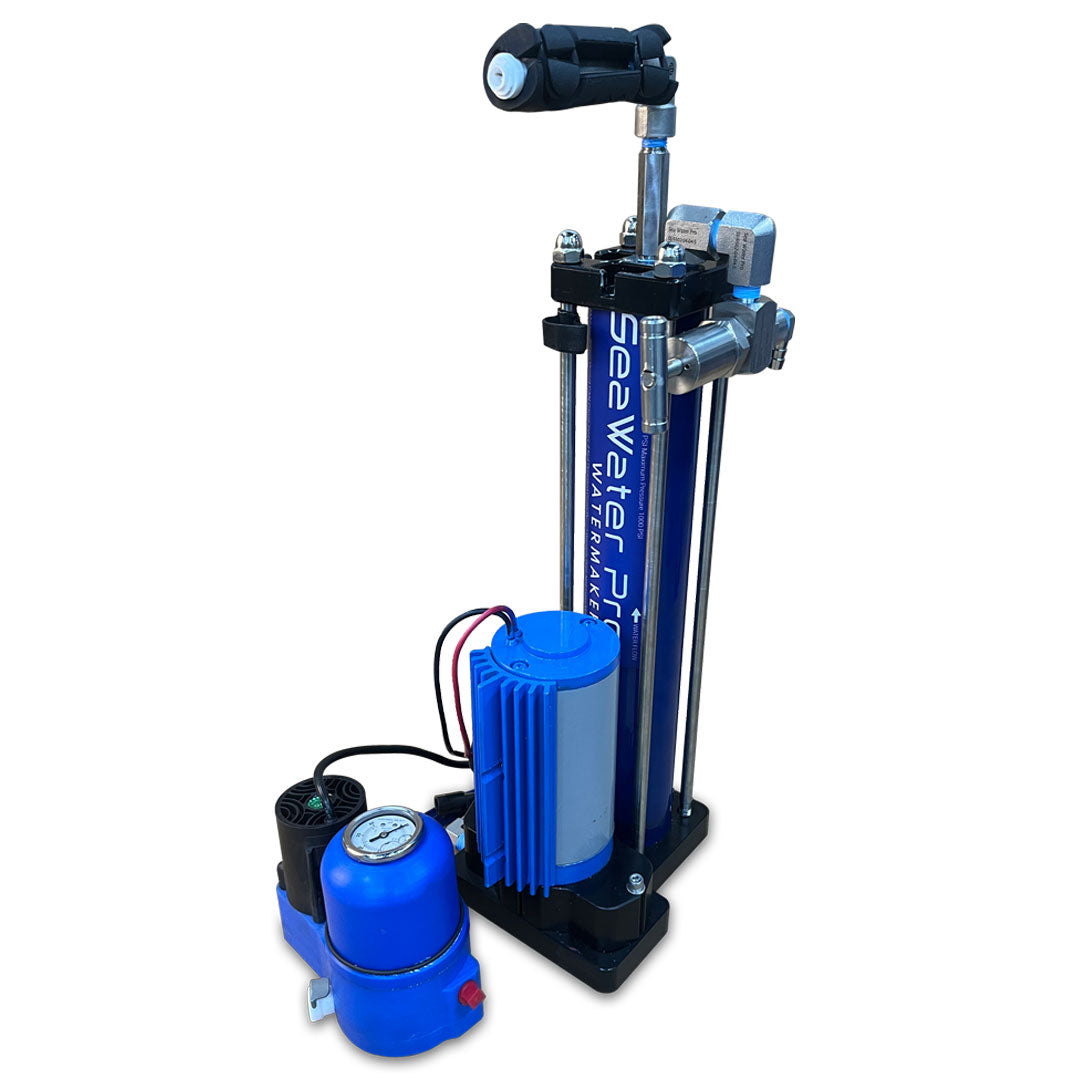
SeaWater Pro Micro Water Maker®
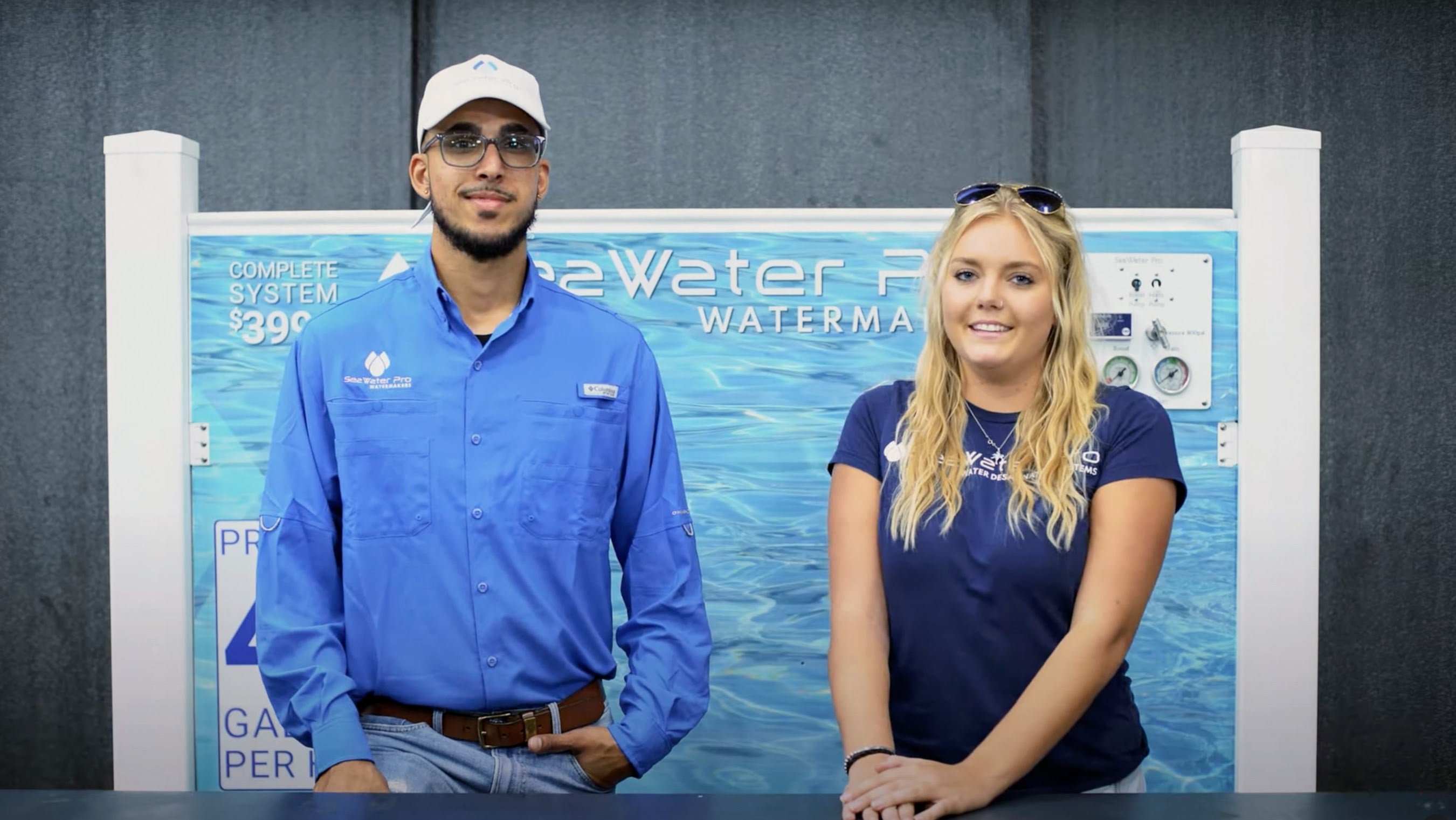
Quick Assembly Video
Swp modular & portable watermakers.
Welcome to SeaWater Pro, the premier provider of high-quality watermakers for boats and portable watermakers for all your marine adventures. Our cutting-edge technology and reliable products will ensure that you have access to clean, purified seawater wherever you go. With our easy-to-use and reliable watermakers, you can say goodbye to bulky storage tanks or worry about running out of fresh water. Our compact and efficient systems are designed specifically for marine use, making them perfect for boats of all sizes. Whether you're cruising the open seas or anchored in a secluded cove, our watermakers will provide you with a steady supply of fresh, drinkable water. At SeaWater Pro, we understand the importance of safe and clean drinking water while at sea. That's why our portable watermakers are equipped with advanced filtration systems that remove harmful contaminants and bacteria. Look no further than SeaWater Pro for your next, most reliable boating adventure investment!
Customer Installations Gallery
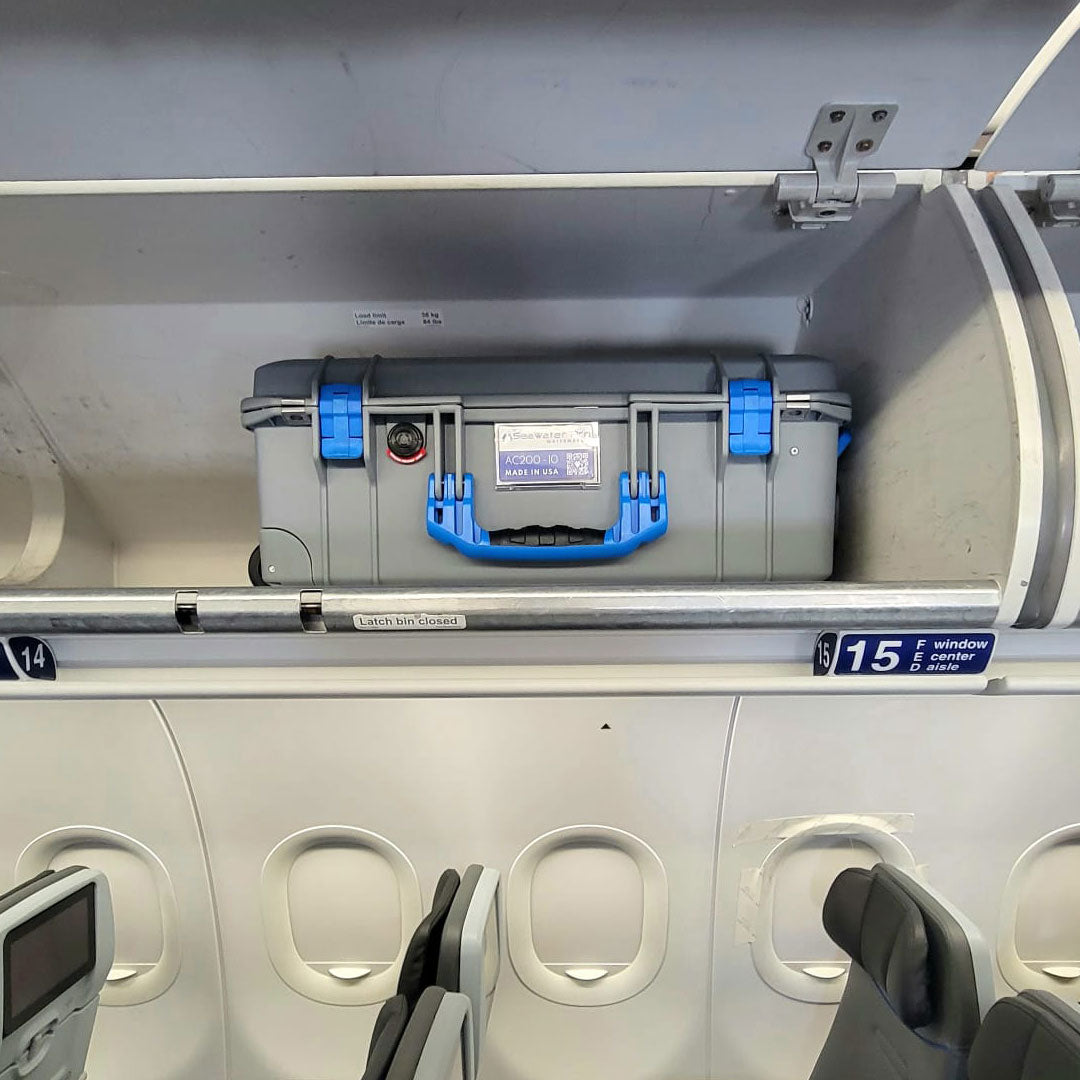
Latest Articles
Charting your course: your first steps into the exciting world of the sea industry, perks of staying hydrated with a portable watermaker while camping, prepping your boat for hurricane season with seawater pro, how do i know which seawater pro watermaker i'll need for my boat.
- Identifying which power source you'd like to run the system. AC or DC power?
- Determine how many gallons per hour will you need to maintain your lifestyle, 17 or 40 GPH.
How much does each SeaWater Pro System weigh?
Every modular watermaker ships in 2 boxes: The first Box is 48 x 12 x 12, 60 lbs. and the second is 24 x 12 x 12, 37 lbs.
Can I install a SeaWater Pro system myself?
Yes! We have videos and instructions for our customers on the resources page .
Do I need a control panel?
Do I need a control panel? Click to watch video
How do I rinse my system after I use it?
Rinse Timer Setup Guide Click to learn more about using your system's rinse timer!
How often do I need to pickle my watermaker?
How to pickle my SeaWater Pro system! Click to watch our short video guide.
Your Cart is Empty
But your water tank doesn't have to be :)
- Choosing a selection results in a full page refresh.

Desalination Watermakers:Making Water on a Boat
- Easily programmable and installed
- Portable and Modular Water Generators
- Lowers fuel consumption
- Energy efficient
- Convert seawater into fresh drinking water
NEWater: Desalination of Water Expert
Do your ships/yachts have desalination plants? If you are a sailor, working in the nautical industry, owning your own fishing boat/yacht, then you must be troubled by one thing: How to get potable water on board in an easy way? Marine desalinators can turn seawater into freshwater with one button. We have a wide range of high-quality desalination systems for boats that can support your business. Send us an inquiry today for professional desalination advice based on your vessel type and size!
NEWater Brings for You Yacht Watermakers & Marine Desalinators

We manufacture portable desalination units for boats that are compact are customizable for use on smaller vessels.

Our 12-volt marine water maker is suitable for general onboard freshwater production, which can effectively remove salt and other impurities in brine.

We manufacture small desalination units for boats that are easily programmable and simple to install, providing consumable and potable water.

Here at NEWater, we produce compact desalination plants for boats that provide fresh water for the people on board for all forms of use.

Our fresh water system for boats purifies and treats saline water by removing contaminants and salt, producing healthy usable fresh water.

Our reverse osmosis water maker marine uses advanced reverse osmosis technology to remove 99% of the pollutants in seawater.
Your Best Sailboat Desalination Solution Provider
NEWater makes sailboat desalination easier! We manufacture the highest quality seawater manufacturing machines for ships and yachts and guarantee the quality of the equipment. We rely on complete product testing to ensure that the quality of our marine desalination system products is stable and reliable. These devices can also be designed as modular, customizable components to suit your boat.
Our products are used worldwide in both commercial and domestic vessels, allowing these boats to be independent of large and bulky water tanks, thus reducing their fuel intake, while also increasing the quality of life on the vessel as it increases the availability of fresh consumable and potable water for a variety of uses.

NEWater Desalination System for Boats Details Display
1. Automatic operation, automatic cleaning. 2. Emergency stop button, professional electric control cabinet, water and electricity separation, safe and reliable. 3. Full polished stainless steel frame, safe and solid, elegant appearance. 4. High-quality coconut shell activated carbon filter, to remove odor and improve the taste of water quality. 5. Imported high-quality desalination RO membrane can remove salt, organic matter, bacteria, microorganisms, etc. The output water meets the drinking water standard. 6. All high-pressure metal parts are made of SS316 material, which can withstand 7MPA pressure, is safe, and anti-corrosion.
NEWater RO Technology
Reverse osmosis is a membrane separation technology driven by pressure difference, with high separation, no phase change, simple and efficient characteristics.NEWater adopts the world’s advanced and energy-saving and effective RO membrane separation technology, filtration precision 0.0001 microns. It can thoroughly filter out all particles of sediment, colloid, rust, bacteria and viruses, limescale, heavy metals, etc., with a removal rate of 97-98%, effectively avoiding secondary pollution. The water produced can be directly consumed, sweet and delicious.

NEWater Marine Desalination Systems Applications
NEWater’s desalination system for boats is designed to transform seawater into clean, healthy water suitable for direct human consumption. It is used in islands, individuals, sailing, yachting, fishing, disaster relief, etc. The equipment is small, easy to carry, less weight, and at the same time less costly to invest in.
We also offer suitcase desalination units that can be customized to your needs. Solar energy supply is optional, and the equipment uses energy recovery devices to fully reduce energy consumption.
Related Parts

NEWater Mission:Bring New Life for Water
- Manufacturing
- Product Details
- System Data Sheet
- More Products
NEWater has an independent large-scale production workshop, which is convenient for the control and supervision of product production quality. Strictly abide by production standards and provide detailed guarantees for all projects.
NEWater establishes SOP standardized operation process and strictly implements the work process. The professional project installation team, implement 5S on-site management. Equipped with standard safety facilities, investigating access conditions, and short construction time.
The safe transportation process does not have to worry about product damage and extends the construction period. NEWater has provided system equipment to thousands of companies around the world, which guarantees absolute product transportation.

How Long does the General Production Cycle Need to Wait?
NEWater’s treatment types of equipment are divided into a large system and a small system according to the water volume. The equipment is divided into portable water-making equipment, small modular equipment, skid-mounted equipment, and container-type equipment. According to different water volumes and customer requirements, we provide customized services.
Conventional small equipment takes 3-7 days, and large equipment takes 2-3 months. This is based on your requirements and water volume.
If I Need to Customize Equipment, What Data Need to be Provided?
- As the voltage and frequency of different countries are different, we first need the local voltage and frequency of electricity.
- How many gallons the water requirement per hour is
- The water quality of the source water and what requirements need to be met
- If you need to provide on-site installation services
Does the Equipment Need to be Installed On-site?
- Portable and small equipment — This is plug and play, it doesn’t need to be provided installation services. According to our instructions, you can install by yourself.
- Small modular equipment, skid-mounted equipment, and container equipment-we will reserve the interface for docking. If there are installation workers, we will provide installation instructions and installation instructions. If necessary, we can also send someone to install it.
- How to provide installation instructions —— We have installation instructions and installation videos. If necessary, we can provide free remote software to help you with remote video installation instructions.
How to Charge for Installation Service ?
- We provide free installation instructions, with instruction manuals and installation videos
- Remote video installation guidance. If it is a large piece of equipment and the customer needs to install it by himself, then we will also provide free remote installation guidance service, but we need to plan a good time, within our working hours. Our working hours are from 9 o’clock to 18 o’clock Beijing time
- We send workers to install it. This needs to be based on the size of the project. If we have been designated to install it in the early stage, the installation service abroad will belong to our scope of work, and no additional charge is required.
- If we need to send someone to install it temporarily, we need to provide different charges according to different countries, installation technical requirements, and different types of technical work. Welcome to inquire.
How to Transport the Equipment?
There are several types of transportation, sea, air, and express
- If it is a small device and requires fast speed, we can provide door-to-door service by air and express, the normal transportation cycle is 5-10 days.
- If it is skid-mounted or container equipment, it is more appropriate to use the shipping method. The normal transportation cycle is 20-40 days.
What ’ s Your Payment Method ?
Small equipment needs payment to delivery
For skid-mounted equipment and container equipment, 50% is prepaid, 30% is charged after video inspection, and 20% is charged before shipment.
Of course, we provide you with flexible ways of cooperation. Become our agents, and have more flexible support. Welcome to contact us.
D o You Provide Maintenance Services ?
Absolutely.
- NEWater provides free installation guidance and a one-year product warranty service. During the warranty service period, if there is an equipment problem, we provide free equipment repair or replacement services. If it is a manual operation, a fee will be charged. We can provide the required equipment replacement.
- We provide life-long after-sales service. NEWater has a full set of equipment and accessories, which can be replaced. Don’t worry about the failure of after-sales and maintenance.
- During the warranty period, NEWater provides all kinds of professional technical support, and if necessary. We also provide remote video guidance services.
- After the warranty period, NEWater also provides life-long after-sales maintenance, which requires a certain amount of manual service. There are also many matching accessories that can be replaced, so there is no need to worry about the later operation of the equipment.
Do You Provide Design Services?
Yes, we do.
For conventional small equipment, NEWater has standardized equipment. For large-scale skid-mounted and container equipment, we can design a process that meets the needs according to different water quality requirements.
At the same time, we carry out three-dimensional drawing designs according to different requirements and then communicate with customers to confirm.
After the design confirmation is completed, we then proceed to custom processing. So you don’t have to worry about our design and production capacity. We will provide you with the most professional technical support.
NEWater – Your Best Manufacturer of Desalination Systems for Boats
NEWater is your trusted marine water desalination systems manufacturer in China. We manufacture a complete range of desalination systems for boats for continuous services or heavy-duty within off and onshore applications.
Our desalination system for boats is manufactured with a compact design. It makes them suitable not just for boats but also for cruise ships, yachts, and resorts. The NEWater sailboat desalination is designed to produce fresh, clean drinking water from seawater. It also eliminates frequent marina stops in order to refill water tanks.
Our team uses reverse osmosis (RO) technology in the desalination machine for boats to treat any seawater source into safe, fresh water. As a result, it can be used for bathing, drinking, deck and exterior wash-downs, food preparation, and a wide variety of other uses.
There are many benefits of desalination systems for the boat could bring for marine applications. Some of the benefits are:
- great tasting water and beverages, high-quality
- carry less weight
- improve the quality of onboard
- improve boat maintenance
Whether you need a full-automatic or semi-automatic marine desalination system, NEWater desalination system manufacturer got you covered! We have a wide range of different varieties of desalination for boats that carry capacities ranging from 380 to 10,000 GPD.
The Ultimate FAQ for Desalination System for Boats.
Water travel is presently conducive and boundless thanks to desalination systems for boats. Carrying large water containers is a thing of the past as boat desalinators supply high-grade potable water on a need-basis. Their exploitation of seawater as the basic raw material translates to cost efficiency.
At present, they are the dominant freshwater source for yachts, fishing boats, cargo ships, and passenger ships. Underneath, we provide answers to your burning questions on boat desalination systems.

- What is a Desalination System for Boats?
- What are the Primary Features of Boat Desalination Systems?
- Which Processes are Used in Desalination Machines for Boats?
- What are the Benefits of Boat Desalination Machines?
- Where are Boat Watermakers Mainly Used?
- Are There Different Types of Boat Desalination Systems?
- What Considerations Should I Look at When Buying a Boat Desalination Machine?
- How Much Does It Cost to Desalinate Water Using Boat Watermakers?
- Do Desalination Machines for Boats Consume Much Power?
- What is the Maximum TDS Level of Boat Desalination Systems?
- What are the Advantages of Using Solar Boat Desalination Units?
- Is it Possible to Have a Personalized Boat Desalination System?
- What is the Production Capacity for Desalination Machines for Boats?
- What Percentage of Dissolved Salts is Eliminated by Boat Watermakers?
- What is the Role of Pretreatment in Boat Desalination Systems?
- Do Boat Desalination Systems Provide Drinking Water?
- Can Boat Desalination Machines Satisfy the Water Demands for Large Ships?
- What is a Turnkey Boat Desalination System?
- Where Should I Purchase Boat Desalination Systems?
- Do You Offer Delivery Services on Water Treatment Systems?
- Do Desalination Systems for Boats Have Warranty Protection?
- Does the Operation of a Boat Desalination System Require Skilled Labor?
- What Processes Can be Used to Polish the Product Water From Boat Watermakers?
- What Happens to The Brine Produced by Reverse Osmosis Boat Desalination Systems?
- How Durable are Desalination Machines for Boats?
- Where Can I Access Repair Services for Defective Boat Desalination Systems?
- What are the Limitations of Desalination Machines for Boats?
- Do You Offer Feed Water Testing Services?
- Which Payment Terms Apply to Boat Desalination Systems?
- Do You Provide Other Desalination Systems?
➣ What is a Desalination System for Boats?
A boat desalination system is a specialized water treatment unit deployed in water vessels to provide fresh water by desalting seawater. These systems make use of distinct desalination technologies to eliminate dissolved solids and other undesired elements from seawater. Consequently, a stream of high-quality water is generated to support distinct boat operations.
Boat desalination systems provide boat operators with a continuous supply of product water while consuming relatively lesser space. Customary boat watermakers are reliant on reverse osmosis technology, which is revered for its proficiency in seawater desalination.
➣ What are the Primary Features of Boat Desalination Systems?
The different types of marine desalination systems have distinctive attributes. Reverse osmosis watermakers , which are the chief desalination systems for boats, are characteristically dependent on semi-permeable membranes and pressure. Their maximum TDS level (often 35,000ppm) reflects the high salinity levels of seawater.
RO boat desalination equipment typically can operate unceasingly without diluting product water quality. For conventional water vessels, boat watermakers with a production capacity of 50 gallons per hour are employed.
➣ Which Processes are Used in Desalination Systems for Boats?
There are numerous desalination technologies for marine water desalination systems to exploit. Ideally, desalination is a multi-stage process that can utilize up to three different technologies. However, certain desalination processes are more suited to specific seawaters. Here we look at the distinct desalination technologies prevalently used in boat desalination systems.
Evaporation/distillation
By mirroring the natural course of rain formation, distillation water makers are able to provide fresh water for onshore and offshore applications. This process initiates the evaporation of water molecules through heating consequently condensing the vapor to generate potable water. Distillation takes advantage of water’s low boiling point to alienate freshwater molecules from dissolved salts and other impurities synonymous with seawater.
Reverse osmosis
Reverse osmosis is inarguably the most utilized and productive seawater desalination technology in existence. It is a membrane filtration process driven by pressure to enforce salt removal. The presence of pretreatment units in RO boat desalinators elevates their productivity scores.
Click on this link to watch a very informative video demonstrating the desalination processes employed by boats and ships.
➣ What are the Benefits of Boat Desalination Machines?
There has been a recent rise in the application of desalination systems for boats as water vessel operators seek alternative sources of product water. To users, the deployment of boat watermakers has been a pleasant revelation with nothing but positive implications. Underneath, we explore the rewards boat desalinator users are continually earning.
- They lessen the weight of the ship and create more space for vital use.
- With a boat watermaker, the voyage range is boundless.
- They consistently eradicate huge chunks of salt (up to 99.4%).
- The product water generated maintains the aesthetic value of the water vessel when used for cleaning.

➣ Where are Boat Watermakers Mainly Used?
The use of desalination machines for boats transcends various offshore and onshore applications. As the name suggests, boat watermakers are desalination systems specialized to gratify the potable water demands of water vessels.
However, their centralized and mobile nature permits their application in onshore applications such as homesteads and beach resorts. Their application in water vessels cuts across passenger ships, cargo ships, fishing boats, and naval ships.
➣ Are There Different Types of Boat Desalination Systems?
Thanks to innovation and customization, you have a variety of boat desalination systems to choose your ideal solution from. The differences in boat marine desalination systems are compounded by variations in designs, dimensions, and desalination technologies. NEWater’s comprehensive list of boat watermakers includes:
Reverse osmosis boat desalination units
This classification of boat desalination units is principled on the inherent desalination technology (reverse osmosis). RO boat desalinators employ membrane filtration to eradicate up to 99.4% of seawater-dissolved solids. They are massively prominent because of their high rejection rates and efficient energy use.

Evaporator boat watermakers
These units majorly rely on the process of evaporation to convert seawater to usable product water. They necessitate a heating source, which can be a solar panel, boat engine, or generator to initiate the evaporation process. Evaporator watermakers remove dissolved salts and are quite affordable to operate.
Additional types of desalination systems for boats are;
- Boat desalination skids.
- Solar boat watermakers .
- Modular boat desalination units.
Back to the guide ⇪
➣ What Considerations Should I Look at When Buying a Boat Desalination Machine?
We have discussed the distinct types of boat desalination systems and you are probably wondering, “How do I determine the perfect boat watermaker for my water vessel?” To make an informed purchase, you definitely need to grasp the technical aspects of boat desalinators or have a trusted expert to guide you.
At NEWater, we provide valuable information and technical assistance to aid potential clients to make the right purchase. Below is a summary of what you need to consider before buying a desalination machine for boat.

- The appropriate flow rate that matches the scale of your application.
- The configuration and concentration of your feed water.
- The quality of the product water your application desires.
- The desalination technology in use and power supply alternatives.
➣ How Much Does It Cost to Desalinate Water Using Boat Watermakers?
The collective cost of generating fresh water using marine water desalination systems encompasses numerous factors. Purchasing a boat watermaker is the first expense incurred. The different boat desalination systems command different prices given they bear varying specializations. For accuracy reasons, price quotations are provided upon inquiry.
The second variable in water desalination costs takes note of the operational expenses, which entail labor, energy consumption, consumables, installation, and maintenance. Although these variables keep wavering, the cumulative cost of desalinating seawater using an RO watermaker ranges from $0.70 to $1 per m3.
➣ Do Desalination Machines for Boats Consume Much Power?
Reverse osmosis machines in general, have had a reputation that depicted them as high-energy systems. However, the incorporation of energy recovery technologies is contributing to the development of comparatively power-efficient RO machines.
The magnitude and quality of the output from boat desalination systems is the primary determinant of power consumption. Customary reverse osmosis watermakers use 2.9 kWh/m3 to 3.6 kWh/m3 to desalinate seawater.
➣ What is the Maximum TDS Level of Boat Desalination Systems?
A TDS score is an indication of the total dissolved solids harbored by the seawater. Typical seawater exhibits TDS levels ranging from 17,000ppm to 35,000ppm hence boat desalination systems are specialized to accommodate the high TDS concentrations. Our boat watermakers normally have a maximum TDS of 45,000ppm and support upgrades of up to 50,000ppm given certain seas and oceans have very saline water.

➣ What are the Advantages of Using Solar Boat Desalination Units?
The adverse climatic change that has resulted in water scarcity and aridification is partly a consequence of fossil fuels. The universal adoption of solar energy is inspired by environmental conservation efforts and solar desalination has emerged as a cost-efficient solution to water shortage. NEWater provides both evaporative and reverse osmosis solar desalination systems for water vessels. The utilization of solar boat desalination units bears the following advantages.
- They are eco-friendly.
- The lower operational costs are given that solar energy is free.
- They are compact, lightweight, and portable.
➣ Is it Possible to Have a Personalized Boat Desalination System?
NEWater will provide you with a unique boat desalination system tailored to optimally gratify your unique demands. Whether you want a personalized power supply option, design, flow rate, or capacity, our engineers will deliver a precise solution.
Our proficiency in customized water treatment systems is evidenced by the over 2000 sales of customized systems we have made in the past 2 decades. Our customized boat watermakers are tailored to generate your desired product water quality and optimally desalinate your respective feed water.

➣ What is the Production Capacity for Desalination Machines for Boats?
The number of freshwater gallons produced in an hour or day (GPD) is the grading system used to grade the production capacity of boat desalination systems. The standard marine desalination systems have capacity ranges accommodative of small boats and high-volume water vessels.
Typically, regular boat watermakers have a production capacity of 50 gallons per hour. However, larger capacities are equally available. For larger water vessels, we manufacture boat desalination equipment with capacities of up to 3000 GPD.

➣ What Percentage of Dissolved Salts is Eliminated by Boat Watermakers?
Distillation and reverse osmosis processes are the primary desalination techniques utilized by boat watermakers. With reverse osmosis boat watermakers, 95-99.4% of the dissolved salts are removed. This is in addition to the vast amounts of bacteria, viruses, colloids, arsenic, and metals eliminated by the RO membrane filters .
Evaporator watermakers are equally proficient in removing dissolved salts. The desalinated water often depicts TDS levels of 1000ppm and below, which means the water is characteristically fresh.
➣ What is the Role of Pretreatment in Boat Desalination Systems?
Pretreatment is a preconditioning process used to reduce the corrosion threat and scaling effects of feed water. Reverse osmosis marine water desalination systems employ sediment and multi-media filters to eradicate seaweed, dust, and particulates big enough to clog the RO membranes.
A chemical dosing system is often utilized in boat desalination units to regulate the feed water’s pH, temperature, and turbidity. When water softeners are deployed, they eliminate water hardness hence mitigating the accumulation of scale on distribution pipes and the desalination equipment.
➣ Do Boat Desalination Systems Provide Drinking Water?
The quality of water derived from boat desalination systems customarily qualifies for use as drinking water for passengers and crew members aboard water vessels. The salinity concentration of desalinated water ranges from 300-1000 ppm, which is in alignment with recommended drinking water.

The deployment of a polishing procedure such as UV sterilization makes certain the product water is purified and fit for drinking. When remineralizing potable water destined for human consumption, the calcium and magnesium levels should be 30 mg/L and 10 mg/L respectively.
➣ Can Boat Desalination Systems Satisfy the Water Demands of Large Ships?
For large cargo ships and passenger ships, there are high-volume marine desalination systems, with daily capacity ranges of up to 3000 gallons per day. This is not the upper limit given that large reverse osmosis systems for boats are manufactured upon request.
Boat watermakers are assured to gratify the demands of large ships given they can run continually and desalinate water when the need arises. In addition, they generate water suitable for customary boat operations, human consumption, and utility applications.

➣ What is a Turnkey Boat Desalination System?
Turnkey boat desalination systems are automatic desalination units that are delivered to the point of use ready for instantaneous use. These boat watermakers are assembled and their primary components are interconnected at the point of production.
They rarely oblige installation and their ingenious design permits immediate application. NEWater’s turnkey boat desalinators are preprogrammed thereby reducing the demand for skilled labor. They have a small footprint and facilitate cost-saving.
➣ Where Should I Purchase Boat Desalination Systems?
In addition to quality products, buyers are ordinarily attracted to credible and transparent manufacturers/ suppliers. NEWater is one of the rare manufacturers that tick all the good boxes when it comes to the provision of boat desalination systems. Having manufactured and supplied over 9000 water treatment plants , we are a tried and tested manufacturer with a verifiable past.
We possess first-rate manufacturing equipment and exploit cutting-edge technologies to make certain our boat watermakers are resourceful, dependable, and cost-efficient. We have also adopted customer-centered services to elevate our clients’ shopping experiences. Use the contact details provided on our website to place your order today and enjoy exclusive discounts.
➣ Do You Offer Delivery Services on Water Treatment Systems?
Shopping from NEWater saves you the hassle of shipping your water treatment equipment thanks to our universal delivery service. As a renowned manufacturer of marine water desalination systems with a multinational clientele, we amply satisfy our customers’ demands by supplying our systems to over 200 countries.
By utilizing leading courier services, we manage to safely and promptly deliver your orders locally and abroad. The delivery of conventional boat watermakers averages 3-7 days when air transport is used while larger seawater systems average 2-3 months.
➣ Do Desalination Systems for Boats Have Warranty Protection?
Customers’ queries on product quality are often settled by trusted warranty policies. NEWater’s warranty protection policy is solely designed to reassure our clients of our boat desalination systems’ impeccable quality.
For a year after you have procured your boat watermaker, you can rest assured that any sort of mechanical mishap will be adequately catered for by the manufacturer. Ordinarily, our warranty policy does not provide for the mending of fabricated mishaps.

➣ Does the Operation of a Boat Desalination System Require Skilled Labor?
The operation of boat desalination systems is quite stress-free thanks to the use of uncomplicated user manuals. You can operate the boat watermaker by essentially understanding the attached user manual.
Turnkey marine desalination systems take a few minutes to prepare and get running. You can also request remote guidance from NEWater’s specialists. However, large seawater systems may necessitate a level of human input to oversee the continuous desalination process.
➣ What Processes Can be Used to Polish the Product Water From Boat Watermakers?
Although the grade of potable water generated by boat watermakers is ordinarily sufficient for numerous boat operations, an improvement in the quality is possible. For elevated microbial removal rates, ultraviolet sterilization can be incorporated as a post-treatment procedure of the RO permeate.
Post-activated carbon filters are also commonly utilized to polish product water from boat desalinators. They help reduce the chlorine concentrations in the permeate as well as eradicate VOCs, pesticides, and other objectionable chemicals.
The presence of CO2 and other dissolved gasses in the product water from boat watermakers results in elevated pH levels. Electrodeionization helps eradicate dissolved gasses as well as objectionable ionic pollutants.
➣ What Happens to The Brine Produced by Reverse Osmosis Boat Desalination Systems?
In desalination, the ejected contaminants are emitted as a concentrated solution referred to as brine in RO systems and concentrate in distillation systems. Special attention has to be accorded to this wastewater given reckless disposal could lead to water pollution and the destruction of marine life.
Recently, an efficient brine disposal method centered on reuse/recycling has been introduced. Due to the high salt concentrations, brine is utilized to produce useful chemicals such as hydrochloric acid. In other settings, the brine is first pretreated using wastewater treatment technologies before being discarded.
➣ How Durable are Desalination Systems for Boats?
Similar to typical desalination systems, boat desalination systems have life spans ranging from 15 to 20 years. In most cases, the difference between an underwhelming lifespan and an optimum one is attributed to maintenance and pretreatment practices.
The incorporation of a functional pretreatment process prevents premature damage of the RO membranes and also averts corrosion of equipment. Maintenance practices such as adequate cleansing thwart the accumulation of scales and contaminants on membrane surfaces. Consequently, this translates to extended lifespans and sustained optimal performances.
➣ Where Can I Access Repair Services for Defective Boat Desalination Systems?
NEWater is your all-inclusive manufacturer of boat desalination systems, repair components, and related products. We have a state-of-the-art production facility that empowers us to manufacture first-rate repair components for all our water treatment equipment.
In addition, we provide repair services to warranted boat watermakers and those that have expired warranty protection. In case of a malfunction, do not falter to reach out to NEWater for instantaneous action.

➣ What are the Limitations of Desalination Systems for Boats?
Boat desalination systems and other desalination systems at large have received criticism for emitting highly concentrated wastewater, which threatens marine life and the ecosystem. Additionally, boat watermakers discharge most of the seawater as waste. Only a small percentage of the intake water is converted into product water.
Investment and operational costs have perennially inhibited the widespread adoption of desalination units but recent innovations in energy recovery and membrane technologies have delivered solutions that are more economical.
➣ Do You Offer Feed Water Testing Services?
Prior to developing a water treatment solution for your project, our engineers need to comprehend the imminent feed water characteristics. To facilitate this, we have developed outstanding laboratories from which we undertake rigorous feed water testing.
Our water treatment systems are designed to offer unique solutions exclusive to the respective feed water and destined product water application. In instances where you are unable to access our feedwater testing services, we provide free technical consultations.
➣ Which Payment Terms Apply to Boat Desalination Systems?
Our payment conditions regulating payments for marine water desalination systems are constituted with the client in mind. You can settle the invoice on boat watermakers by making advance payments or opt for our installment plan. Typically, advance payments are obliged when the order is from a conventional small-sized boat watermaker.
Our favorable installment plan applies to high-volume water treatment plants. Essentially, you can make a 50% advanced payment, 30% post-inspection, and 20% before shipment. Moreover, we are open to discussing more flexible payment structures. For consultations on our payment terms, email our customer support team at [email protected] .
➣ Do You Provide Other Desalination Systems?
As a global manufacturer of water treatment systems with clients transcending various industries, we provide numerous desalination devices . Typically, we manufacture marine desalination systems suitable for distinct sources of feed water and varying application fields. Our desalination systems exploit different desalination technologies and often exhibit high desalination rates. Beneath is our diverse and high-efficient desalination systems.
- Seawater desalination systems.
- Desalination systems for homes .
- Industrial desalination systems.
- Commercial desalination systems.
- Brackish water desalination system.
There are many things to consider when choosing the right desalination for your boat. Nevertheless, our team, NEWater can help you find the right desalination system for your boat. Whether your boat is small or large, with a generator or without a generator, NEWater can handle the desalination system needed for your boat.
NEWater offers you a high-class desalination machine for boats guaranteed 100% high quality. We make sure that all of our desalination systems for the boat are delivered with reliable, durable, and long-life service. With NEWater, you rest assured that your desalination system for boats has the qualities to fulfill your market demands.
At NEWater, you can get a durable and compact design desalination machine for your boat. It allows easy installation in any size area. As a leading desalination system for boat manufacturers and suppliers in China, our team focused on designing marine desalination systems with many premium components. Our marine water desalination systems consists of the following:
- duplex SS centrifugal-type high-pressure pump (for corrosion resistance and high-performance)
- programmable computer controller
- 1000 psi fiberglass membrane housing
- High-quality seawater membranes
If your application requires commercial-grade water making or continuous-duty, the solution is very clear – NEWater! We are your efficient, extremely reliable, and budget-friendly desalination system for boat manufacturers and providers, based in China.
Let NEWater skyrocket your business! Contact us now!
Get a Quick Quote!
- Portable and Installed Watermakers
- FIND A DEALER >

- AC Electric
- Petrol (Gasoline)
- 12VDC Electric
- Control Panel
- Autoflush System
- Plumbing Install Kit
- Hydrotester
- Prefilter Cartridge
- Pickling Solution Mix
- Lift Pump Impeller
- RO Membranes
- High Pressure Hose
- Case Studies
- Testimonials
- Applications
- Desalination Theory
- Detailed Schematic
- Dealers List
- Dealers Map
- OEM Partners
- Troubleshooting
- Installation
- Manuals + Downloads
- Sales Enquiry
- Support Request
Fresh water anywhere
AC ELECTRIC, PETROL (GASOLINE), and 12VDC ELECTRIC WATERMAKERS. PORTABLE and INSTALLED MODELS AVAILABLE.
AC ELECTRIC , PETROL (GASOLINE) , and 12VDC ELECTRIC WATERMAKERS . PORTABLE and INSTALLED MODELS AVAILABLE.

no power source required
Petrol (gasoline) watermakers.

230V/50HZ or 115v/60hz
Ac electric watermakers.

12VDC power source
12vdc watermakers, rainman watermakers, a fresh approach to saltwater desalination. .

The Rainman Advantage

VERSATILITY
Rainman watermakers can be easily transferred between boats or used in remote land based applications. Keep your watermaker when you change your boat.

RELIABILITY
Partnering with the best companies for components, Rainman watermakers have a very high quality build, ensuring reliability and longevity of your investment.

LIFE CYCLE COST
With modest initial investment and components designed for durability and easy maintenance, the overall life cycle cost of a Rainman watermaker is kept to a minimum.

GLOBAL SUPPORT
A global network of over sixty dealers are in place to ensure you have support in the far corners of the world. Routine consumable parts are non-proprietary and easily sourced.
Eco – Friendly Solar Panel Desalination Systems

If there is one thing that boat owners may be interested in, it is using renewable energy to power the appliances on their boats. Not only is using sustainable energy like this better for the environment, but it could also help them save money on generators and diesel. One of the most popular appliances that are used on boats includes desalination systems. Being a popular appliance used on boats thanks to them being able to provide drinking water, many boaters could benefit greatly from solar panel desalination systems, especially if their boat stays in a sunny location. To learn more about this kind of watermaker for yachts , do not hesitate to continue reading below.
Benefits of a Solar-Powered Watermaker
There are many benefits to relying on solar power to power your appliances. For one, solar panels generate electricity without having to depend on fossil fuels. As mentioned before, this could translate to money saved on powering the desalinator on the boat. This is especially true for people that choose to adopt a live-aboard lifestyle, as relying on fossil fuels could present limitations to the lifestyle. A more detailed look at the benefits of solar-powered boat watermakers is seen below:
- Sustainability – Since solar-powered watermakers for boats use renewable energy, it is an environmentally friendly way to produce clean drinking water while minimizing harm to the ecosystem.
- Reliability – Solar panels are low maintenance and can last for many years, making a solar-powered watermaker a reliable source of freshwater for boaters.
- Ease of use – A solar-powered watermaker is easy to operate, with simple controls that require minimal maintenance or repair.
- Portability – A solar-powered watermaker can be lightweight and portable, making it an ideal solution for boaters.
- Healthy – Drinking clean and safe water is essential for good health, and a solar-powered watermaker can help ensure that boaters have access to safe drinking water, especially in remote areas where fresh water may not be readily available.
What Are the Best WaterMakers for Sailboats?
When it comes to people that own sailboats, solar panel desalination is one of the most popular options for them. The fact that sailboats rely on wind, a renewable source, to power them, is a very attractive feature to those looking to become more sustainable within their boating hobby. Desalinators are an essential part of boating long-term and one that is solar-powered may be the best option for sailors.
Can You Power a Boat With Solar Panels, Including the Watermaker?
Yes, you can power a boat’s onboard systems, also known as auxiliary or house systems, with solar panels. Many boats use solar panels to generate electricity for various onboard systems and appliances, making them more self-sufficient and eco-friendly. Solar panels are installed on the boat’s deck, roof, or other suitable surfaces to capture sunlight. These panels consist of photovoltaic cells that convert sunlight into electrical energy. Later, this converted electricity is used to charge a battery, which is later used to power a watermaker. For boaters looking to create freshwater through environmentally friendly means, solar panels are a great option for you.
Can a Solar Panel Charge a Marine Battery for Desalination Systems?
For certain watermakers, like our DC watermakers for yachts , charging a battery is a top consideration. Marine batteries are normally the kinds of batteries that need to be charged to power a watermaker, so it is only natural for someone to ask themselves if a solar panel could charge a marine battery. Marine batteries, such as deep cycle batteries, are commonly used to power various electrical systems on boats, including lights, navigation equipment, radios, and more. Solar panels can provide a renewable and eco-friendly way to charge these batteries when the boat is not in use or when the engine is turned off. Furthermore, both small boats, larger water vessels, and industrial desalination systems can use solar panels.
How Can Boats Be Eco-Friendly Using a Desalinator?
Boats could be eco-friendly by using a desalinator if they make an effort to power it through wind power or solar power. To illustrate, many sailboat desalination systems will use diesel-powered engines to run a desalinator, which is both dangerous for the environment and costly because you need to keep on replenishing your supply. We are proud to offer eco-friendly boating equipment to our customers because we are passionate about the ocean and its conservation.
How Effective Is Solar Desalination?
Solar desalination could be extremely effective because of the quality of our machines. With a battery-powered boat watermaker or home watermaker, you can enjoy constant water as long as you have access to plenty of sunlight. The effectiveness of solar desalination is highly dependent on environmental conditions. It works best in regions with abundant sunlight, such as arid and sunny coastal areas. The efficiency of solar desalination systems can be negatively impacted by cloudy or overcast weather conditions. Many people also use solar panels as an auxiliary to regular means of powering a boat or home.
What Are the Advantages of Using an Eco-Friendly RO Water System?
Eco-friendly boating equipment is a top concern for recreational and commercial boaters alike because they are inherent stakeholders in the ocean. Being a good steward of the environment promotes boating and makes sure that future generations enjoy it.
More About ECHOTec Watermakers
ECHOTec Watermakers is one of the top purveyors of solar panels that make water and solar panel desalination systems on the market. We also make an effort to provide other kinds of marine desalination systems for boaters that want to make drinking water from salt water. Visit our online store or contact us today to learn more about our home desalination systems and other boat desalinators for sale.
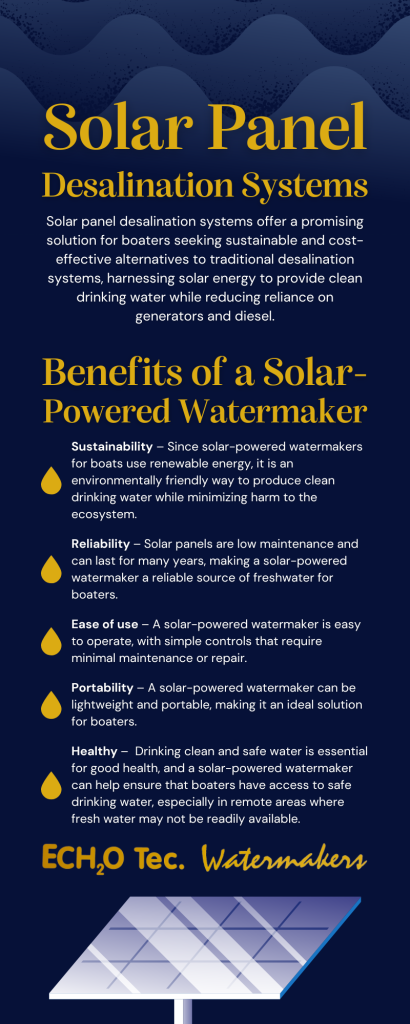
- Work & Careers
- Life & Arts
- Currently reading: Wave of innovation aims to make desalination sustainable
- US housing market belatedly wakes up to flood risk
- Is public or private ownership better for water utilities?
- Climate change puts pressure on Kenya’s water resources
- Space agencies race to find water on the moon
- Climate investors see growing opportunities in water tech
- Brewers come under pressure to minimise water footprint
Wave of innovation aims to make desalination sustainable

- Wave of innovation aims to make desalination sustainable on x (opens in a new window)
- Wave of innovation aims to make desalination sustainable on facebook (opens in a new window)
- Wave of innovation aims to make desalination sustainable on linkedin (opens in a new window)
- Wave of innovation aims to make desalination sustainable on whatsapp (opens in a new window)
Gill Plimmer
Roula Khalaf, Editor of the FT, selects her favourite stories in this weekly newsletter.
In the grip of a three-year drought, the Spanish city of Barcelona announced last month that it would have to start supplying its 1.6mn inhabitants with water brought by boat from a desalination plant in the nearby Valencia province from June this year.
Shipping water by sea is an expensive solution — as is the desalination process that distils the water. But the decision underscores the severity of the drought. Now, Catalan authorities are planning to double the region’s capacity for desalination over the next three years.
Spain is not the only country to view desalination as a potential solution to water shortages. Although just 1 per cent of the world’s water currently comes from desalination, governments in the US, Egypt, Morocco and Italy all have plans to expand plant capacity.
“The big advantage of desalination is that seawater is plentiful and it’s usually available where fresh water is needed most,” says Christopher Gasson, owner of information provider Global Water Intelligence — noting that demographic growth is fastest in the world’s coastal mega cities. “Almost every other source of drinking water is ultimately dependent on enough rain falling in the right place,” he points out.
Saudi Arabia, which already obtains 70 per cent of its water from desalination, is expanding production while, in the US, the Biden administration has allocated $250mn to desalination projects. In Egypt and Morocco, renewable-powered plants that can produce drinking water and irrigate crops are being built.
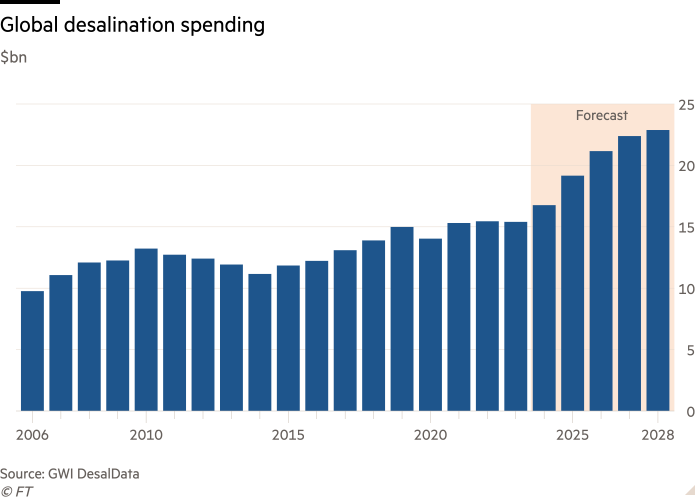
There are downsides. Desalination is an energy-intensive process, which has mostly relied on fossil fuels. And dumping its super-salty brine byproduct back into the sea can pose a risk to marine life, environmentalists warn. This is particularly true if antiscalants and cleaning chemicals are discharged with the brine.
However, a wave of innovation is starting to make desalination plants more environmentally friendly and cheaper to power in sunny and water-stressed areas. According to GWI’s research, desalinated seawater production will rise from 45mn cubic metres per day now to 61mn cubic metres per day in 2027 — enough to supply 400mn people per day.
There are already 186 facilities under construction, or in their design phase, mostly in the Middle East and north Africa, according to GWI. The two regions currently account for about half of all the world’s desalinated water production and are investing billions in new infrastructure.
Energy accounts for between one-third and just over half of the total cost of desalinated water
Even in the much wetter UK — which nevertheless suffered droughts in 2022 — utility company South West Water has one desalination plant on the Isles of Scilly, and is planning another in Cornwall, with the aim of supplying customers by December 2024. Thames Water, the country’s largest water provider, also has a desalination plant, though it has mostly not been used because of high energy costs.
Energy accounts for between one-third and just over half of the total cost of desalinated water. But Gasson says the availability of low-cost solar power is driving a revolution in the industry. On February 29, a Saudi developer closed the financing of Dubai’s Hassyan desalination plant at a record low tariff of $0.36 per cubic metre — a feat made possible by the availability of solar power in the emirate priced at less than $0.02 per kWh.
Now, competition between Gulf states to reduce the cost of desalinating seawater further is hotting up. Last year, Saudi Arabia’s Saline Water Conversion Corporation launched a $10mn global prize for Innovation in Desalination. This was topped on March 1 this year by the announcement that the UAE’s Mohamed bin Zayed Water Initiative had provided $119mn to support the XPrize Water Scarcity competition.
The main focuses of innovation, Gasson says, are new materials for the membranes that filter out salt, improved integration of renewable energy, digital systems for monitoring and control, the recovery of valuable minerals such as lithium and rare earth metals from the brine stream, and better control of membrane scaling and fouling. Recent breakthroughs include new self-cleaning membranes that prevent the accumulation of scale.

Companies are hoping to find multiple ways to make desalination more efficient without boosting carbon emissions. UK-based Core Power, for example, is developing nuclear-powered offshore plants, while Canada-based Oneka is harnessing wave power for floating desalination units.
Others, such as Norway’s Flocean Desal, are designing desalination technology that can work on the seabed, which, it argues, reduces impact on the marine environment and is less energy-intensive.
But not everyone is happy with the drive towards desalination. Many believe it should be only a last resort, and that conservation, recycling, and capturing stormwater are better options. That applies in Barcelona, too, where Greenpeace has called for better water management policies.
Fernando Fernández of Greenpeace, in Catalonia, says: “We need policies that reduce our consumption in large sectors such as agro-industry and tourism, instead of continuing with business as usual.”
Promoted Content
Explore the series.

Follow the topics in this article
- Water scarcity Add to myFT
- Natural resources Add to myFT
- Gill Plimmer Add to myFT
International Edition
Applications: Yachts | Commercial
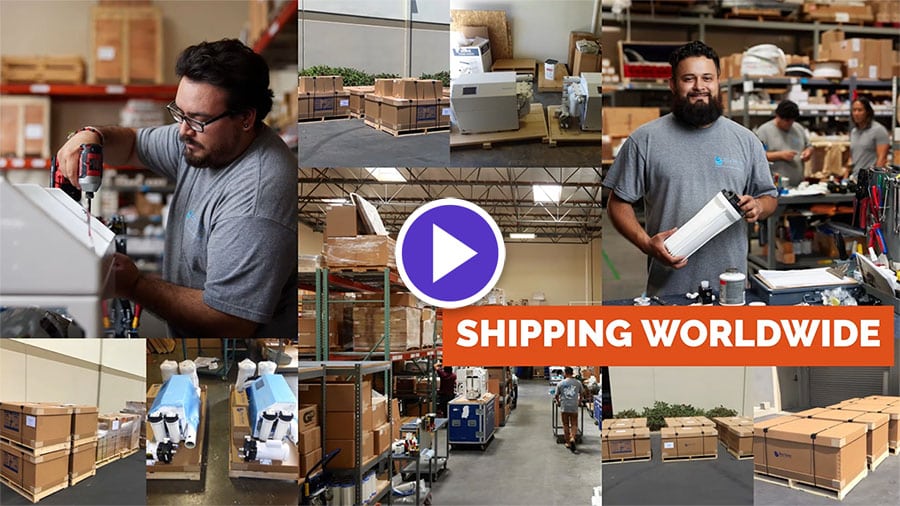
Celebrating Our 10th Anniversary
We are grateful for all those who have allowed us to surpass our goals through the decade!
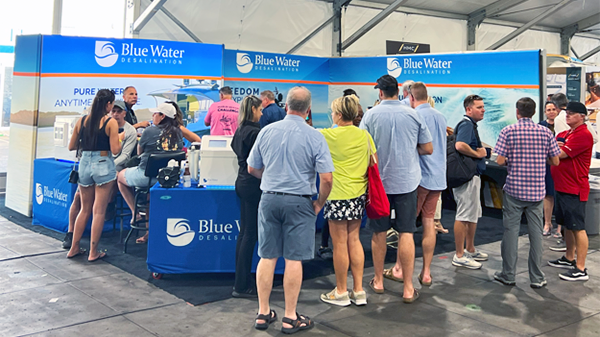
Upcoming Boat Shows
See the Newest Watermakers on display at a boat show this winter!
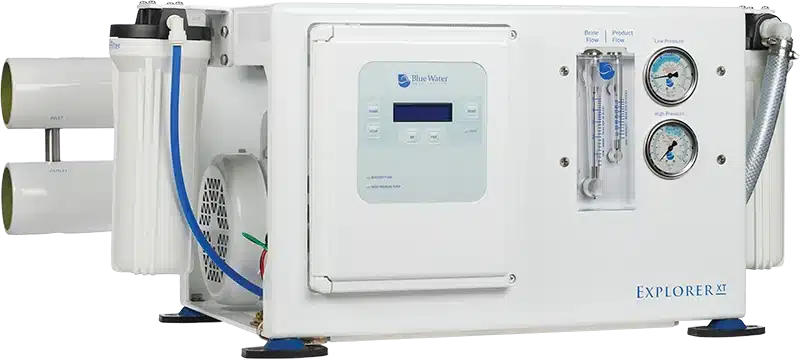
NEW! Explorer XT
Fully-Automatic & offered in multiple configurations
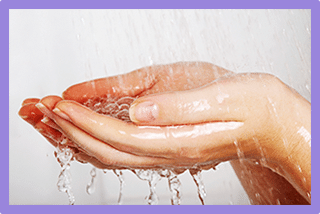
Pure Water.
Anytime, Anywhere.
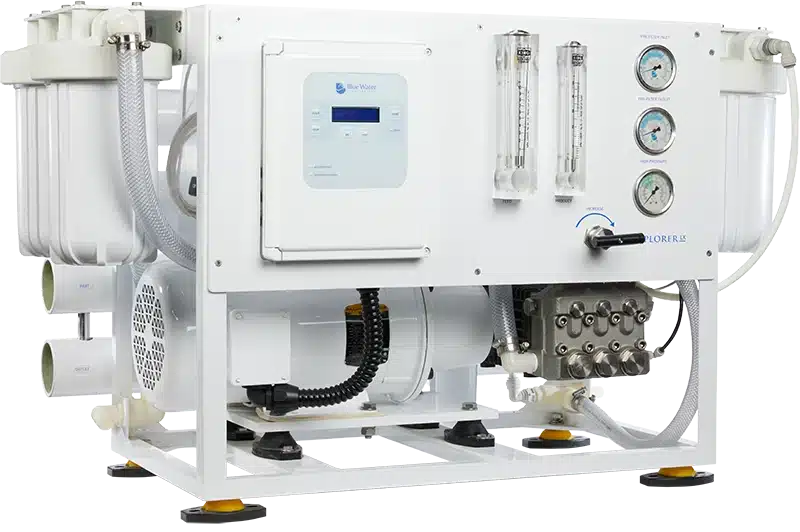
Commercial Systems
Cutting-edge desalination systems now available for commercial vessels.
Learn About our Company and Innovative Watermakers Now
Dealer Inquiries Welcome!
Marine Desalination Systems
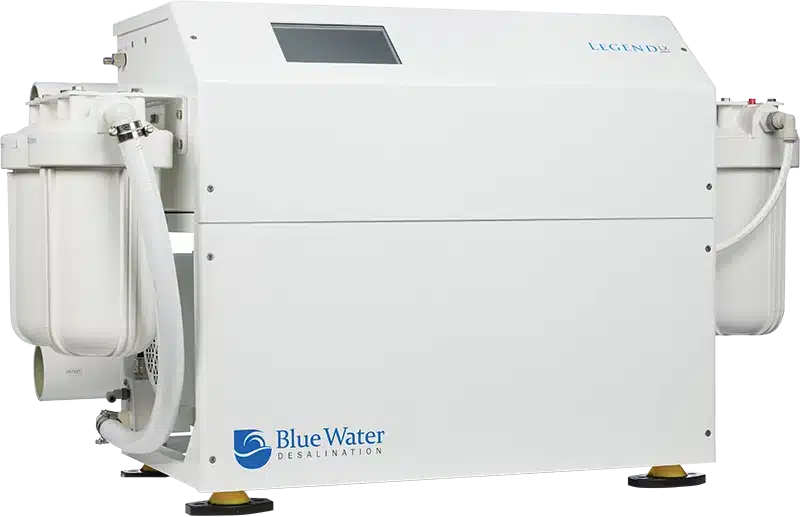
Fully Automatic Megayacht Watermaker

Explorer LX
Semi-Automatic Commercial Grade Watermaker
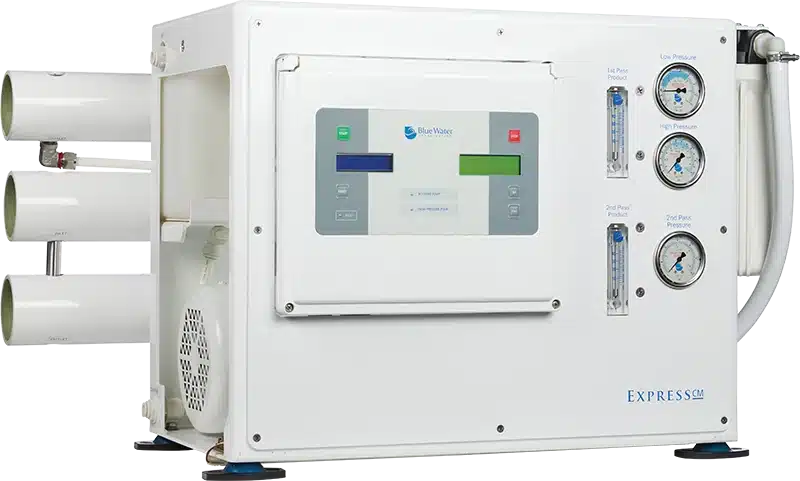
Express ClearMate
Ultra-Pure Water for any Vessel from dock or seawater
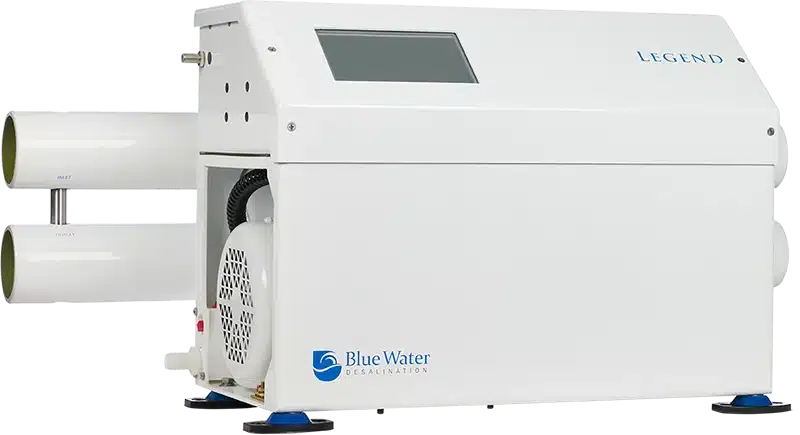
Fully Automatic with Capacities Ranging from 475-1850 GPD

Explorer XT
Fully Automatic Available in Compact, One Piece Modular or Two Piece Modular
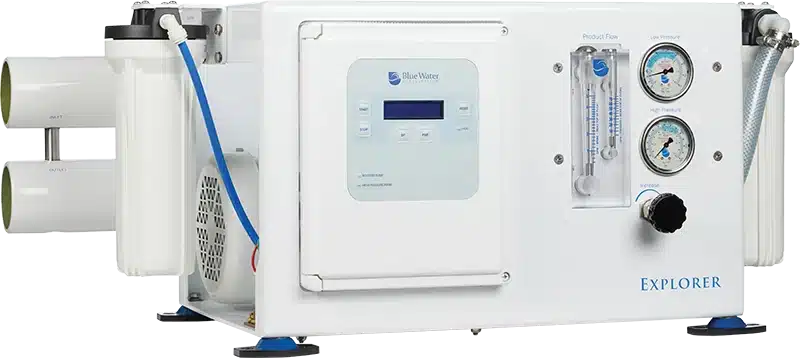
Semi-Automatic – 475-1800 GPD
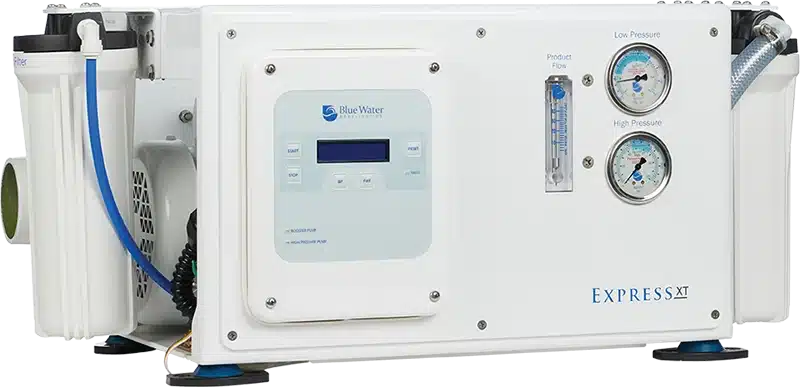
“Set It and Forget It” One Touch Operation
Express XT DC
Fully-automatic operation available in 12V, 24V & 48V
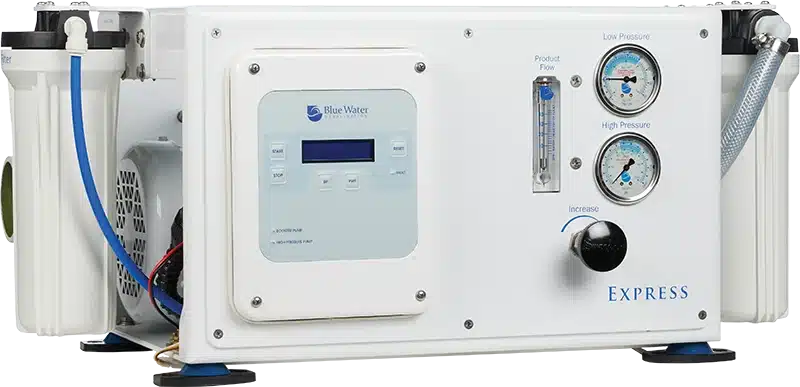
Semi-Automatic – 200-800 GPD
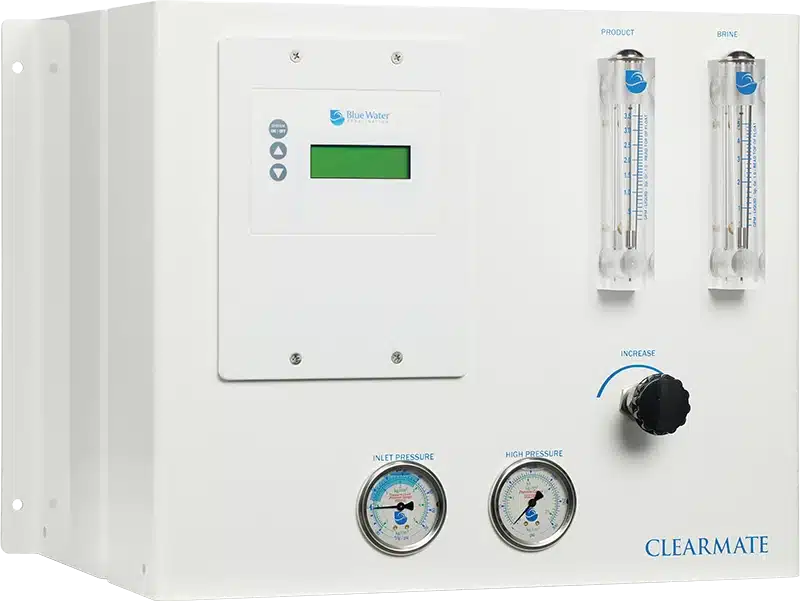
Efficient Fresh Water Filtration System

ClearMate Mobile
Portable Fresh Water Filtration System
Spec Out a Watermaker Today
Superior water production begins with analysis of your requirements and equipment, but it’s easy to get started!

COMMENTS
Since all of the watermakers that are currently available for cruising sailboats use this process for desalination, the major differences between the systems are how you power the high-pressure pump and the user interface. Powering options include 120/220-volt AC, 12- or 24-volt DC and engine/belt driven. All have their pros and cons.
Our sailboat water maker gave us the gift of time, especially in places like Mexico and the South Pacific, where there were limited opportunities to fill water tanks up at the docks. ... Powered desalination systems for your average recreational cruising boat range from around 3,500 USD to 11,000 USD, with the more expensive options offering ...
Spectra Katadyn PowerSurvivor. As a compact and energy-efficient watermaker, the Spectra Katadyn PowerSurvivor is arguably the most affordable watermaker currently available on the market. We are talking about a model that only requires 4 amps to desalinate water for your sailboat.
The EXPRESS CLEARMATE combines two of Blue Water Desalination's efficient watermaker systems into one convenient package. This compact unit produces ultra-pure water from either seawater or dock water with the touch of a button. Rated production from seawater ranges from 750 to 1,800 GPD (2,480 LPD to 6,810 LPD) and from 1,000 to 2,600 GPD ...
How to install a DIY watermaker: https://youtu.be/BOdRNNPina0***Update 2021/11/16***It's been over two and a half years since we installed our watermaker. It...
Katadyn-owned Spectra produces a wide range of watermakers, from the hand-operated Survivor 06 to a commercial AC model capable of producing 10,000 gallons per day. The most suitable units for cruising yachts are its DC/AC-powered Ventura, Catalina and Newport models, offering production rates of between 6.3 and 41gph.
How Does Sailboat Desalination Work? The way that a watermaker works is quite interesting. The steps are the following: Seawater is taken in from the ocean through a pump or gravity system. The seawater is passed through a pre-filter to remove large particles such as sand, sediment, and other debris.
6. Storage requirements. Water storage is an important consideration for any boat owner using a desalination system. Four key points to consider when it comes to water storage requirements for a desalination system on a boat are the water demand, available space, water quality and required maintenance:
Contact the Rainman team should you have questions about our marine desalination systems. Rainman Watermakers are beautifully made, can be portable, partly or fully installed, and make up to 140 litres of water an hour. Fast, worldside delivery.
Maintenance: Like any other marine appliance, a boat water desalination system will require a degree of maintenance that could be time-consuming. This includes cleaning and replacing filters, and periodic professional servicing. Space: Marine desalination systems take up space on board the yacht, so you'll need to make sure you have enough ...
Here are three of the highest-rated RO filter systems on the market. 1. Seawater Pro Reverse Osmosis Desalinator and Watermaker. The best modular water filtration unit available for boats is the Seawater Pro three-membrane system. This all-in-one marine water purification machine is designed for medium-sized sailboats and powerboats.
2. AMPAC USA SeaPro Saltwater Desalination RO Watermaker. Able to produce 100 gallons per day, this watermaker was designed for use on small power boats or sailboats. Its super quiet automatic operation features intuitive controls that let you start and stop the desalination process with the push of a button.
The three most common ways of obtaining fresh water on a cruising boat are: 1) an effective rain collection system, 2) from shore via a hose, or 3) a watermaker. Given reasonable storage capacity and a good filtration system, a high-capacity watermaker is the most efficient — especially if you are a boonies cruiser.
Interested in installing a watermaker / desalinator on your boat, but don't want to shell out the big bucks? Step 1. Watch this video. Step 2. Stop by Sail...
Designed for customer installation and ultra-reliable performance, far from factory-trained service centers, the wide product range covers modular AC, DC, and belt-driven watermakers from 8.4 GPH / 32 LPH to self-contained desalination systems with a production of 14.000 gallons or 53.000 liters per day. More than 5,000 ECHOTec desalination ...
Rainman Watermakers are solid, robust portable desalination systems designed for the extremes of a maritime environment and built with ingenuity, with the most popular of our systems needing only a small portable generator to operate, and our gasoline systems being completely independent and backed by the global and prestigious Rainman Honda ...
When you're on a boat in the middle of the ocean, no fresh water is accessible at all. Fortunately, you're surrounded by water and technology exists to make that water usable. Desalination and Aristotle. The technology isn't new. Aristotle described a desalination technique in the 4 th century BC in Meteorologica. There's even a mention ...
Access to continuous production of freshwater while on a boat by means of a desalination system like reverse osmosis is a prime solution to many of the inconveniences water tanks impose. This process is one of the most effective methods of supplying freshwater onboard. A desalinator will save the weight and space of water tanks while producing ...
Welcome to SeaWater Pro, the premier provider of high-quality watermakers for boats and portable watermakers for all your marine adventures. Our cutting-edge technology and reliable products will ensure that you have access to clean, purified seawater wherever you go. With our easy-to-use and reliable watermakers, you can say goodbye to bulky storage tanks or worry about running out of fresh ...
A boat desalination system is a specialized water treatment unit deployed in water vessels to provide fresh water by desalting seawater. These systems make use of distinct desalination technologies to eliminate dissolved solids and other undesired elements from seawater. Consequently, a stream of high-quality water is generated to support ...
Rainman Watermakers are a compact system designed to generate a fresh potable water supply from seawater. They can be installed in a minimum footprint configuration or kept portable for maximum flexibility. We use only top quality components in the build process from the best manufacturers: Honda, General Pump, Filmtec, and Noshok. Our filters ...
To illustrate, many sailboat desalination systems will use diesel-powered engines to run a desalinator, which is both dangerous for the environment and costly because you need to keep on replenishing your supply. We are proud to offer eco-friendly boating equipment to our customers because we are passionate about the ocean and its conservation.
However, a wave of innovation is starting to make desalination plants more environmentally friendly and cheaper to power in sunny and water-stressed areas. According to GWI's research ...
Cutting edge reverse osmosis desalination systems for the marine industry. Cutting edge reverse osmosis desalination systems for the marine industry. Watermakers. ... Discover Boating Miami International Boat Show; Join Us at METS in Europe at the SuperYacht Pavilion; Locate a Dealer. Find a Certified Blue Water Desalination Sales or Service ...